ANNIN

A N Illustr A ted H I story








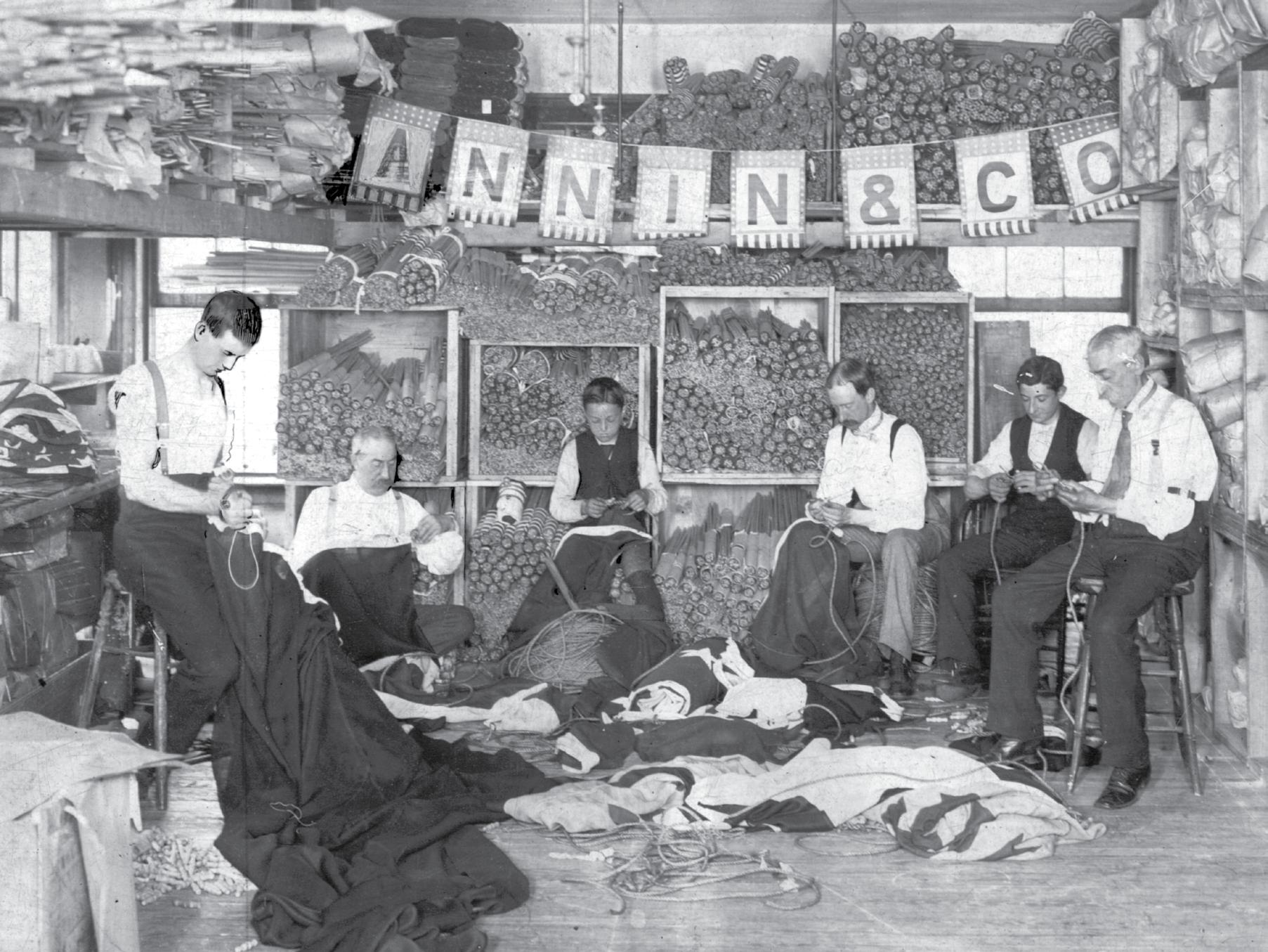

Annin Flagmakers: An Illustrated History
© 2013 Annin & Co., Inc. All rights reserved.
ISbN: 978-0-9847338-1-1
Printed and bound in the united States of America. No part of this publication may be reproduced or transmitted in any form or by any means, electronic or mechanical, including photocopying, recording or any information storage and retrieval system now known or to be invented, without permission in writing from Annin Flagmakers, 105 Eisenhower Parkway, Suite 203, Roseland, NJ 07068 (telephone 973-228-9400; www.annin.com), except by a reviewer who wishes to quote brief passages in connection with a review written for any media.
Produced and P ublished by CorporateHistory.net LLC, Hasbrouck Heights, NJ
www.corporatehistory.net
Written by Marian
Calabro
What is written is remembered.
design and P roduction by Christine Reynolds, Reynolds design and Management, Waltham, MA, cover and interior
Printed by J.S. McCarthy Printers, bound by Acme bookbinders, with Adobe Garamond Pro and Myriad typefaces, using Creator Silk text, Forest Stewardship Council Mixed Sources Certified Paper
P hotogra P hy credits appear on page 94, which constitutes a legal extension of the copyright page.
All trademarks and servicemarks and registered trademarks and servicemarks used herein are the property of their respective owners.
F ront co V er : Annin’s Fulton Street building, early 1900s; Verona, 1950; South Boston, Virginia, 2013.
P re V ious s P read : Splicing rope for code signals at Annin’s original location, 99–101 Fulton Street in New York City, were (left to right): an unnamed employee, John Annin, Charley Wilt, Louis Annin Ames, Barney Rosenberg, and Edward Annin. The photo was probably taken shortly after Louis joined his uncles at the company in 1896.
right : Production of U.S. flag stars using a state-of-the-art Epoca machine at Star Fields, Annin’s embroidery subsidiary in Cobbs Creek, Virginia.
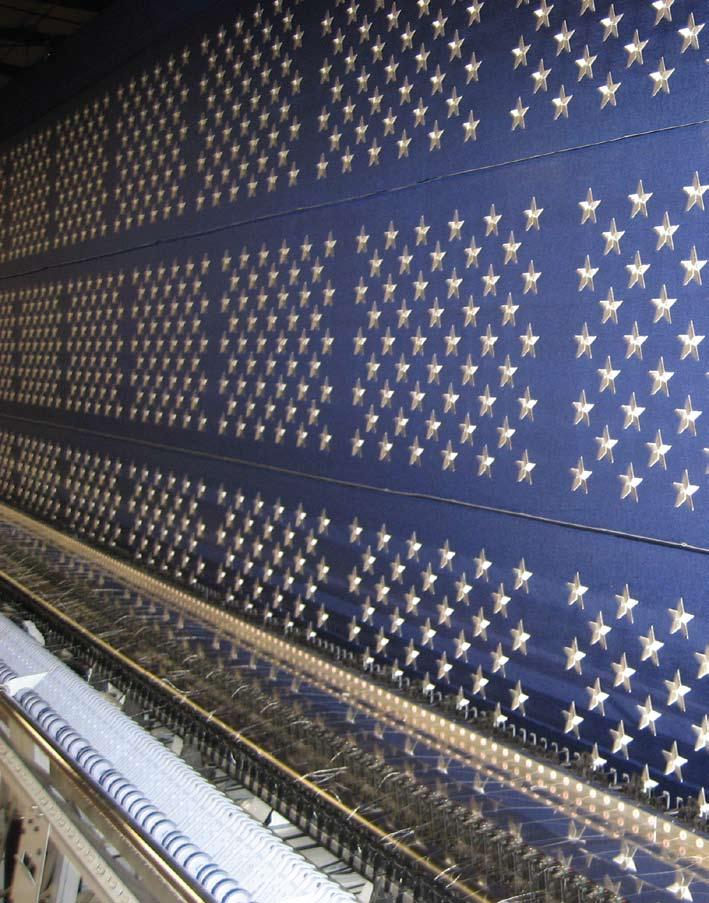

america would have been a poor show had it not been for the scots.
Andrew Carnegie, Scottish-born industrialist
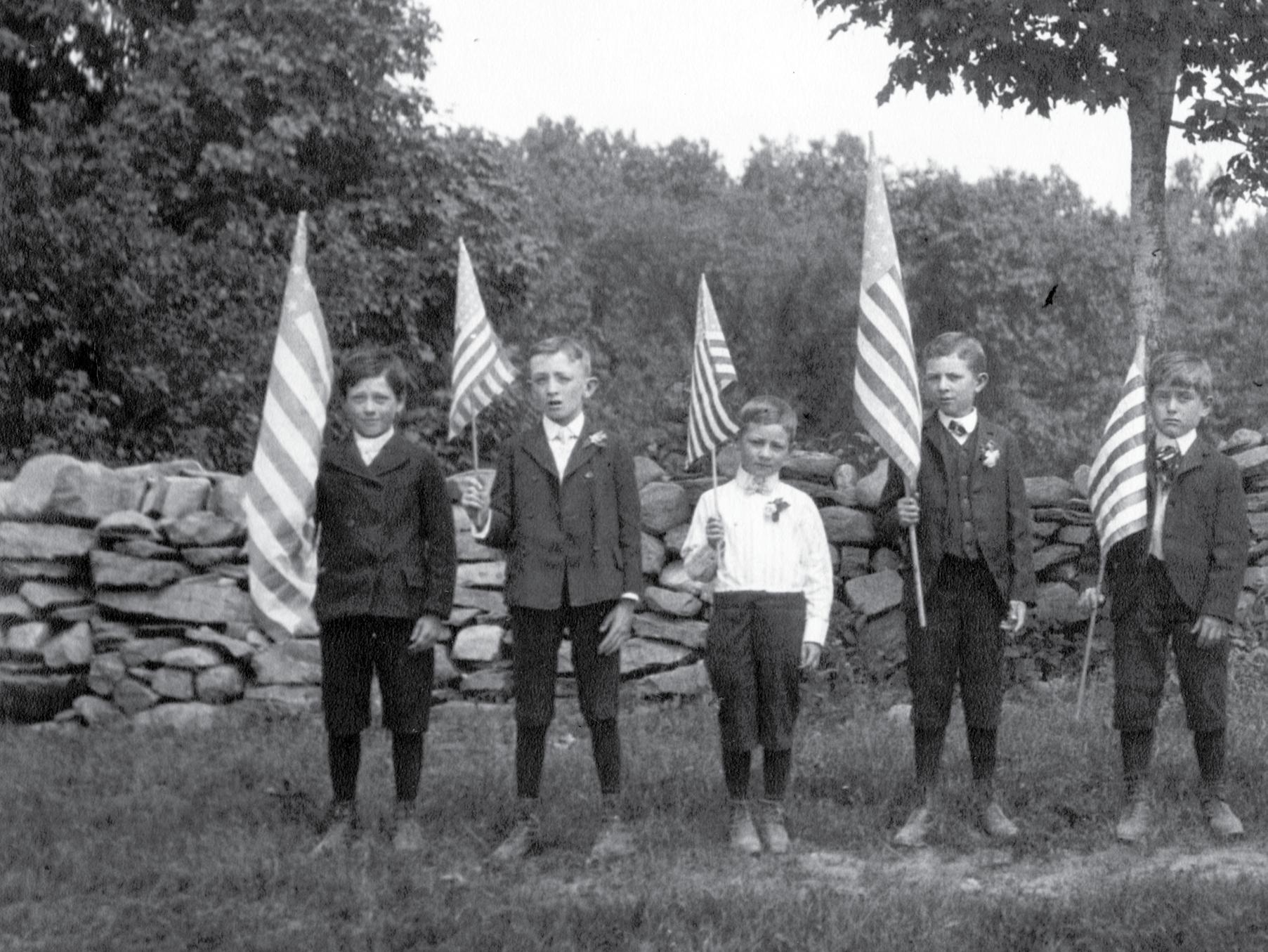

c ha P ter one annin’s roots, 1710–1896

the history of Annin & Co. begins in spirit with the birth of John Johnston, the family patriarch who came to America ten generations ago. Literally and figuratively, his dNA lives on in the company today. Although the details of his life are scarce, they reveal traits that distinguish his descendants and the business they created: industriousness, a sense of civic duty, and the ability not only to see opportunity but to act on it.
John was born in Annandale, a district in southeastern Scotland named for the river Annan. The area is famous as the ancestral home of Robert the bruce, the 14th-century king fictionalized in the Academy Award-winning movie Braveheart, filmed partially in Annandale.
John’s birth year, 1688, figures prominently in Scottish history. It marked the end of the 50 years’ Rebellion, a bloody religious conflict. The rebels were the Covenanters, who were persecuted for challenging the King’s belief that he, not God, was the spiritual head of the Scottish church. “The tenacity and the sacrifices of the Covenanters ensured that we today enjoy civil and religious freedoms,” declares the Scottish Covenanter Memorials Association, a current-day organization. Similar battles over the separation of church and state in England would lead to the colonization of America, culminating in the American Revolution—a war in which John’s New Jersey-born sons and grandsons would proudly take part.
We do not know which side the Johnstons supported. At least one historian believes John’s father was the Marquis of Annandale; if this is true, the Johnstons were nobility and thus probably would have backed the King. What we do know is that John emigrated to the united States in his teens or 20s, and that he married a Covenanter named Elizabeth. Possibly theirs was a “mixed marriage” that drove them into exile from their families and their home country.
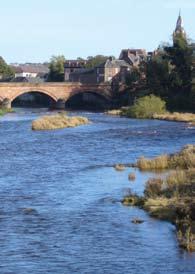
abo V e : Annandale, Scotland, the Annin family’s ancestral home.
o PP osite : These boys, whose names are unknown, were probably members and friends of the Annin and Palmer families. The location was most likely Schooley’s Mountain, New Jersey, where Louis Annin Ames’s stepfather Solon Palmer owned a summer home.
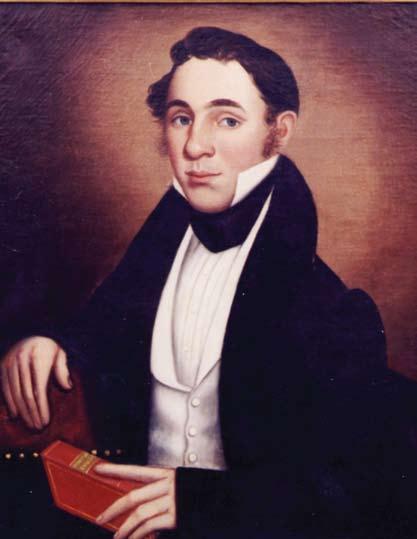
cloc KW ise : William Annin, 1820. He was the grandson of the William who built the Old Stone House in 1766, shown in a 1964 photo and a painting circa 1850. The house, since torn down, stood on 2,700 acres in Bernards Township, New Jersey. William Annin Middle School now occupies part of the property.
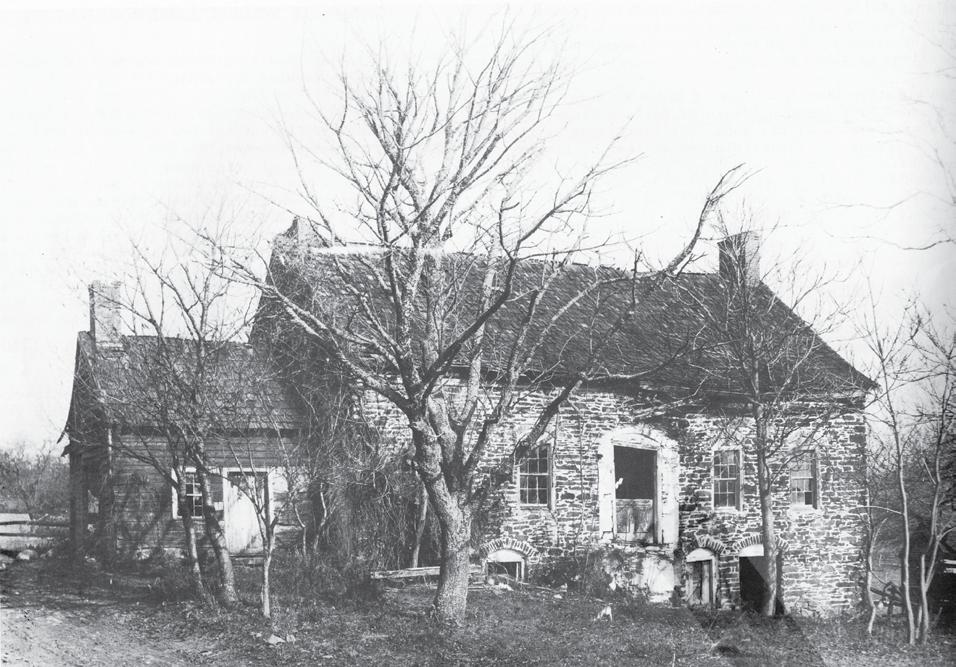
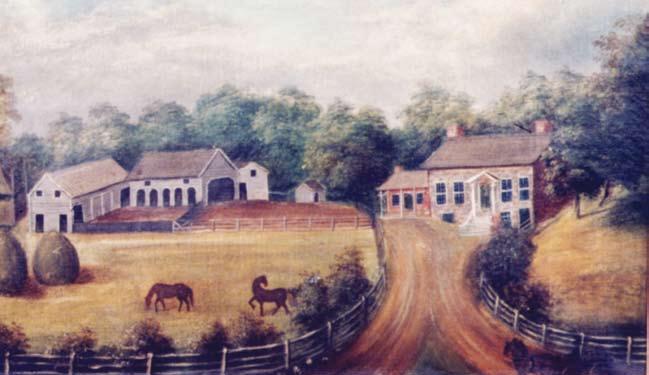
Property records show that the couple settled in what is now the Liberty Corner section of bernards township in Somerset County, New Jersey. Nominally under british rule, New Jersey had already attracted many Scottish emigrants. No doubt they appreciated both its tradition of religious tolerance and its fertile farmlands.
Whether John Johnston voyaged to America in search of religious freedom, increased opportunity, or both, he prospered here. In his new country he adopted a name from the old one: whether accidentally or on purpose, he became John Annan. Within a generation, the spelling by most family members would change to Annin.
John and Elizabeth bought 270 acres from heirs of the Pennsylvania settler William Penn. They built a log cabin on their land, soon known as Annin’s Corner. The couple raised at least five children, the most significant being William.
William Annin, born in 1715, grew up to serve in the New Jersey legislature. He purchased at least 2,700 acres of land, including the part of bernards township where William Annin Middle School stands today. At age 51 he built a solid stone house on his estate. Carved into its cornerstone was the date, 1766, and the initials W.A. and H.S.M., standing for William Annin and Hugh Sunderland, Mason (the man who did the stonework). John lived to witness his son’s prosperity and to see his son’s elegant stone house. The patriarch would survive to age 81—an amazing life span when most Americans were lucky to live to 40, and a harbinger of the longevity that runs in the family.
In company history, however, 1766 is most significant not for the stone house but for the birth of Alexander Annin, the youngest son of William and the father of the Alexander Annin who founded Annin & Co. The elder Alexander is also notable for having married Margaret Miller, a great-granddaughter of Jonathan dickinson, founder of the College of New Jersey, which became Princeton university. A clock from the dickinson era, engraved with the name of the oldest son in each generation, has been handed down through the centuries to Cameron Randolph beard II, current chairman of the board. Another of the family’s oldest artifacts is an 1820 portrait painting of William, the older brother of the company’s founder.
Having increased their land holdings in Somerset County throughout the 1700s, the Annins didn’t seem inclined toward city life or the merchant trade. but then as now, New york beckoned to ambitious young men who sought more activity than rural life might offer. Such a striver was the younger Alexander Annin, who opened a ship chandlery at 99 Fulton Street in lower Manhattan in 1820. He was 23 years old, the third son in a family of 11 children, but he seems to have been the sole proprietor.
A young man couldn’t have picked a better time to launch a business devoted to nautical supplies and equipment. The first section of the Erie Canal, the shipping highway between the Hudson River and Lake Erie, had just opened in 1819. upon the canal’s completion six years later, New york became the gateway for goods traveling from the populous East to
As this art by Currier and Ives indicates, New York harbor in the 1800s provided plenty of customers for the nautical supplies and canvas sold by Alexander Annin’s chandlery.
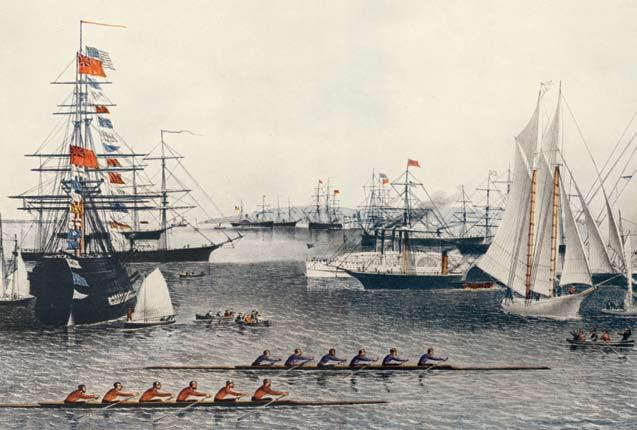
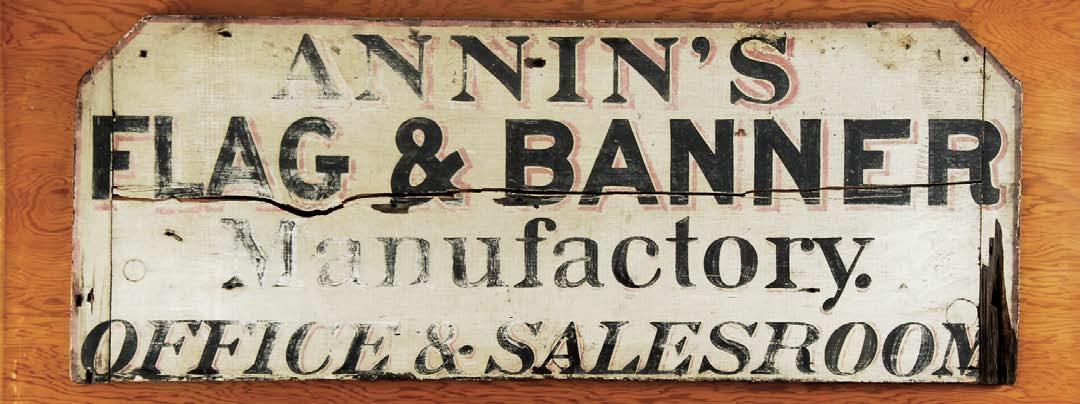
the Midwest. Its ports also got busier as immigrants sailed from other parts of the East Coast and, increasingly, from Ireland and Germany. by 1840
New york would become the world’s largest port—and the great Irish immigration after the potato famine of 1846 hadn’t even begun. In short, not until the transcontinental railway was finished in 1869 would there be a domestic mode of long-distance transportation that rivaled shipping.
Ship chandlers deal mainly in hardware—rosin, rope, wax, varnish, and the dozens of tools used by sailors—as well as sou’westers and other nautical clothing. Perhaps from the very start of the chandlery, Alexander also sewed flags and supplied them to ships. His grandson Louis Annin Ames, who would lead the company well into the 20th century, told America First magazine in 1940 that Alexander “had, as a nautical flare [flair], the making of flags for the shipping industry.” Louis was nine years old when his grandfather died, and they lived in the same neighborhood in
Jersey City (possibly in the same house), so it’s likely he heard Alexander’s memories and the family’s “shop talk” firsthand.
Alexander’s sons are the ones who developed the flagmaking aspect. Alexander turned the business over to them when he was only 50 years old. “At the time of his retirement from active business, in January 1847, his two older sons, Edward and benjamin, founded the house of Annin,” Louis Annin Ames confirmed in the America First article.
Edward and benjamin were just 15 and 13 when they started the flag business within their father’s existing business. They were young, but most boys went to work full-time at 12 or 13 in that era. Not surprisingly, their father kept a strong hand in the management at least for the first few years.
Phebe Annin Ames Palmer—Alexander’s only daughter, who would live to age 103—confirmed to the Newark News in 1938 that “in his leisure time [Alexander] used to sit at the shop while the young men, joined after a
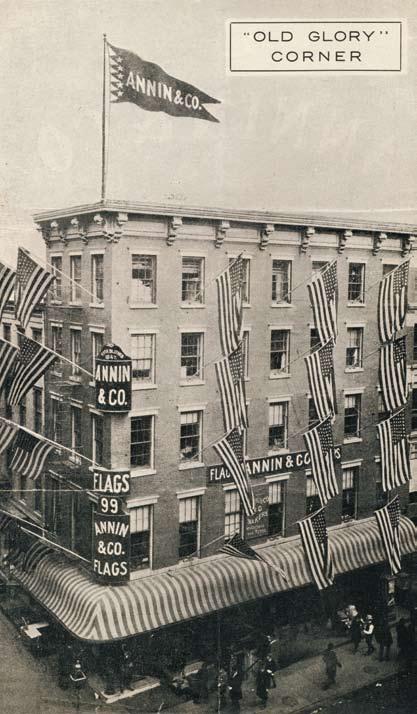
while by a third brother, John, went out to solicit the business that was to develop into the largest of its kind in the world.” John, five years younger than benjamin, would join them in his adolescence. The painted wooden sign on the company’s front door left no doubt as to its new focus: “Annin’s FLAG & bANNER Manufactory. office & Salesroom.” Preserved under glass, it now hangs in the reception area of the headquarters in Roseland, New Jersey.
Since Alexander lived to age 75, he probably didn’t retire for reasons of health. From what was then the relative seclusion of Jersey City, he devoted much time to politics. According to his obituary in The New York Herald, “He was a firm Jeffersonian democrat” who “although declining all offices which were frequently tendered him . . . took a deep interest in the success of the party.” The newspaper also noted that the Annins were “men of superior intelligence [and] the most sterling honesty.”
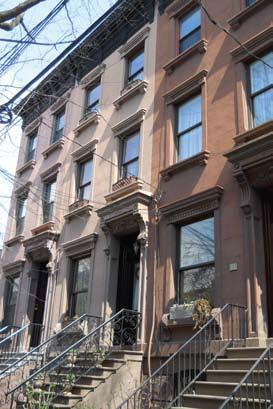
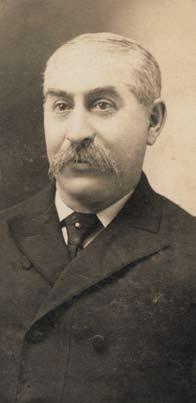
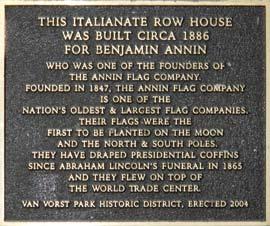
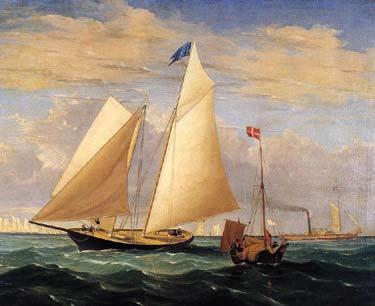
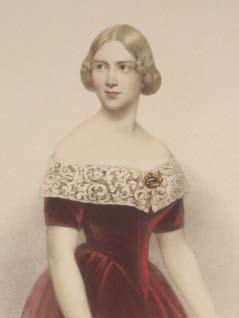
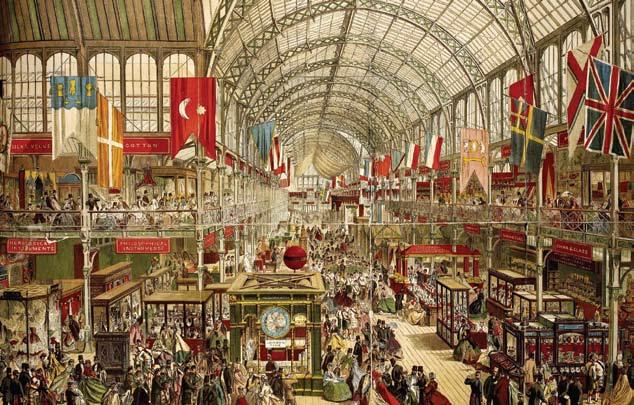
annin & co. grows rapidly
Like their father, the Annin brothers had ambition to spare. They took over at a crucial time—the united States had been fighting a war against Mexico for several months, and Annin became the supplier of flags to the fighting army. The company’s reputation for quality and service obviously spread to other federal government buyers, because Annin won a prize commission: flags for the inauguration of Zachary taylor as President of the united States in 1849. (The company has had the honor of supplying every presidential inauguration since.) The following year it provided flags for concerts by Swedish singer Jenny Lind, who drew hundreds of thousands of listeners on a national tour produced by the showman P. t. barnum.
Annin-made flags had probably circled the world on ships since the chandlery days, but in 1851 the company won a major international client, Queen Victoria and Prince Albert of Great britain. Annin made flags for
the Queen’s “Great Exhibition of the Works of Industry of All Nations” in London, considered by historians to be the first World’s Fair. The America’s Cup yachting event traces its roots to a race held as part of the Exhibition. Annin would go on to make flags for more than 30 more World’s Fairs and exhibitions, as well as every America’s Cup event. other foreign commissions included flags for the crowning of Mexico’s Emperor Maximilian and the military campaigns of Italy’s unifier, Giuseppe Garibaldi.
Letters dating from the mid-1800s express satisfaction with the company’s work. From Springfield, Illinois, the Secretary of the State took time to praise “the quality of the work as well as the materials of which [the state flag] was composed.” A customer who ordered a custom flag for a parade in buffalo honored Annin’s artistry: “In points of workmanship it cannot be beaten do we think. . . . you have shown excellent taste in arranging the name—and have suited us to a nicety.” In a postscript, he asks for advice
on preserving his flag: “We keep the flag in good clean paper—inside of a box—if there is any better way to keep the silk from soiling or turning yellow please let us know.”
A series of 1859 advertisements in the Brooklyn Eagle, then one of the most widely read daily newspapers, urged the public to buy Annin flags for a large event on the waterfront:
99 Fulton Street, N.Y., keep constantly on hand a large assortment of National and Fancy Flags. All those wanting Flags or Banners would do well to call. Annin & Co. make to order every description of silk work, and at their establishment may be found gilt eagles and rails, plated and brass spear heads, trucks, blocks, halliards, staffs &c.
belo W le F t : The company’s first headquarters was dubbed “Old Glory Corner,” a nickname that would later move with Annin to Fifth Avenue and 16th Street.
belo W: Annin’s competition in 1863 included a woman-owned business.
These listings appeared in the New York City Commercial Register.
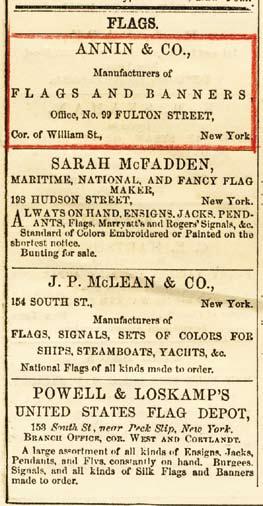
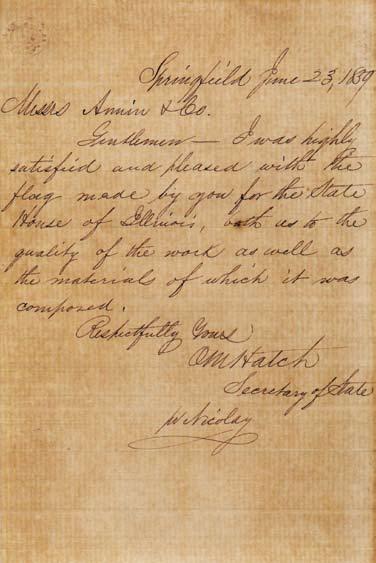
abo V e : Ozias M. Hatch, the Illinois Secretary of State in 1859, praised Annin for “the quality of the work and the materials” that went into a flag for the State House.
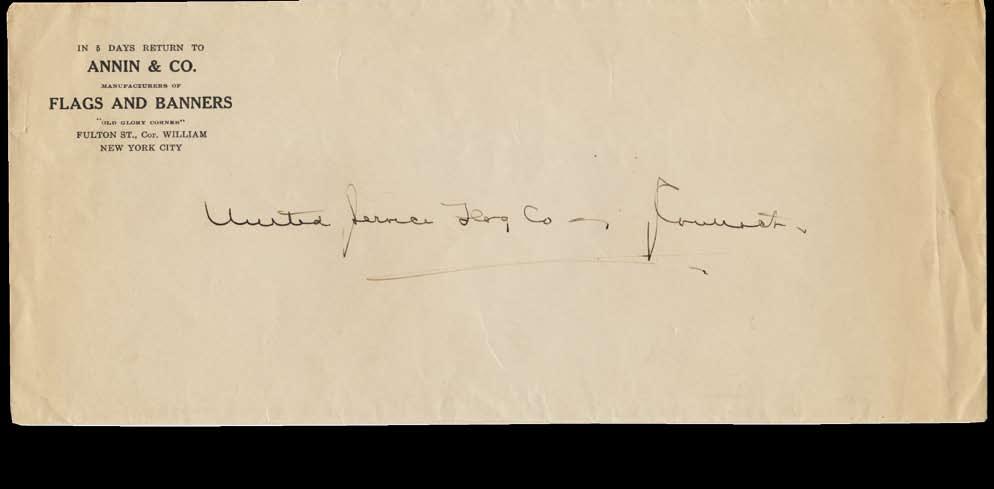
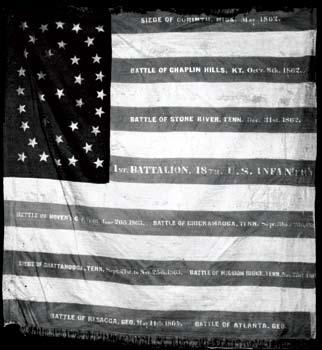
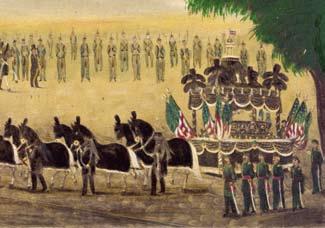
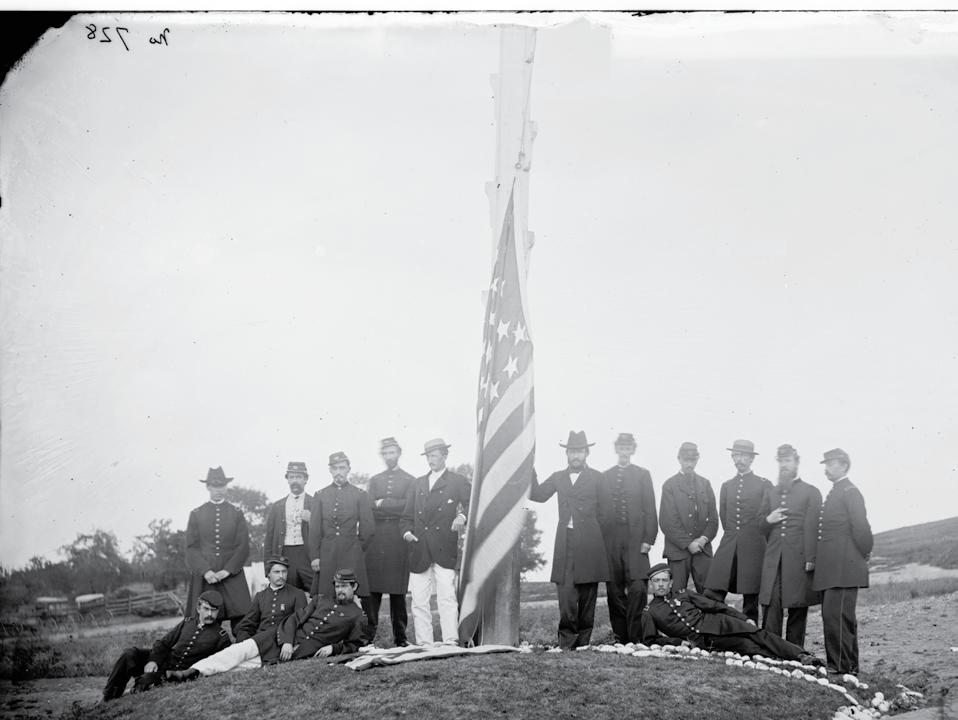
annin’s civil War connections by the time of the Civil War, which started in 1861, the words “Annin” and “flags” had become synonymous. The company was in a solid position to handle the surge in business generated by the four-year war. both the union and the Confederacy clamored for flags, and so did ordinary citizens. For the first time in the country’s history, flags became a consumer item.
abo V e : Annin flags draped the funeral car of President Abraham Lincoln, depicted here as it passed through New York City on April 26, 1865.
le F t : This typical Civil War battle flag was flown by the 1st Battalion of the 18th U.S. Infantry.
belo W: U.S. Signal Corps officers in Washington, D.C., in August 1865. The Corps requisitioned all of its flags from Annin.
An undated newspaper article in Annin’s archives from the 1860s notes that the u.S. Signal Corps requisitioned all its wartime flags from Annin. “Without going through forms of contract, they supplied the government direct. . . . as the war progressed, orders came pouring in from every state and city that was loyal to the union, so that by the beginning of 1864 there was not a single battlefield, a brigade or a division [that did not use Annin flags] . . . whilst in the Navy—fighting ships and transports—they formed an equally brilliant and imposing decoration.” Annin sold 1.5 million flags and emblems during the war.
Annin had supplied the flag for the inauguration of President Abraham Lincoln, and is believed to have furnished the flag that draped his casket as it was taken by train from Washington, d.C., to Illinois after his tragic assassination in 1865.
Phebe Annin, mentioned earlier as one of the three sisters of the owners, found herself in the South during these events. She had married Jacob Meech Ames, a New Englander who could trace his history back to the Mayflower. “Jacob was a planter in South Carolina with offices in New york City. He and Phebe lived in the Sea Islands near Charleston,” notes Carter beard, the company’s current president, who has a passion for Annin history and has done research on it. Normally the Ameses might have traveled north for the centennial celebration of William Annin’s stone house in New Jersey, a gala event in August 1866 attended by dozens of Annan/Annin descendants. but Phebe was in the late stages of pregnancy. on St. Helena Island near Hilton Head on September 5, she gave birth to Louis Annin Ames.
Louis might have been a lifelong Southerner—and company history might have been quite different—had circumstances not changed the lives of the Ames family.
annin’s headquarters were at 99-101 Fulton Street in Manhattan from 1847 to 1925. Annin sold to retail customers as well as dealers then. Here’s a look at the plant and offices as they were in 1869. It is taken from an archival clipping from an unnamed New York newspaper, with the oldfashioned spelling left intact, and it reveals Annin to be a fair employer with spacious workrooms and a satisfied work force.
The salesroom is tastefully, but without pretensions to show, laid out for the exhibition of different styles and qualities of their productions . . . .
In the workrooms on the floor above, we found quite an array of the tender sex, all busy employees one way or another, in the several departments of flag-making . . . Their healthy and intelligent look, and the peculiar zest with which they pursued their respective duties, forcibly impressed us . . . .
Messrs. Annin & Co. uniformly and with unflinching determination oppose anything that approaches the ‘fagging system.’ [Fagging is an
antique word that refers to a virtually unpaid apprenticeship.]
Their motive is to pay ‘a fair day’s wages for a fair day’s work,’ not to overcrowd the workrooms, and to see that proper ventilation and other appliances for the preservation of health are provided for in the most improved and liberal manner. . . . employees of the established are satisfied and contented.
Owing to the late [Civil] War, many flag-makers of small means and otherwise unable to manufacture flags upon a large scale sprang up, exacting enormous prices, and too often vending imperfect or spurious productions. . . . The past history of [Annin] has obtained for it the character of being cheap [inexpensively priced], prompt and reliable.H
to P: Employees of “the tender sex” measured and sewed in workrooms well lit with natural light.
right : A production room at Fulton Street, probably in the 1880s or later. Note the electric lamps on the wall.
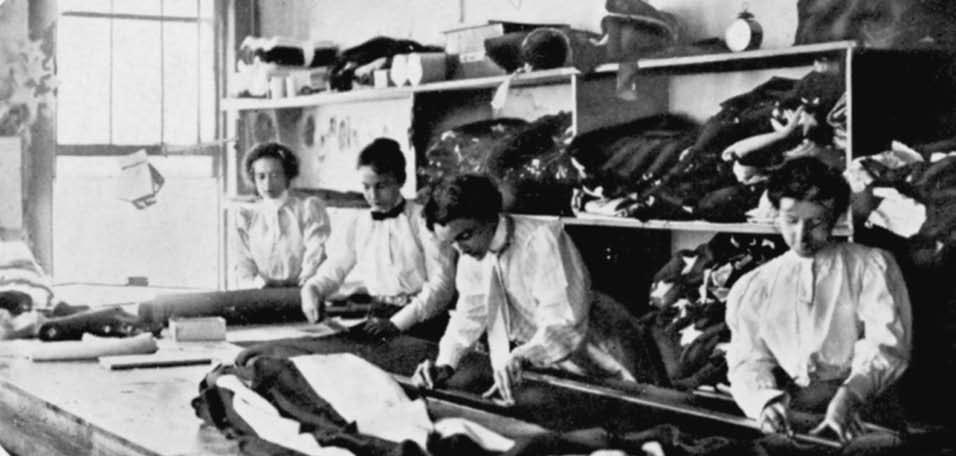
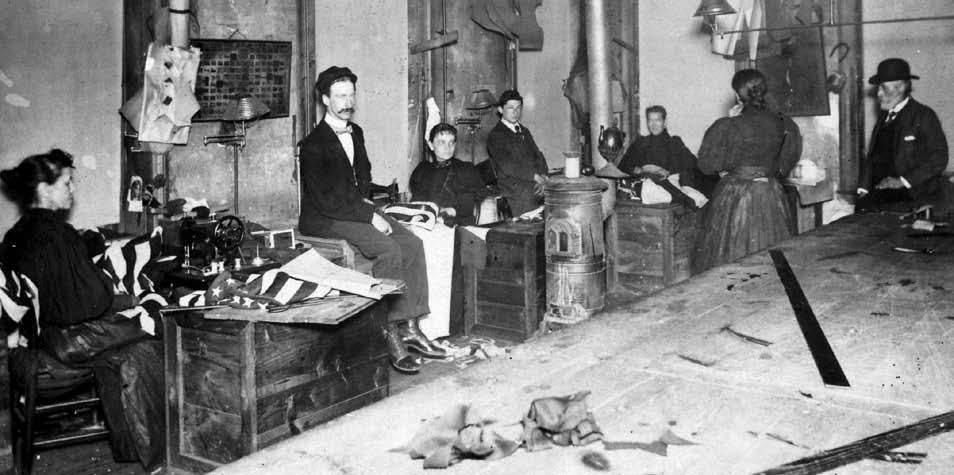

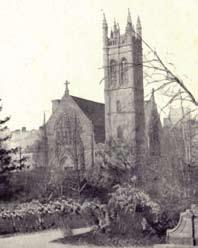
V e : The Church
prominently in the lives of Phebe
Ames, her son Louis, and their descendants. Many family marriages and baptisms took place there, and Phebe is buried there.
right : Annin office on Fulton Street. At far right is Louis Annin Ames, second from right is his uncle John Annin, and the second from left may be one of John’s older brothers, Benjamin or Edward. The candlestickstyle telephone on the desk at right indicates a date in the late 1800s or early 1900s.
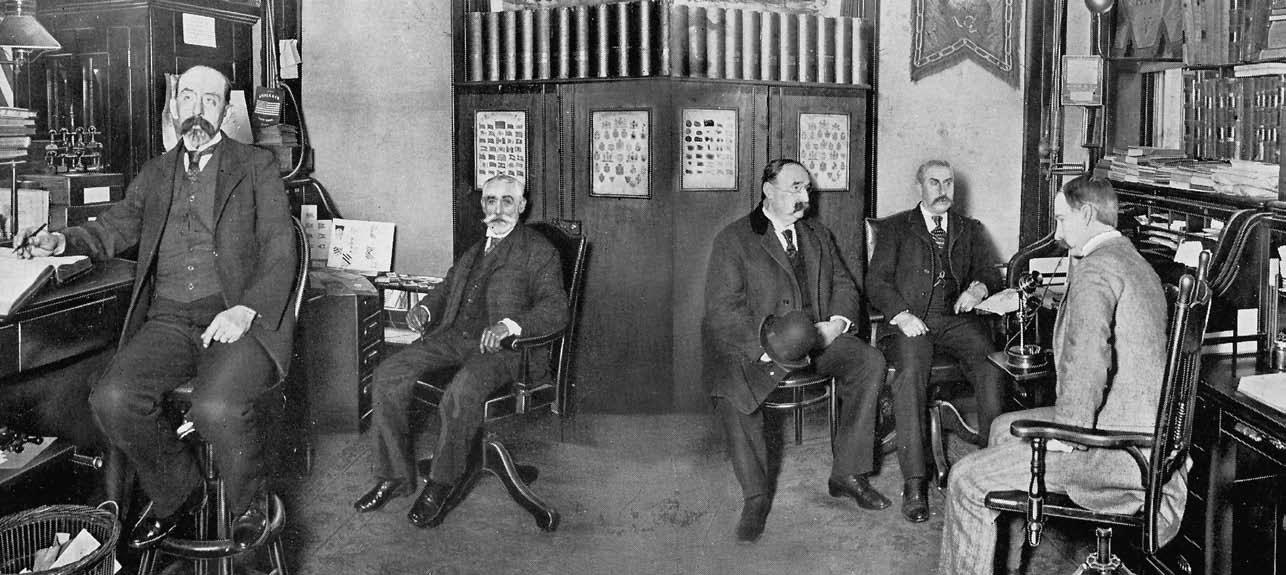
louis makes his way to annin & co.
Records indicate that Jacob Ames died while swimming in the ocean in South Carolina within two months of Louis’s birth. Phebe returned to Jersey City to be closer to her family as she raised her son. She would remarry, but not until Louis was 16. both mother and son were active in the Church of the divine Paternity in New york City, which Phebe had attended since her own childhood. The church was universalist, a Christian denomination that emphasized the use of reason rather than the more miraculous elements of Christianity. (today the denomination is part of the unitarian universalist Association of Congregations.)
Phebe also demonstrated the family’s penchant for patriotic duty. She was active in the daughters of the American Revolution and numerous civic groups, setting an example that Louis would follow through his lifetime. Louis always spoke fondly of his uncles, who most likely acted as father figures to him. And given the family tradition of starting work early,
he probably worked while growing up, though he did finish high school. Annin and other flag makers were busier than ever, thanks to the advent of sewing machines in the late 1860s. Machine-sewing “enabled the manufacture in an hour of a flag that had taken a day” by hand, according to a newspaper report.
Records show, however, that Louis started his full-time career at the perfume factory owned by his stepfather, Solon Palmer. Like Annin & Co., Palmer Perfume was a good-sized family business based in lower Manhattan. Palmer was a widower with children when he married Phebe, and he had a son and nephews working for him.
According to a later profile in Everybody’s Magazine for which Louis was interviewed at length, his uncle John came to him at the Palmer offices upon benjamin’s death in 1896. John announced: “My boy, I’ve come to take you back with me into the business.” Louis’s uncle Edward had already retired, and none of the uncles’ sons seemed interested in succeeding
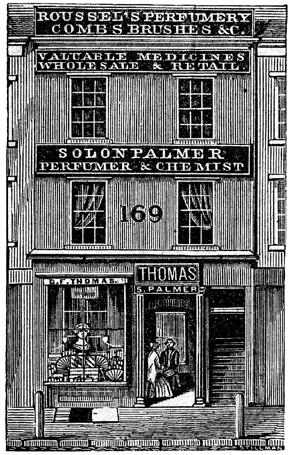
abo V e : Louis Annin Ames worked in his stepfather Solon Palmer’s perfume business before choosing to make his career at Annin & Co.
to P right : Fulton Street interior in the 1890s. Louis Annin Ames stood in the center, and probably one of the Annin brothers—Edward, John, or Benjamin—was in the back corner. The clerk at right is unknown.
lo W er right : John Annin, date unknown. When John was 57, in 1896, he brought 30-year-old Louis Annin Ames into the family business. Uncle and nephew worked as co-presidents until John’s death 13 years later.
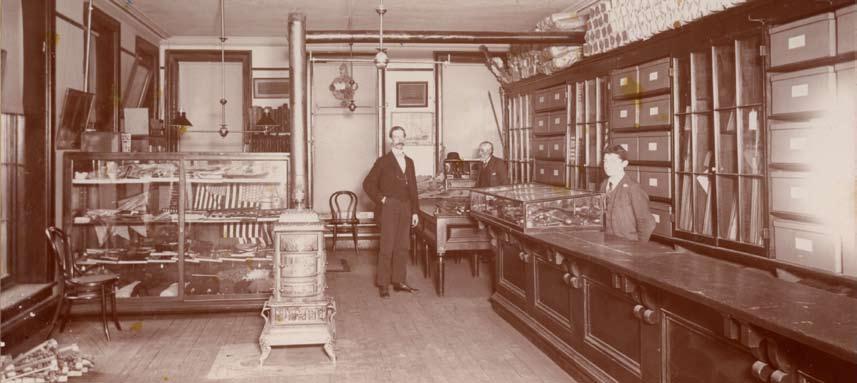
them. The reporter further explained: “John, the remaining member, immediately sought his sister’s child. The natural place for Louis, his nephew, was at his side, filling that gap. This was a family business. He could not take a stranger in. Many young men already established would have refused to follow the family tradition, but Louis Ames accepted his uncle’s offer.”
Louis may have been “my boy” to his uncle, but in fact he had just turned 30. Probably he didn’t think twice before saying yes. His chances of eventually running his stepfather’s business were slim; that role would (and did) go to Solon Palmer Jr. With or without Louis, Palmer Perfume would be in good hands. Annin needed him more, and he needed Annin. There he would be his uncle’s full partner—benefiting from the experience of the 57-year-old John, applying his talents to a product that perfectly suited his civic zeal, and preparing himself to lead the business in the new century just ahead. H
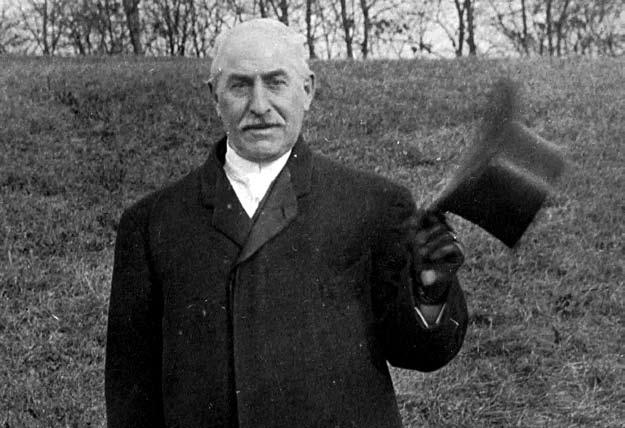
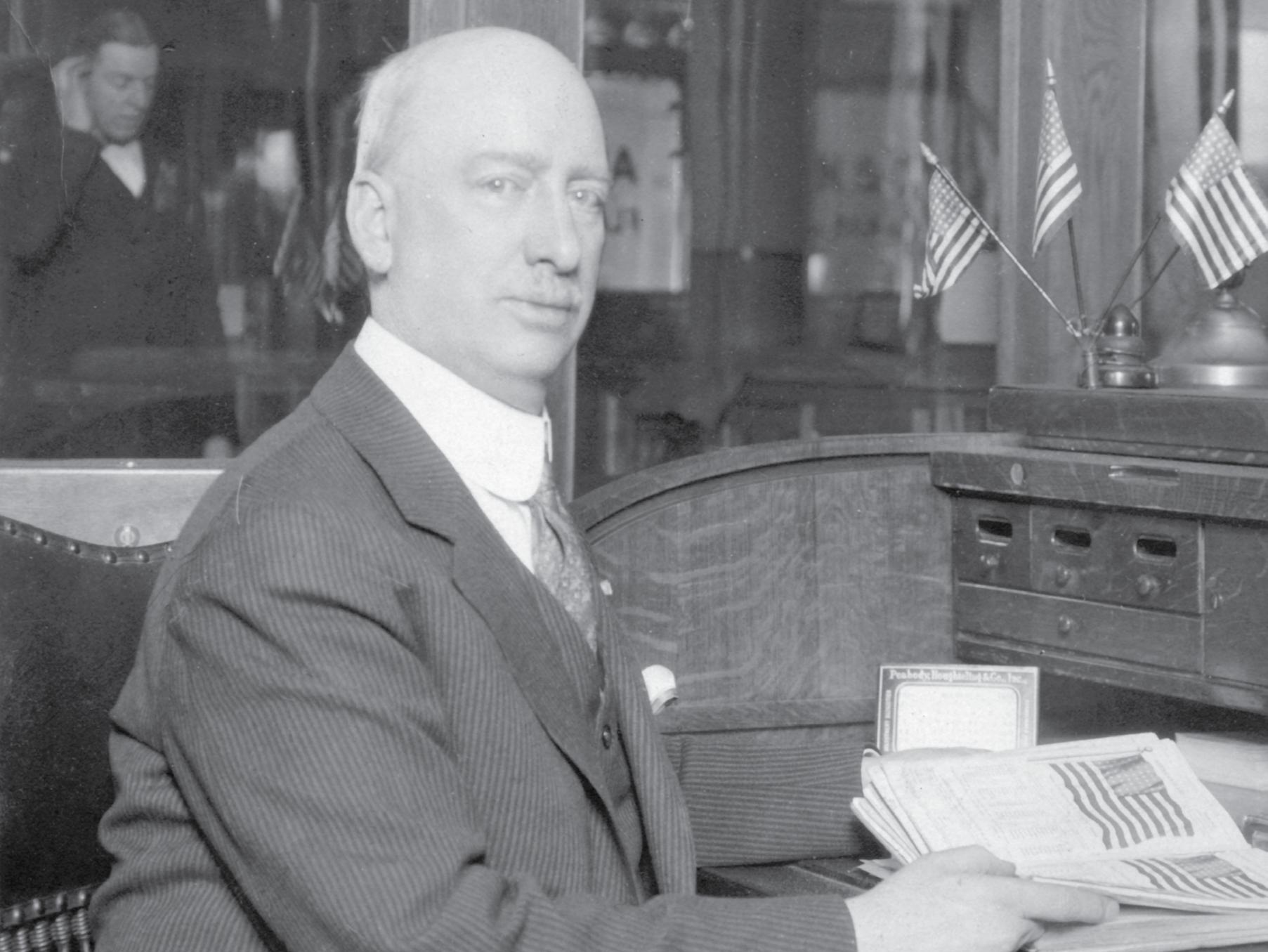
Perhaps the greatest fascination in flagmaking is the knowledge that often you are playing a concrete part in the making of history. all the elements of real drama are in it: romance, fervor, mystery, suspense.
Louis Annin Ames, President, 1926


Atrue story about Annin’s early years, told by a salesman who worked for the company for 55 years, captures Louis Annin Ames’s leadership style in a nutshell.
“I jumped off the horse car at the junction of Fulton and William Streets and went to see Mr. Ames,” recalled Arthur C. Edwards. The year was 1907, and Edwards was a 16-year-old job seeker. Louis made the hiring decisions, not his uncle John Annin, with whom he shared presidential duties.
Edwards was eager to go on the road for Annin, but Louis told him he’d first have to learn about flags by working in the store for at least two years. “About 10 days later I was hired, accepting a salary of $10.00 per week, with the promise of traveling influencing my decision,” Edwards reported. (He wrote his remembrances in the 1960s for The Annin Banner, a company newsletter.)
two years later, Annin’s two main traveling salesmen asked for raises. Louis pointed out that they hadn’t sold enough to merit higher salaries. They resigned, giving Edwards the trial run he was waiting for. “I was given a very limited list of customers and told that the territory [New york and New England] was mine. . . . When I asked where I should go first, Mr. Ames said he didn’t care, just as long as I got orders.”
Edwards headed for buffalo. He was greeted by a blizzard and an equally cold reception from the local flag dealer. “He asked me if there weren’t any men left in New york and why did Annin have to send out a rosy-cheeked kid?” What really angered the dealer was that his previous Annin order had never been filled. The salesman who took it had been one of the pair who had resigned. Edwards discovered they were in cahoots with a would-be competitor, someone who “had never manufactured flags but was attempting to do so.” The former salesmen had channeled their orders there.
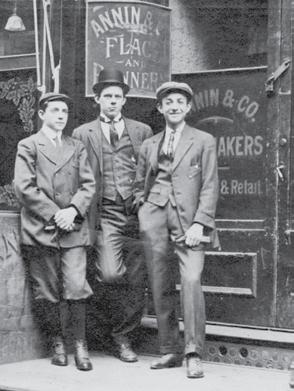
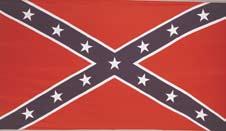
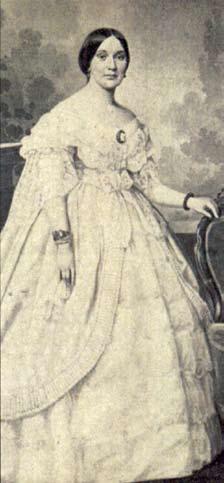
one of Annin’s most treasured legends involves a woman who came into the Fulton Street showroom to buy a Confederate flag—and who drew blood from her finger to illustrate the shade of red she wanted for it. She turned out to be the widow of Jefferson Davis, who had been president of the Southern Confederacy during the Civil War. This event really happened. But like many good stories, it grew more exaggerated with each retelling. In some of the renditions later published, Mrs. Davis’s blood gushes forth while Annin personnel watch in sheer horror. In fact, the blood was just “a tiny drop” and the transaction, while surprising, was civilized.
Here’s how Louis Annin Ames himself told the story, according to an interview recently uncovered in the Annin archives: “Mrs. Jefferson Davis visited Old Glory Corner to present a banner to the Confederate Veterans at a reunion. ‘I want a red banner,’ she said, ‘but not maroon, carnelian, or dark scarlet, or brick red. I want a bright, fresh, blood red. Like this!’
She quickly pricked her finger with the pinpoint of a brooch, squeezed a tiny drop of blood, and said ‘This is just the shade I want.’ We matched the drop of blood with a bit of sewing silk and later made up the old flag of the Confederacy in red of the exact shade.”
Varina Howell Davis was known to be a colorful character. After her husband died in 1889, she wrote a memoir about him and then moved to New York City to pursue a writing career. Her visit to Annin would have taken place between 1896, when Louis joined the company full-time, and her death in 1906. A century later, Annin still sells Confederate flags. H

undaunted, Edwards got to the bottom of the matter. He telegrammed the would-be competitor, challenging him to fill the buffalo order by April 1. The competitor telegrammed back that he didn’t have the machines or material yet. Edwards showed that message to the buffalo dealer, and to dealers in Rochester, Syracuse, utica, and Albany who hadn’t received their Annin orders either. Three weeks later he triumphantly returned to Fulton Street with orders totaling almost $3,000 (worth about $66,000 today)—not bad for a rosy-cheeked rookie’s first road trip. Louis and John greeted him, he said wryly, “with considerable enthusiasm,” and he continued selling for Annin until 1962.
The tale illustrates aspects of Louis Annin Ames that would be evident throughout his career. He wanted everyone at Annin to gain a hands-on knowledge of flags. He was quick to offer opportunity to ambitious employees, but he could be slow to catch on when a few unscrupulous ones abused Annin’s good name and reputation. However, he always resolved those situations in Annin’s favor. He understood that while flags seem simple, in fact they are complicated products to manufacture and market—a reality that has stymied many competitors. He paid competitively; Edwards’s starting pay of $10 a week was a respectable wage in 1907. Most of all, he focused on results.
to P: Confederate flag.
le F t : Varina Davis, the First Lady of the Southern Confederacy, during the Civil War.
Louis’s years of co-presidency shaped his life both professionally and personally. In 1906 he hired an art school student named digby W. Chandler to fill in for a designer who was ill. Chandler would remain, move into sales, and cultivate accounts that are still Annin mainstays, including the boy Scouts and the American Legion. Indeed, he would eventually become the company’s first non-family president and one of the world’s leading flag designers. An urban sophisticate with a prickly personality, Chandler would reveal his insecurities by referring to himself through his Annin career as “part-time help.” He would prove to be Louis’s smartest hire, though not his easiest.
Chandler’s arrival coincided with Annin’s investment in “a highpowered machine [that] sews two seams at one time and also sews the stars on both sides of the union at once,” as Louis described it. This advanced equipment helped Annin keep pace with the sales growth generated by go-getters like Edwards and Chandler.
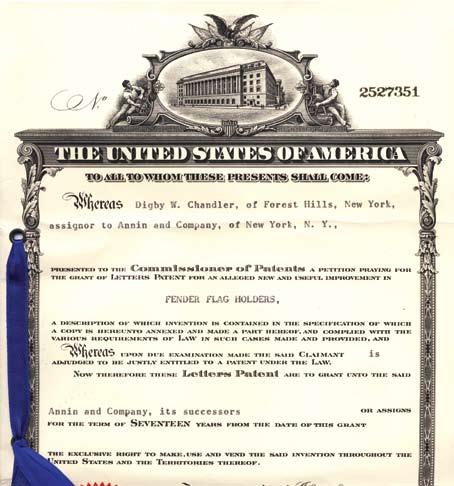
on the personal side, Louis finally married in 1909 at age 42. He had long been considered one of Manhattan’s most eligible bachelors. His wife, Abby Whitney Crowell, came from a distinguished family that went back to the Mayflower. The couple invited 1,000 guests to their wedding at Louis’s beloved Church of the divine Paternity.
Fortunately, John was still alive to share in his nephew’s joy. He died a few months after the wedding, secure in the knowledge that Louis would carry Annin forward. After John’s passing, Louis became known publicly as Colonel Ames, or simply “the Colonel.” He had earned the title in the New york National Guard. It was a bit of an affectation, perhaps, for a man not given to pretenses.
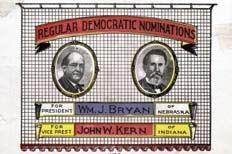
abo V e : Banners for the 1908 presidential race (Bryan vs. Taft) appeared in a special Annin catalog proudly printed in “New York, U.S.A.”
le F t : Digby Chandler designed Annin’s first car fender flag holder and assigned the patent rights to the company.
belo W: Louis Annin Ames served in the Sons of the American Revolution throughout his life.
right : Louis’s marriage to Abby Crowell lasted until her death in 1939. Four generations posed in the summer of 1933: Louis, his mother Phebe Annin Ames Palmer, daughter Jean Ames Dennis (left) holding her son Jack, and daughter Edith Ames Beard with her sons Randy II on his tricycle and Lee in her arms.
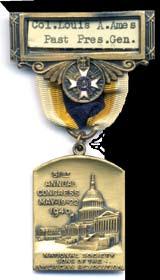
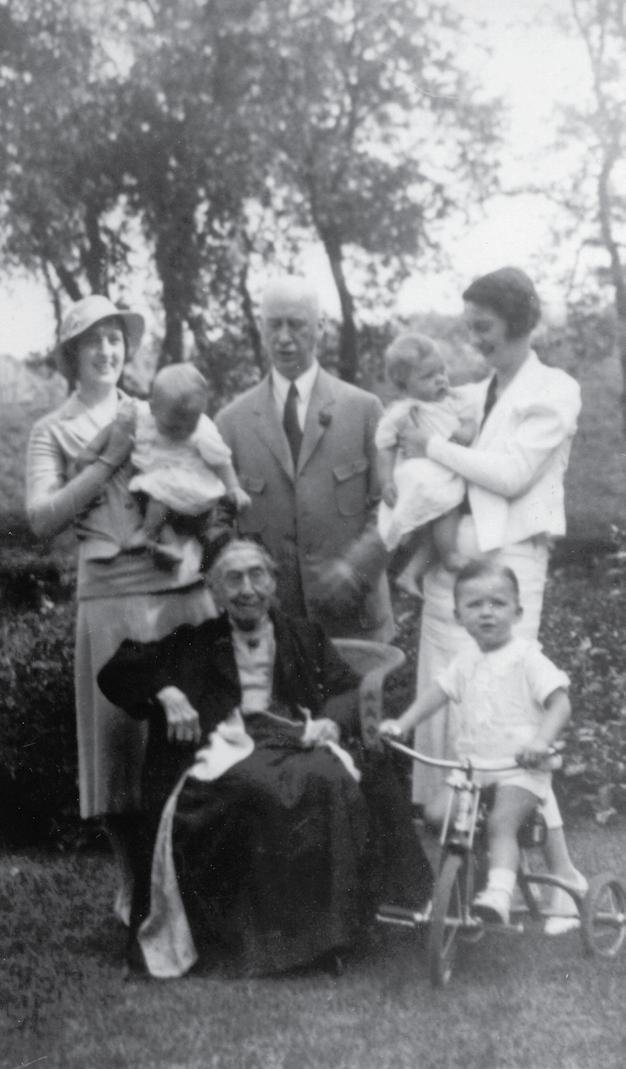
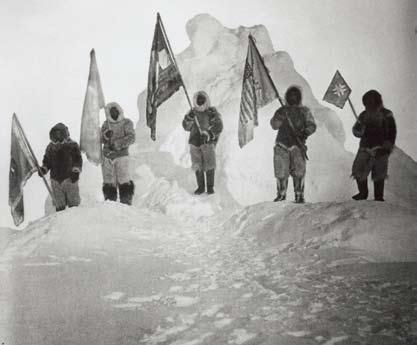
company incorporation and expansion
Louis’s first major act as sole president was to incorporate the company. The initial capitalization was $250,000, and the signing took place on January 8, 1910. treasurer James Knapp held one share of stock. So did digby Chandler, indicating how quickly he had become valuable to Annin. Louis held the rest. Annin’s attorney overpaid the New york State incorporation fee of $11.50 by one dollar. In thrifty Annin fashion, Knapp obtained a refund.
The company listed assets totaling $25,463.75. Among the major holdings were $10,000 in “dies, knives, and shears, and electrotypes” and $2,500 in “advertising matter and catalogs.”
Newly capitalized, Annin continued its role in history-making events. Louis spoke of his delight at watching ships steam into New york harbor flying the newly official flags of Portugal and Panama, made by Annin; he saved for his own collection an Annin flag carried by explorer Robert Peary on his historic 1909 expedition to the North Pole. He also enjoyed telling how he advised Chinese students from Columbia university on flag design. Annin styled a new flag for them, which they ordered by the thousands for delivery to a nondescript storefront in Manhattan’s Chinatown. “We
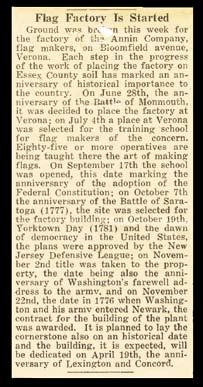
abo V e le F t : The Robert Peary expedition at the North Pole, 1909, with Annin flags. Peary returned his flag to Louis Annin Ames, who kept it for his personal collection.
abo V e : In 1918, a local newspaper noted how Annin keyed its growth in Verona to major dates in U.S. history.
heard nothing further for two years,” he said. but the students had been political operatives who had secretly exported the flags. “overnight came the Chinese Revolution. The next day our flags were flying all over China.” demand for u.S. flags boomed with the advent of World War I. Louis was not the first Annin president to note ruefully that wars are good for business, nor would he be the last. However, he was the last to engage in the practice of wartime price-gouging. In 1917, the Federal trade Commission charged Annin and 19 other manufacturers with “concerted illegal action to raise flag prices . . . after the declaration of war. . . . The investigation showed that in some cases 300 percent profit was made.” It was a mistake Annin would not repeat.
the Verona decision
Even before the war, Annin needed more space. In 1916 Louis had leased a building at 371 bloomfield Avenue in Verona, New Jersey (site of the current Verona Park)—not to make flags, but to recruit and train new employees. It was a first step toward constructing a large plant in the vicinity. That would allow Annin to close down six smaller workrooms in Manhattan, brooklyn, and Ayer, Massachusetts, while keeping the Fulton Street headquarters for sales and custom work.
Why Verona? Louis loved western Essex County. As a bachelor and new husband he had often weekended in Caldwell, then a bucolic resort town called “the denver of the East.” He stayed at the elegant Monomonock Inn, which commanded grand views from the height of bloomfield Avenue and Prospect Street. (The inn, which boasted a golf course and tennis courts, was dismantled during World War II. The land now houses an apartment complex.) Soon he and Abby—by then the parents of Edith and Jean—had built a weekend home in nearby Essex Fells. (Edith Ames would marry Cameron Randolph beard. Their sons Cameron Randolph II and Carter Lee, nicknamed Randy and Lee, would grow up to co-own and run the company; Randy and Lee’s sister barbara would also become a co-owner. Jean Ames would marry Walter dennis; their son John, better known as Jack, would join his cousins as a co-owner and co-executive. Jack’s sister, Carol dennis Fielding, is also a co-owner. barbara and Carol are profiled on page 74.)
Louis located an ideal site for the new plant at 163 bloomfield Avenue in Verona. It had been a small farm. before buying it, however,
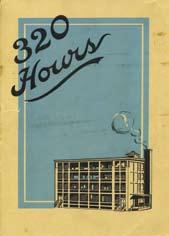
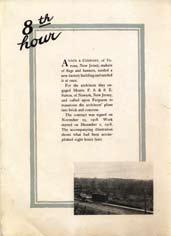
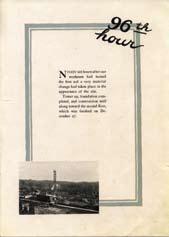
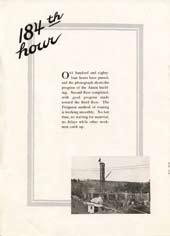
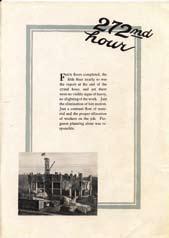
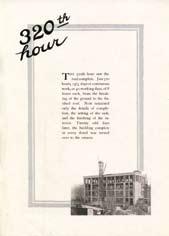
Annin had to petition the New Jersey Council of defense for a special permit because the project required scarce resources. “The purpose of this building is to increase output of government flags and international code signals,” Annin’s application stated. “The project cannot be postponed until after the war, as the demand is for present consumption . . . the Government’s needs are immediate.” After a surprisingly fast approval, the land changed hands three weeks later, on November 6, 1918. Annin razed the farmhouse but kept the barn and kindly gave the sellers access to it for three years.
“ the miracle building”
Lee beard, a retired co-president who remains active on Annin’s board of directors, recalls a letter containing his grandfather’s memories of the Verona factory. “Louis Annin Ames considered it a ‘building miracle’ because it was erected in one of the coldest winters on record,” Lee says. “It was also the first successful attempt to build a concrete structure within a heated canvas enclosure.”
Newark-based architects F. S. and S. E. Sutton handled the design. but the real heroes were the workers of Paterson-based John W. Ferguson Co., which engineered and constructed the factory. Ferguson prided itself on its efficiency. In a promotional booklet called “320 Hours,” Ferguson detailed how it built the factory in exactly that amount of time. Here are highlights: • november 25, 1918: Contract signed.
• December 8, 1918: Work started.
• 8th hour: Lumber delivered and unloaded at worksite.
• 96th hour: tower up, foundation completed, construction “well along toward second floor,” which was finished on december 27.
• 184th hour: Second floor completed with good progress toward third. “The Ferguson method of routing is working smoothly. No lost time, no waiting for material, no delays while other workmen catch up.”
• 272nd hour: Four floors completed, fifth nearly so.
• 320th hour: After 40 work days of eight hours each, workers progressed from breaking ground to finishing the roof. “Now remained only the details of completion, the setting of the sash and the finishing of the interior. 20-odd days later, the building complete in every detail was turned over to the owners.”
The result was a 35,000-square-foot factory with four stories and a full basement, constructed on a footprint of 60 by 115 feet. It included steel sash, concrete sills, brick panels below the sash, hollow-tile facings, cementfinished floors, elevator shafts, and two concrete stairways. This represents the eastern portion of the factory in use until July 2013 (Annin would add the western wing seven years later).
Annin audited the bills carefully and obtained credit for unauthorized items as small as 20-cent telephone calls. The company also approved upgrades as needed, such as $2,904 for state-of-the-art lifts from otis Elevator.
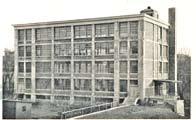
John W. Ferguson Co. of Paterson, which engineered and constructed the Verona building, chronicled its work in this promotional booklet. The final price came very close to Ferguson’s estimated costs:
• Material $57,655
• Labor $24,095
• Permits, temporary office, heat, and phone $4,900
• Field organization of six foremen
$2,850
• Preparation of drawings, general office expense, and profit $8,500
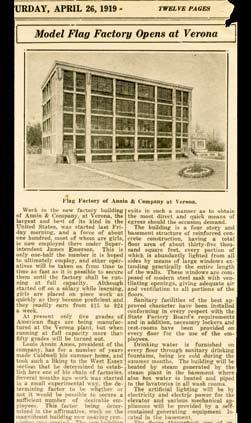
le F t : The Verona building earned praise for its large windows and modern conveniences.
right : In July 1925, robbers stole Verona’s $4,000 weekly cash payroll. They fled up Bloomfield Avenue and tried to elude police by hiding in sand pits and haystacks on Pleasant Valley Way.
belo W: A worker sews the Hudson flag, seen on the opposite page.
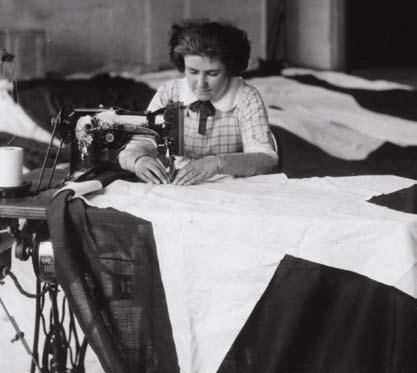
“Model flag factory opens”
The new factory opened on April 1, 1919, and immediately brought new distinction to Verona. A local newspaper reported that the workforce of 100 employees, “most of whom are girls,” was expected to double. “Although started off on a salary while learning, girls are placed on piece work as quickly as they become proficient and they readily earn from $15 to $24 a week.” That was an excellent wage at a time when male factory workers averaged about $26 per week but women averaged not quite $14 per week.
Cited as a model flag factory, the building’s amenities were also amazing for the era. The newspaper noted that “particular care [had] been taken to provide well-lighted and ventilated workrooms so requisite for the health and comfort of the operatives, with ample provision for their safety.” Also of note: each floor had lockers, rest rooms, and access to drinking fountains with water that was “ice-cold during the summer months.”
A boiler in the basement pumped out steam heat in winter; an electrical generator provided power. Annin apparently didn’t want to depend on Public Service Electric & Gas, the local utility, whose primary business then was transit. It operated the bloomfield Avenue trolley that ran past the plant.
Annin equipped the factory with Singer sewing machines so well-made that some are still in use today. (Regular maintenance is the key.) These allowed Annin to produce sturdier flags for outdoor use. Quality fabric helped, too: “The majority of [outdoor flags] are made of wool of a finer grade than that used in a business suit,” Louis noted. Annin also invested in automation such as mechanized die-cutters for stamping out stars.
Probably the most exciting event involving the factory was a robbery in July 1925. An Annin messenger carried the week’s wages in cash from the bank, as was the custom. (Various accounts place the payroll at $3,500 to $4,000.) Leaving the trolley, the young worker was blackjacked by two waiting bandits. They grabbed the money bag and sped north on bloomfield Avenue in a rented car. A Verona policeman on motorcycle gave chase; he was after them for speeding, not realizing that a stick-up had occurred.
“The robbers drove the bandit machine at a speed of 75 miles an hour,” a local newspaper reported in awe. The officer fired shots. Finally the

right : In 1923 Annin created the world’s largest U.S. flag for J. L. Hudson’s flagship department store in Detroit. Stripes were 7 feet wide, stars 6 feet in diameter.
belo W: Annin’s Fulton Street building, with flags visible at left, narrowly escaped a nearby fire in 1925. Louis Annin Ames preserved this clipping in his personal scrapbook, presumably as a reminder of the company’s good luck. At that point, Annin had already decided to move its Manhattan location to 85 Fifth Avenue. It had transferred most of its flagmaking to the Verona plant.
bandits careened into a sand pit on Pleasant Valley Way in West orange, an area then so rural that the men ran and hid in haystacks. The police tracked them down and arrested them. A local citizen recovered the money bag that they’d flung from the car; it was returned to Annin without a penny missing. The robbers were convicted.
The new factory helped Annin prosper in the 1920s. All of America was thriving. For the first time, more people lived in cities than in farm towns. Women finally got the right to vote. The country’s wealth doubled, with Americans lavishing money on homes, cars, radios, and household appliances that had never existed before. Louis took advantage of the good times by asking Annin’s board for a car and chauffeur for business use; the request was approved.
one symbol of the Roaring twenties was the world’s largest u.S. flag, created by Annin for Hudson’s department Store in 1923. Hudson’s was in detroit, a city flush with wealth from the booming auto industry. The giant flag measured 90 feet by 200 feet and weighed 800 pounds. Annin’s designers had to make a scale model of the store to figure out how to hang it against the block-long facade. This flag held the record for size until Hudson’s retired it in 1946.
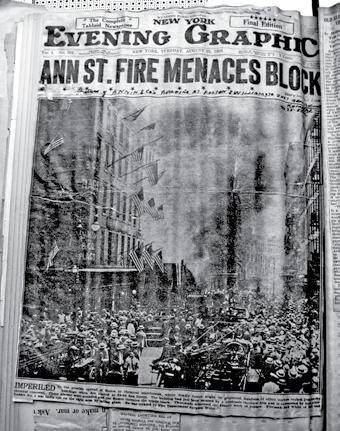
business was so good that Annin needed yet more space. In 1925 a company subsidiary, old Glory Realty, purchased a new headquarters: 85 Fifth Avenue at 16th Street. A retail showroom was at street level; the basement and some upper floors housed the offices, custom production, and distribution. The 99-101 Fulton Street building was sold to Royal Insurance Company, which replaced it with a skyscraper.
Louis’s timing was lucky: a chemical fire near Fulton Street almost devastated the whole block just before the move. Hundreds of workers ran into the streets in panic. Fortunately 99-101 Fulton did not burn down. Clearly shaken by the incident, Louis kept a front-page newspaper photo of the fire in his personal scrapbook. Annin’s flag-decorated exterior is visible through the smoke.
The new neighborhood was ideal for flag-selling. Fifth Avenue in the teens was part of the “Ladies’ Mile,” home to Arnold Constable, Lord & taylor, and other top department stores. Annin dubbed its location “old Glory Corner,” a nickname it had used on Fulton Street.
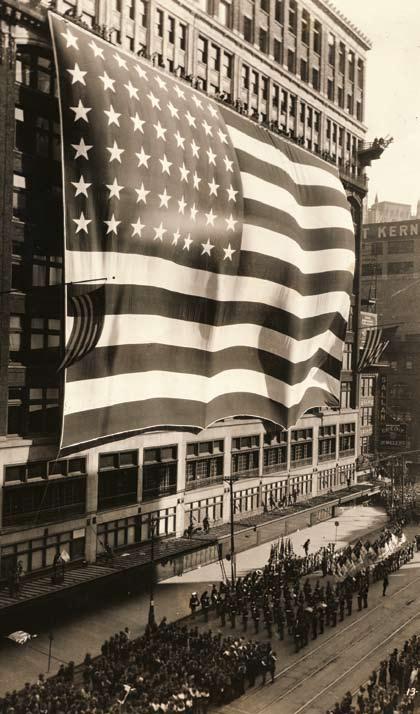
The quest for extra space extended to Verona. In autumn 1925, Annin requested bids for a western wing to 163 bloomfield Avenue. It retained the original architects but awarded the construction to Newark-based W. J. MacEvoy Company, the low bidder at $88,889. The addition doubled the factory space and added a cafeteria. Catalog Number 250 introduces the expanded facility:
Our flag plant at Verona, New Jersey, is the largest, most up-to-date and sanitary flag factory in the world. Completed in November, 1926, this factory contains 100,000 square feet of floor space. It is a daylight building with 4,000 panes of glass. . . . this plant not only makes its own light, power, and heat, but is furnished by a circulating system from its own artesian wells (200 feet deep), the purest of waters for use by its employees. This exceptionally pure water is also used in the Dye Department, thus insuring the finest results obtainable in the proper blending of Defiance dyes, which are guaranteed to be extremely fast to sun and rain.
The ability to print fabric on site made Annin more efficient and productive. In fact, it gave Annin such an advantage that its printing procedures became a closely guarded trade secret. In 1928, Annin entered into an agreement with new employee John Windolf that entrusted to him the “secret formula of anilines and other dyes and process of applying same for dyeing of fabrics.” Windolf, a scientist, would become one of the company’s key resources. Annin continues to print to this day and it is a key part of production.
the plunge into bankruptcy
The 1920s were like recent years in some ways. Individuals and businesses began to use credit more freely. Many people lived beyond their means, believing the value of real estate and other assets could only rise. Speculation in stocks was rampant. on october 29, 1929, the bubble burst. The stock market plunged on that infamous black tuesday, ushering in the Great depression.
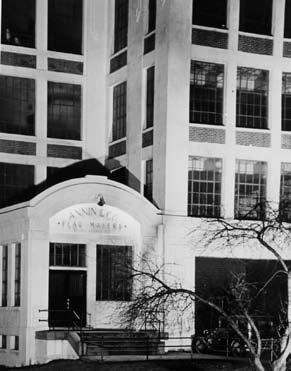
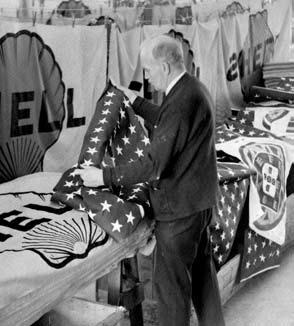
to P: Added in 1925, Verona’s west wing doubled the factory space.
Louis Annin Ames proudly reported the building’s total size at 100,000 square feet, but it was actually closer to 55,000 square feet.
abo V e : John Windolf introduced colorfast dyes and headed the printing department in the 1930s. His son also worked for Annin.
After a decade of expansion, Annin was vulnerable to the era’s economic upheavals. Flag sales would plummet, but that was hardly the biggest problem. by 1936 the company had to file for reorganization under Section 77b of the federal bankruptcy Act.
What went wrong? In the worst years of the depression, the early 1930s, two Annin employees perpetrated swindles. one, the office manager since 1914, forged checks for his own use and juggled money between the bank accounts of Annin and its real estate subsidiary. The other, a young bookkeeper, forged and post-dated Annin checks to buy herself clothes and jewelry. Her involvement was brought to light by a jewelry store owner, Maurice deSedle, who brought claims against Annin for unpaid debts when her check scheme collapsed. The office manager confessed but moved on to another job where he committed similar internal fraud. He was finally convicted and sentenced to a federal penitentiary.
Whether Louis turned a blind eye to these dealings or just didn’t see them can never be known. Perhaps he simply trusted his employees too much, as he had with the 1907 salesmen who funneled orders to a wouldbe competitor. No doubt he was preoccupied with his heavy personal losses in the stock market. documents in the deSedle case show Annin’s condition as grievous:
For many years the Debtor [Annin] had enjoyed excellent bank credit, being indebted to banks for as much as $800,000 …. As years went by, credit decreased until in 1932 no further bank loans were obtainable. . . . In 1933 approximately 75 percent of the creditors of the Debtor were receiving post-dated checks. . . . The condition of the company was so desperate that it was obliged to defer the payment of part of employees’ salaries and to pay salaries with post-dated checks. This led to a filing of complaint with the Department of Labor in September 1933, [which was] paid off in installments and satisfied in 1935.
As the last fact indicates, Annin fully intended to meet its responsibilities and make reparations. Indeed, the purpose of the bankruptcy filing was to recover and emerge in strong enough condition to repay creditors. towards that end, Louis recruited his son-in-law Cameron Randolph beard into the business.
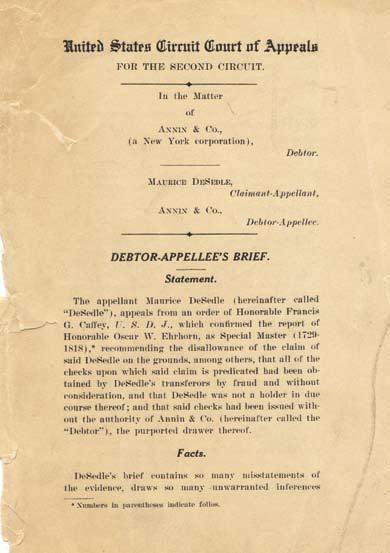
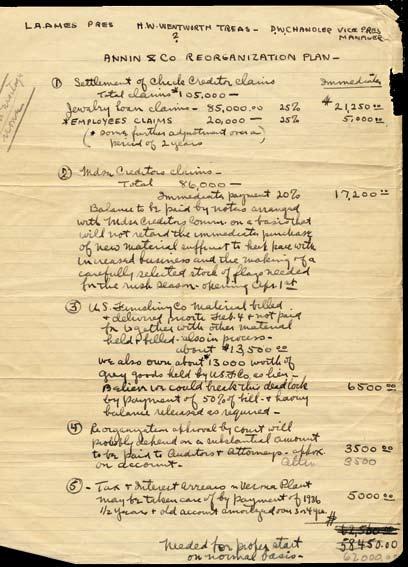
right : Cameron Randolph Beard with a customer. He joined Annin in the 1930s at the urging of his fatherin-law, Louis Annin Ames, who drew on Randy’s experience in finance and manufacturing.
le F t : Swindles perpetrated on Annin led to litigation, adding to the company’s near-demise in the Great Depression.
center : Louis Annin Ames’s handwritten workout plan led to a bankruptcy filing and successful re-emergence in 1938.
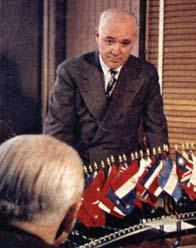
Thirty-year-old Randy was the right person at the right time. He had finance experience from having worked at a New york bank. He knew manufacturing from his sales job at a large textile mill in his home state of tennessee. Just as importantly, he brought fresh energy, unquestioned honesty, and a renewed sense of family dedication to Annin. His two young sons, Randy II and Lee, would literally grow up in the business.
“our delay is our competitors’ greatest weapon”
Although Louis had led Annin into the 20th century, he retained some 19th-century ways. A man of deliberate action, he would not be rushed. A month after the bankruptcy filing, Chandler impressed on him the need “to snap into a plan”:
“Having worked from the beginning on the one definite plan of going ahead – reorganized and rejuvenated – many things have already been accomplished. With the prospect for Annin & Co. brighter than at any time within 10 years, success is assured if we can get going NoW!
“. . .We have on our books the cream of the flag business of the country, which will be lost if we don’t snap into a plan of reorganization. I have phoned, written and called on these accounts assuring them we were heading for bigger and better things. This condition will not hold together much longer, a few weeks perhaps at most, before we will find accounts
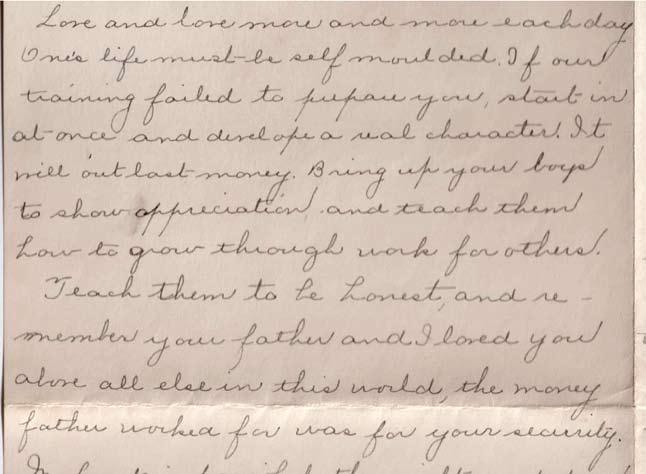
During Annin’s bankruptcy proceedings in 1936, Louis’s wife, Abby, wrote a poignant letter to their daughter Edith. “If our training failed to prepare you, start in at once and develop a real character,” she advised. “It will outlast money.”
going to competitors who are watching us and our lucrative business like hungry wolves—our delay is our competitors’ greatest weapon against us.
“We have already removed some of the dead wood and all of the crooks from our organization. We have increased our factory working hours from 40 to 44 hours per week without increasing wages. The factory workers are willing to do their part to help the company find a way out at this time with possible adjustments later.”
Louis took the clue and produced a formal plan of reorganization. by June 1936, the court approved it. Next came the hard work of implementation, which fell more on Louis’s shoulders than Chandler’s. “The Colonel wasn’t interested in design [as Chandler was],” according to the
late William “bill” dwiggins, who worked for Annin in sales from 1937 to 1982. “The Colonel had to finance the thing. That was what he was interested in.”
In November 1938, Annin emerged from bankruptcy. The company paid all its back taxes and debts. banks again lent it money and issued mortgages when needed. Annin in turn repaid Louis’s mother, Phebe, who had reached into her own accounts to keep her son’s company afloat during the darkest times. “I remember later reading a letter from my grandmother Abby to my mother about how ill-prepared she was for bankruptcy matters,” notes retired president Randy beard II. “This was a woman who had been to finishing school. . . . It was very touching.”
chandler’s hard bargain
one more financial matter demanded Louis’s close attention. Annin had landed a major assignment—the creation of flags, pennants, and banners for the New york World’s Fair of 1939-1940. The infusion of revenue emboldened Chandler. As vice president of purchasing and production, he apparently threatened to jump ship and take Annin’s big accounts with him unless the board gave him compensation guarantees.
It was probably not the first time he had rattled his saber. “I knew digby through his customers because eventually they were my customers,” Randy II says. “When digby put the arm on them, he made his mark. He parlayed his personality and his art [connections] into a really unique character. He made it work for the customers who liked him.”
Annin could not afford to lose such bedrock accounts as the American Legion and the boy Scouts. Louis filled dozens of pages of paper with figures, sketching out various scenarios to placate Chandler. In 1939 they arrived at an agreement whereby Chandler would always earn two-thirds of Louis’s salary, plus 45 percent of dividends paid on capital stock.
Chandler’s timing could be construed as cruel. He pressed his case when Louis was worn down not just by the bankruptcy workout but by the illness and death of both his 103-year-old mother and his beloved wife. by year’s end, the widowed Louis moved permanently to his weekend home in Essex Fells. He relied more than ever on Randy, now a vice president overseeing sales and finance, to guide the company.
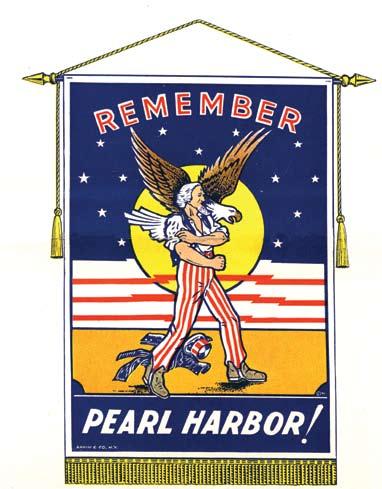
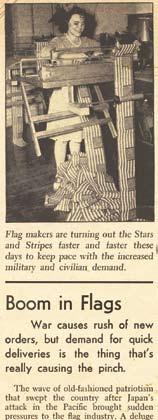
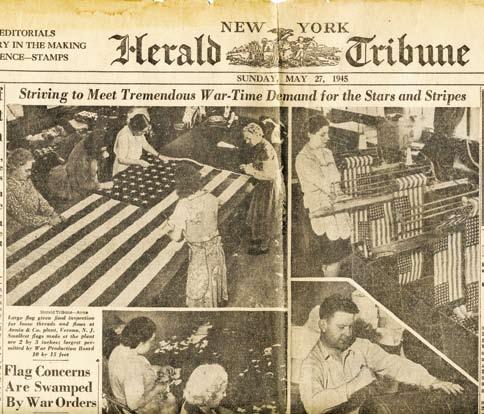
Europe had plunged into World War II in 1939. Although the united States had not yet entered the fray, patriotism was on the rise. A speech by President Franklin d. Roosevelt touched off a demand for flags. “Many orders had to be turned away,” Randy told the New York Herald Tribune in June, 1940. A month later, he reported: “A single order of 400,000 flags from a Minneapolis advertising firm had to be declined with thanks. We just couldn’t do it.” by September Life magazine announced: “boost in Patriotism Gives u.S. Flag business Its biggest year Since 1917.”
With Annin producing at full capacity, Chandler extracted a further agreement that included a significant signing bonus plus yearly bonuses, a sizable insurance policy, and a guarantee of employment through 1954. For his part, he had to “devote his entire time and energy to the business” and agree not to work for a competitor or start a flag business for three
years should he leave or be terminated for cause. The signatures on the original document tell their own story: Louis firmly added “President” under his own name, using Chandler’s pen.
America declared war the day after the Japanese attacked Pearl Harbor, Hawaii, on december 7, 1941. Many manufacturers had to shut down or retool themselves as defense plants; for example, Chrysler switched from making cars to Sherman tanks. but the flag business spun into high gear. during the war Annin produced 350,000 u.S. flags per month, none larger than 10 by 15 feet. That was the maximum allowed by the War Production board, which rationed materials. The company created a California subsidiary and opened a small factory in Los Angeles for extra capacity from 1941 to 1946.
The war generated some odd and fascinating projects. Shortly after Pearl Harbor, the Federal bureau of Investigation got a tip about “a nest of
le F t to right : Annin designed and sold this Pearl Harbor banner within weeks of the attack on December 7, 1941. Newspapers and magazines such as Business Week (center) often highlighted the company’s wartime efforts.
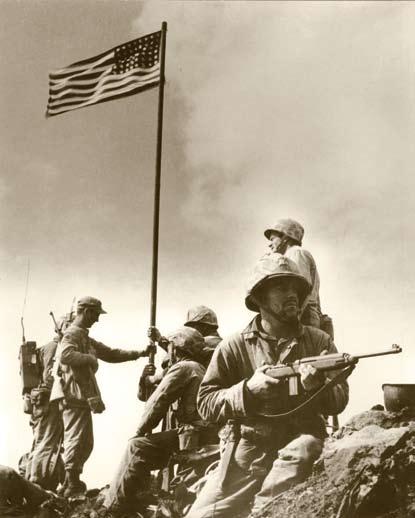
This was the first U.S. flag raised on Iwo Jima. It was made by Annin and photographed under enemy fire by U.S. Marine Lou Lowery at 10:30 A.M. on February 23, 1945. At 1:00 P.M. , Associated Press photographer Joe Rosenthal took the famous photo in which a larger flag was being raised. Lowery donated his photo to Annin after the war.
traitors” making Japanese flags on Fifth Avenue. False alarm: the Pentagon had hired Annin to supply flags that would arouse audiences during mock battles at war-bond drives. Annin also made enemy flags for use in u.S. War department movies, and stitched u.S. banners in purple, white, and orange that would appear as red, white, and blue under primitive technicolor film cameras. other unusual assignments included waterproof flags for submarines and luminous ones to wave in the dark.
Annin’s most famous wartime contribution was the flag planted atop Mt. Suribachi in Japan, where the battle of Iwo Jima took place in February and March, 1945. American Marines planted a relatively small flag, 54 by 28 inches, on the fifth day of the 35-day battle. “Since the sight of the flag was important to the morale of the troops, who still had a lot of fighting to do before Iwo Jima was secured, the Commanding officer decided to raise a larger flag, resulting in Joe Rosenthal’s famous picture,” according to The Annin Banner. Rosenthal’s iconic photo became one of the most reproduced images of all time.
After the war Annin co-developed Nylanin, a textile that was 75 percent nylon and 25 percent wool. It quickly became the only flag material used by the u.S. Army, and was the first of many fabric breakthroughs that would distinguish Annin from its competitors. With its high tensile strength and open porous weave, Nylanin proved ideal for the flag that would become the world’s largest free-flying flag—a 500-pound, 90-by-60-foot old Glory first flown on the New Jersey side of the George Washington bridge in 1947.
Flag demand held steady as the Cold War against Russia heated up and as families began to move into new homes in the suburbs. “Loyal Americans want to let the world know what side of the fence they are on, and one way is by showing their colors,” American Legion magazine noted.
because the government still controlled the availability of some materials, Annin hired a retired Admiral who used his veteran status to help with procurement. This was standard postwar practice for manufacturers. Therefore the company was surprised to find itself charged in 1949 with conspiracy to defraud the government “in the purchase of $24,500 of surplus bunting from the War Assets Administration.” Annin pleaded not
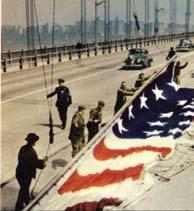
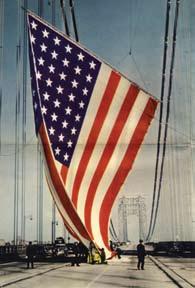
abo V e and right : In 1947, New York Mirror Magazine covered the erection of what was then the largest free-flying U.S. flag (90 by 60 feet). Annin’s client was the Port Authority of New York and New Jersey, which operates the George Washington Bridge. The flag was made of Nylanin, a tough nylon-wool blend co-developed by Annin.
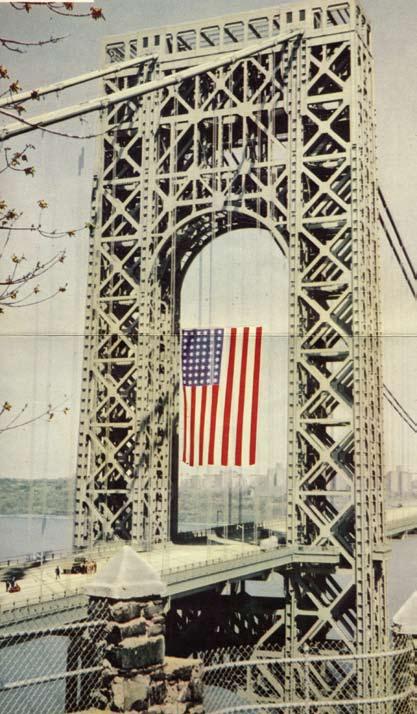
“ there’s a time for Flags”
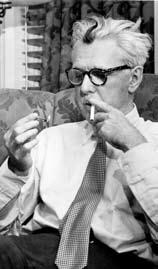
James Thurber was one of America’s top humor writers.
On January 14, 1950, The New Yorker published his story “There’s a Time for Flags,” set in “the famous Annin flag store, at 16th Street and Fifth Avenue.” The main character was a man who decided to buy his wife a U.S. flag for Christmas. Why? Because he dislikes crowded stores, and “hardly anyone would be shopping for a Christmas present in Annin’s in December.”
Comparing Annin’s hushed showroom to a cathedral, the character is waited on by a “gracious, competent, and unsuspicious” saleswoman. He buys a pole as well as a 3-by-5-foot woolen flag because the $5 flag “didn’t seem enough to pay for a gift.”
While the gift is hardly romantic, his wife is glad that her practical husband hasn’t bought her a dog kennel or croquet set. And the character himself muses: “I love the flag. As garish as it is, it has beauty, dignity, and even grandeur, and
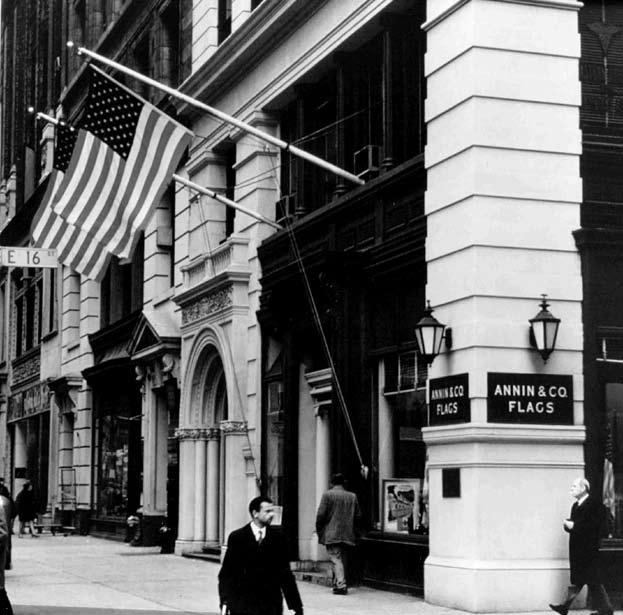
that is something of a miracle.” He worries only that flags will become popular as gifts, which would make Annin “just as crowded as every other store on Fifth Avenue.” H

cloc KW ise F ro M to P: Thurber set his story in Annin’s Fifth Avenue store, and illustrated it with this cartoon.
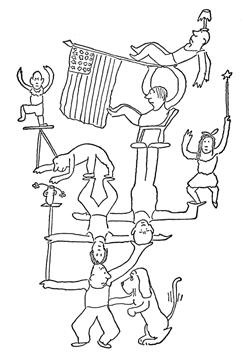
guilty in hearings at Federal Court in San Francisco. The judge acquitted Annin, determining “that the use of veteran’s priority . . . was not contrary to regulations or law, and there was neither fraud nor conspiracy involved.” Randy phoned his colleagues with the good news, drawing a parallel to a football game involving his favorite team: “What duke did to Navy, Annin did to the government.”
Randy II, Lee, and Jack began part-time work in the postwar years. “We and our friends all worked for Annin as teenagers,” Lee recalls with a smile. “That was the stomping grounds at 80 cents an hour, back in the late 1940s and early 1950s. Carloads of 30-inch and 24-inch wooden dowels for the stick flags would be shipped in by rail. We’d take the company truck, unload the boxcar, and bring these bundles of dowels back to the annex in Verona, which is still there. our job was to glue the gold spear tips on the top of the stick flags. Red Reese was our supervisor, and we drove him crazy, not working very hard and throwing spears around.”
“dullest job ever,” Randy II affirms. “by the time we put spears on for four hours, we were having spear fights. We had a couple of wild friends who livened things up. The trolleys that went up and down bloomfield Avenue used to pass in front. We’d dare one guy to stand between them as they passed. For a dollar, he’d do it. We’d all run outside at 10:45 A M dave would stand out there and the two trolleys would ring all their bells trying to scare him off. He’d actually brush against them; it was that close.”
The younger generation didn’t see much of Louis. “We didn’t know our grandfather well,” Jack says. “In those days grandparents were not like grandparents today.” Jack, Randy II, and Lee mainly recall Louis carving the turkey at Sunday dinners in his Essex Fells home. There were traditional custard pies cooling on the dining room sideboard, but never a television set in the living room. Louis chose not to have one. For recreation, the young men kicked around a soccer ball with Louis’s chauffeur, Roy, who had taught them all to play.
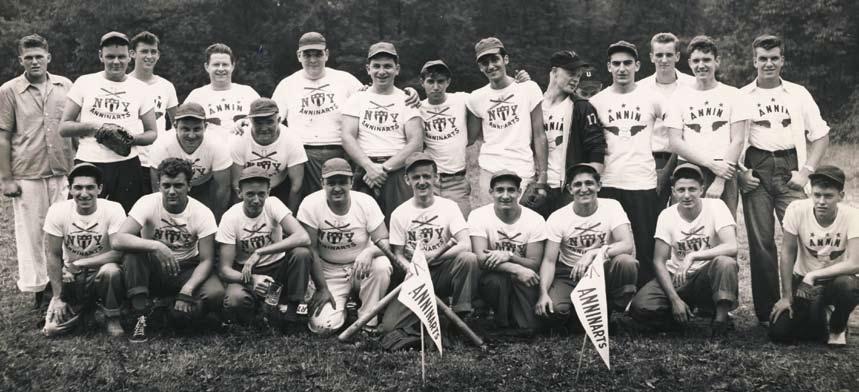
belo W le F t : Team players in 1949 included Randy Beard II (top row, third from left), Lee Beard (bottom row, far right), and Jack Dennis (top row, far right). As teens, all three worked summers at Annin for Red Reese (top row, fourth from left). across s P read : 1951 annual picnic. At far right, top row, Barbara “Bebe” Beard, sister of Randy II and Lee, sat on her dad’s shoulders.
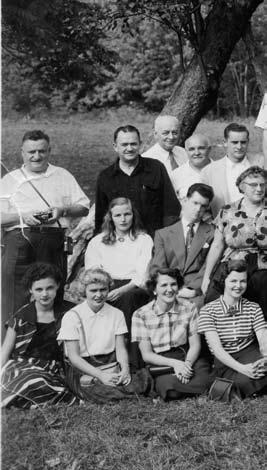
on days when Louis went to the Fifth Avenue offices, Roy would drive him to the train in Montclair in a stately Packard limousine with flags flying from each fender. but Louis commuted less and less, because of ill health. upon retiring in 1950, he placed 97 percent of Annin’s voting stock in his daughters’ hands. He probably expected his son-in-law to succeed him as president, but that plan ended when Randy left Annin after his divorce in 1952. Louis’s other son-in-law, Jack’s father, had not worked at Annin. And though the fifth generation had graduated from spear fights to more responsible summer jobs during college, they were not ready to run the company.
An era ended when Louis Annin Ames died on November 27, 1952. obituaries cited his affiliations as president of Annin and its real estate
subsidiaries, director of the Verona trust Company, former presidentgeneral of National Society of the Sons of the American Revolution, and numerous other ties. He was praised for preserving New Jersey’s state flag in 1936, a fight he championed because George Washington had designed the original. but it was an editor of Universalist Leader magazine, a minister who had known Louis for decades, who captured his essence as “a power in the economic, civic, and political life of Manhattan. . . . [yet] with all the demands on his time and energy from business and society, Louis Annin Ames took time to serve his church without measure and without stint.”
With Louis gone, a new era began with the appointment of digby Chandler as Annin’s first non-family president. H
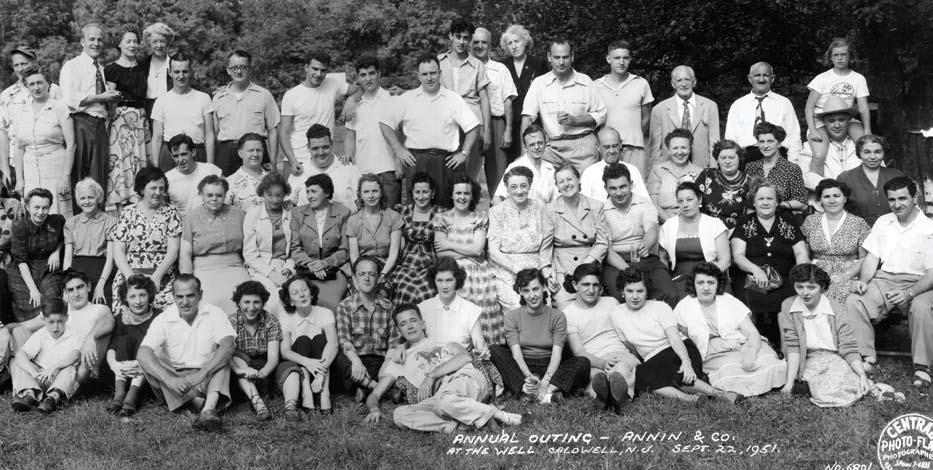

i talked to clients about quality and stressed the service annin was able to give.
— Digby W. Chandler, President, 1952
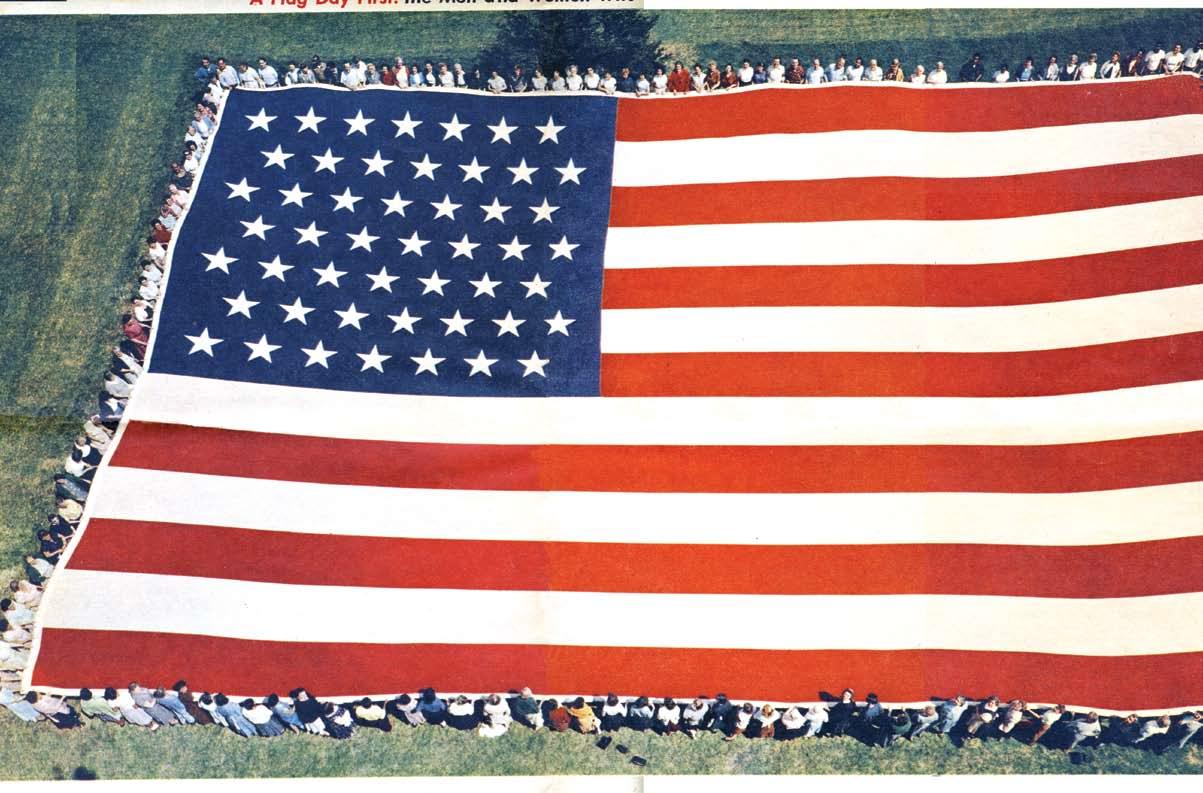

c ha P ter t hree

digby Chandler often talked about his first project for Annin. It had been a true test of artistic ability: from a small pencil sketch he had to accurately scale a 20-by-15-foot flag of Siam (now Thailand). The silk-screened flag would fly at the Waldorf-Astoria Hotel to honor a visit by the king. The design featured an elephant, a royal symbol in Siamese culture. “John Annin was pleased that all the pachyderm’s legs came out in the right places,” Chandler would quip.
The company Chandler took over from Louis Annin Ames 46 years later was a bit like an elephant itself: strong, long-lived, but generally not fast-moving. Chandler’s stubbornness was also an issue. The accounts he had cultivated, such as the boy Scouts and the American Legion, always came first. “He had his own little empire and didn’t want anyone else getting involved in it,” according to the late bill d wiggins, who worked with him for 30 years as a sales executive. Nor did Chandler spend time at the company’s operational center, the Verona offices and plant, other than for annual board meetings and union meetings. Like some Manhattanites, he generally pretended that New Jersey didn’t exist. Fortunately, Chandler had Randy beard II, Lee beard, Jack dennis, d wiggins, and other key players to balance his idiosyncrasies and extend his strengths. yet Chandler’s leadership served Annin well in the 1950s and 1960s. His design expertise provided a definite competitive advantage in an era marked by the growth of patriotic organizations, the addition of two states, and the rise of the united Nations. His arty persona—which included an ever-present carnation in his lapel and a spy camera in his breast pocket—made him a darling of customers and press agents. (He was probably the first person at Annin to do television—he was a
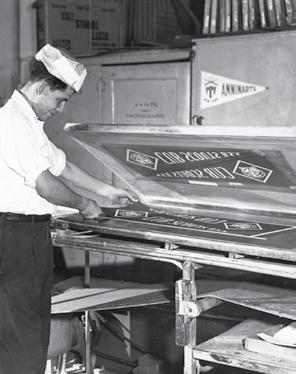
abo V e : Cub Scout pennant production, 1950s.
o PP osite : “So Proudly They Hail the 49er!” declared a New York Mirror Magazine article honoring Verona workers who produced this 90-by-60foot flag following Alaska’s statehood in January 1959. The 265-pound flag was obsolete by August 21, when Hawaii became the 50th state.
belo W: Digby Chandler as painted by Frank C. Bensing, a friend and famous portraitist whose subjects included Joseph P. Kennedy.
belo W right : Board members and spouses gathered after a meeting in 1964. Back, left to right: John Booth, Marie Booth, Digby Chandler, Randy Beard II, Dee Brassell, Len Brassell, John Brundage, and Ray Jones.
Front: Jean Dennis Jones and Mary Beard.
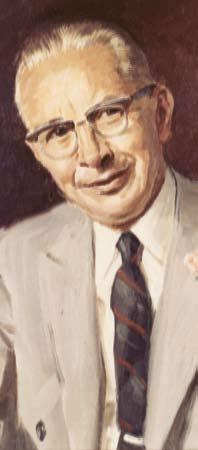
guest on “The tex and Jinx Show,” which featured witty banter by sophisticated New yorkers.) Annin benefited from the publicity he generated. Not least, he was a master at relationship selling, an all-important skill in the close-knit flag industry.
From his initial assignment to the end of his presidency, Chandler remained an artist by temperament and practice. He painted landscapes and he presided over the Salmagundi Club, an artists’ gallery and residence in Greenwich Village. He believed that artistic vision, not price, is what ultimately sold flags. Most of all, Chandler never stopped designing flags—for royalty and nations, corporations and schools, military leaders and yacht owners, and even for the east end of the bar at his favorite haunt, New york’s posh 21 Club.
Fifth generation comes aboard full-time
Randy II was the first of the fifth generation to come aboard full-time after college and military service. He started in the office in 1954, handling sales correspondence. (The sales and customer service functions were not yet separated.) Then he went on the road to ten Midwestern states. “In those days you went out for three weeks and didn’t come home on weekends and you drove it,” he recalls. The trips were grueling, but they were “a whole learning experience. . . . I became more interested in trying to figure out better and less expensive ways to make our flags.”
In fact, Randy had an interest in and aptitude for every aspect of the business. As the decade proceeded, he became a de facto general manager, similar to his father’s role in the 1940s. “It came to me by default after the
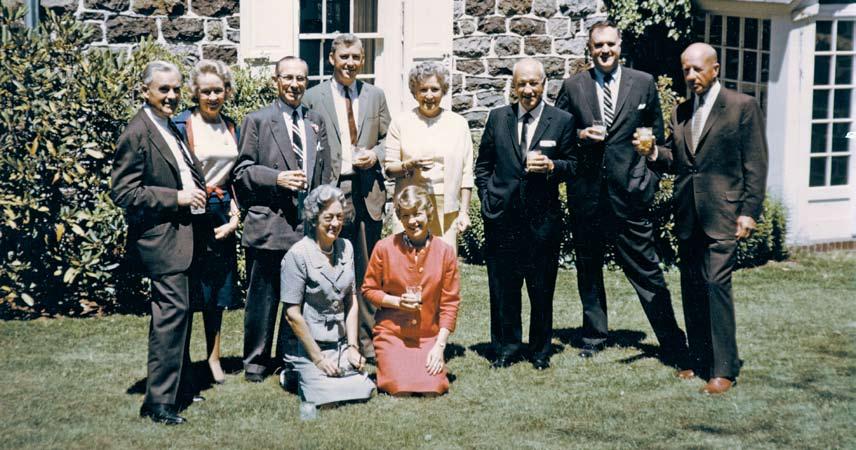
untimely deaths of two vice presidents, controller Stuart Cook and Michael Converse, who headed production,” he says. Cook and Converse died within six months of each other, and Randy took on many of their responsibilities.
From the start, Randy was an ideal foil to Chandler because he could see the big picture and analyze how the individual functions fit in. He also worked long hours, sometimes taking his daughters debbie and Ellen and son Cameron Randolph III with him on Saturdays. “I remember going as a little toddler with my father to the plant on weekends and feeling thrilled to see all the red, white, and blue,” said the younger Randy, vice president of corporate sales and custom business, who passed away in 2009 at the age of 50.
Jack, who worked briefly on Wall Street after the Army, started at Annin by “working in various departments and writing reports, which Randy would critique,” he says. With his gregarious personality, he gravitated toward sales. When the West Coast territory opened up, he jumped at it. He and his wife, Elaine, who met as summer workers in Verona in 1954, went on long sales trips by car for years.
“It was a big territory, 20 or 25 states,” Jack notes. because sales reps had to pay their own way then, Jack lived very frugally on the road. “one year the IRS couldn’t understand why my expenses practically exceeded my commissions.” The compensation changed from commission-based to salaried when Sears developed into Annin’s first major mass-market account. under a commission-only policy, the rep for Sears would have unfairly outearned all the others.
Jack would eventually leave the road for sales management, punctuated by several terms in the New Jersey State Assembly. He, too, put in his share of six-day work weeks. “My earliest memories of Annin were when my dad would bring my sisters and me in on Saturdays,” recalls Sandra “Sandy” dennis Van Lieu, now senior vice president. “Suzanne and Pam and I would race up and down in shopping carts and generally run amok.”
Lee started college in the early 1950s but came back to Annin fulltime in bookkeeping. Facing the military draft, he returned to school. upon graduation he joined the Navy. “I really enjoyed the service, so I thought I’d make a career of it,” he says. but when his brother asked him to return to Annin (“We needed him,” Randy says simply), Lee cast his lot with the family business. When he came back in January 1960, he saw for himself how much Annin had grown. He started in purchasing and developed an expertise in production.
right : Jack Dennis, Randy Beard II, and Lee Beard in 1992.
belo W: In 1962, at ages 5 and 4, siblings Debbie and Randy Beard III posed for photos that were used for years in Annin catalogs and ads.
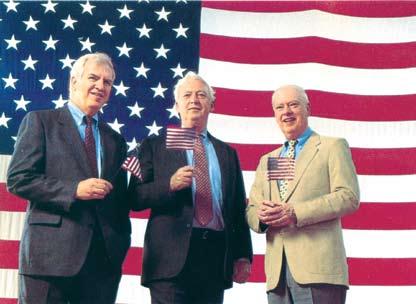
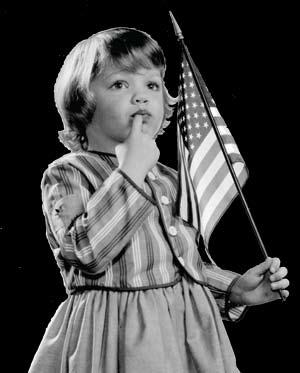

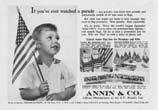
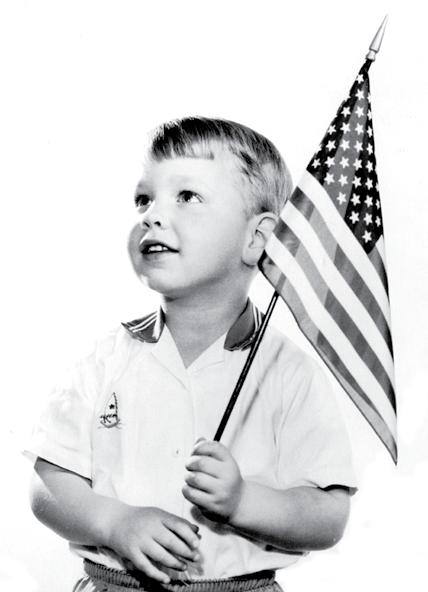
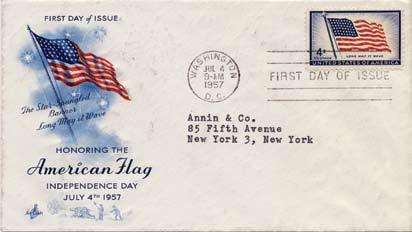
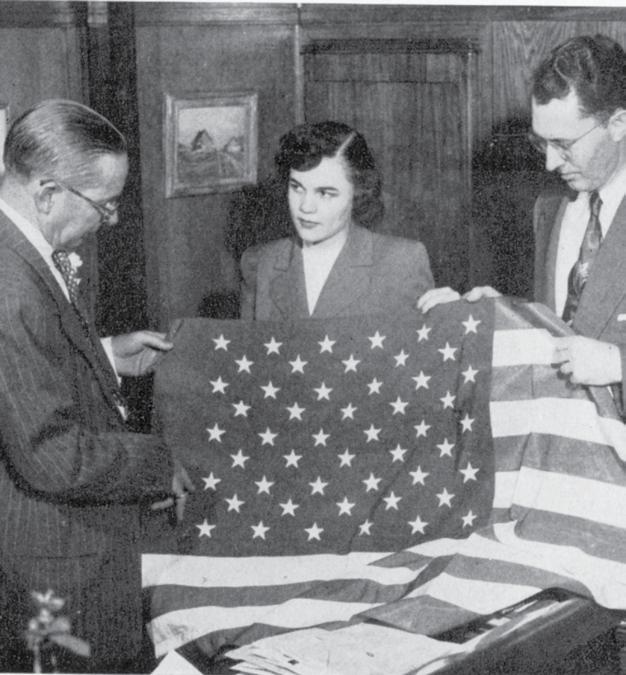
le F t : First-day issue of a new 4-cent stamp on July 4, 1957.
belo W le F t : A few years before the admission of Alaska and Hawaii, Digby Chandler (left) displayed a prototype of a 50-star flag to officers at Chase Manhattan, Annin’s bank.
belo W: In an article on Annin, Chase’s in-house magazine explained the choices. The U.S. government ultimately chose Chandler’s design.
The biggest event of the Chandler era was the statehood of Alaska and Hawaii, the first states to enter the union since Arizona in 1912. The question wasn’t whether they would be admitted, but when. And while a 49-star u.S. flag was fairly easy to envision—seven rows of seven stars, either staggered or aligned—a field of 50 stars was more challenging. It was also possible for the government to alter the star field entirely.
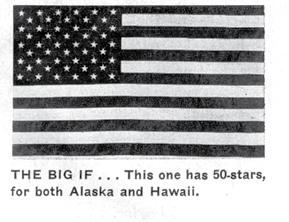
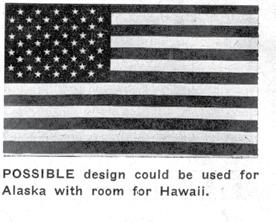
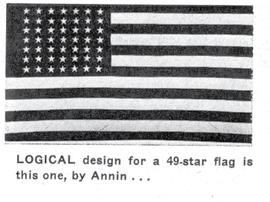
“digby’s 50-star design was the most logical,” Randy says. “He had a letter from the government acknowledging that his proposal, submitted in 1949, was the first received, and he rightly took credit” when his design was chosen from among 1,200 submissions. Columbia , a magazine published by the Knights of Columbus, an Annin customer, explained the elegance of Chandler’s solution: “A subtle staggering of the rows of stars to accommodate the newcomers without seriously impairing the flag’s symmetry.”
Flag makers and dealers had some frustrating times waiting for the government to act. The 49-star design still hadn’t been officially approved when Alaska joined the union on January 3, 1959. Hawaii was admitted on August 21 of that year. In the end, the 49-star flag was produced for only three months. to some it was a collector’s item, to others a white elephant. As soon as the government gave the go-ahead, Annin swung into production of 50-star flags. President dwight d. Eisenhower officially unveiled the new standard on July 4, 1960.
Sensing opportunity, new flag manufacturers popped up during this time. one firm was formed by Anthony and Michael Consi, who had learned the intricacies of flag production and sales during long careers with Annin. “ talented people,” Lee acknowledges. The Consi brothers weren’t the first Annin employees to strike out on their own, nor would they be the last. Private companies often “grow their own competition” when they hire and promote entrepreneurial-minded employees. Ex-Annin executives had a hand in the acquisition and founding, respectively, of CF (originally Chicago Flag) and FlagZone. Lee’s son Carter beard, current president, notes that “when new firms are started, they may take some business from us, but they steal market share from other competitors too. over the long run, it hasn’t really hurt us. Expansions of this nature help us broaden our market potential while expanding our expertise to meet the demands of our customers.”
Working day and night
Americans clamored for the 50-star flag. two subsidiaries helped Annin address the demand. The first was Caribannin, Inc., in Puerto Rico. Since 1950 its workers had appliquéd star fields for u.S. flags. (to appliqué means to sew on die-cut stars one by one, a labor-intensive process.) Eventually the government allowed stars to be embroidered instead of appliquéd, so Annin phased out the plant. today Caribannin is fondly remembered for the benign exchange of smuggled goods between Verona and Mayaguez. Packages of foot-long hot dogs from Pals Cabin would be sent in return for bottles of Puerto Rican rum, with the clandestine cargo camouflaged in boxes marked with an X.
Going forward, Annin would affiliate with a New Jersey supplier, Reliable, which had the Schiffli embroidery machines required for government work. It eventually bought Reliable, moved it to orange, and changed the name to New Constellation Embroidery Company. (The name comes from a phrase in the original u.S. flag resolution that “the stars will be arranged to form a new constellation.”)
of longer-lasting significance was the subsidiary danco, short for “division of Annin and Company,” which came into being when President Eisenhower decided that military flags should be made by private industry rather than the government. Having danco up and running by the end of 1958 allowed the Verona plant to concentrate on 50-star flags. Among Lee’s major projects would be to manage danco’s growth and expansion.
Flag demand further accelerated when John F. Kennedy won the presidency in 1960. Annin gently urged dealers to stock dyed flags and those with embroidered rather than appliquéd stars, because both are faster to make. “ to produce 100,000 sewed-star flags it is necessary to appliqué and trim 5,000,000 stars, so the enormity of the task becomes quite evident,” bill dwiggins often explained to dealers.
In this era Annin also became (and remains) the principal flag supplier to the united Nations. Founded in 1945 with 50 member nations, the u.N. added 57 members between 1952 and 1967. Some were newly independent countries with brand-new flags. “That was one of my favorite accounts because we had to get all those members’ flags exactly right,” dwiggins recalled. “The u.N. had an executive whose job was to check the designs we supplied. If we were a little bit off, we had to correct it. That precision did us a lot of good. We had a wonderful time with it.”
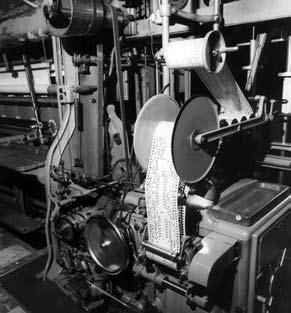
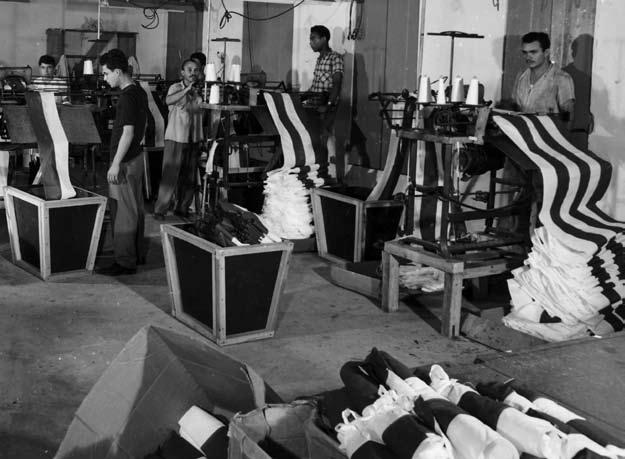
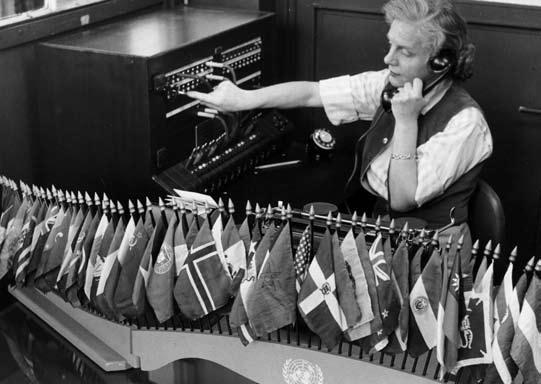
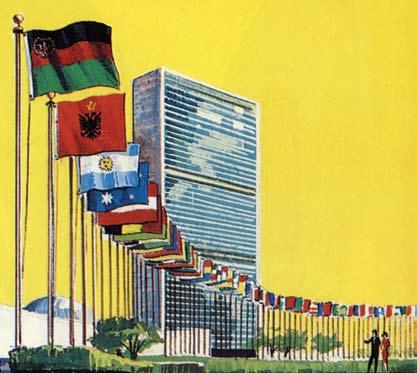
to support its full-bore manufacturing efforts, the company invested in office automation. First came a burroughs billing machine that “clunked around like a typewriter that could add,” in the words of Randy. Next came an early IbM computer, a punch-card system that handled order entry and inventory as well as billing and receivables. both Randy and Lee got involved in its implementation. While these technologies seem crudely manual today, they were innovative enough for a trade magazine called The Office to single out Annin for its “constant application of sound business policies and practices.”
Annin remained so busy that it delegated its marketing for the first time. The account went to Hayden Advertising, an agency in Montclair, New Jersey, owned by former Manhattan ad executive douglas Hayden. daniel “dan” Connors, a writer for Hayden who would later join Annin on staff, immersed himself in learning the business.
Among the agency’s many innovations were the creation of the betsy Ross Award and The Annin Banner, a newsletter that focused on flag history and etiquette. Its reputation quickly spread among vexillologists, a term for flag scholars coined by dr. Whitney Smith of the u.S. Flag Research Center. Smith himself was a frequent contributor, as was Lawrence Phelps tower, then the president of the u.S. Flag Foundation. The New york Public Library deemed the publication of such high quality that a full set is still archived there. In an early issue, Connors eloquently captured the spirit of the Kennedy era when he wrote that flying the u.S. flag had become “a dramatic, satisfying way of saying ‘There is no berlin Wall—no iron curtain—here.’”
In spring 1963, the tire company Goodyear unfurled what Lee called “the first flag promotion that ever happened in this country and the largest one ever for Annin.” In ads on television, radio, and in Life magazine, Goodyear explained:
“of the 46 million families in the united States, it’s estimated that only 10 percent own an American flag. . . . Goodyear, with the cooperation of the u.S. Flag Foundation, is making it convenient (and inexpensive) for you to own one . . . you may purchase it at Goodyear Service Stores and most Goodyear dealers for $2.57, complete with storage carton. This is our cost, plus handling. No purchase of other merchandise is required.”
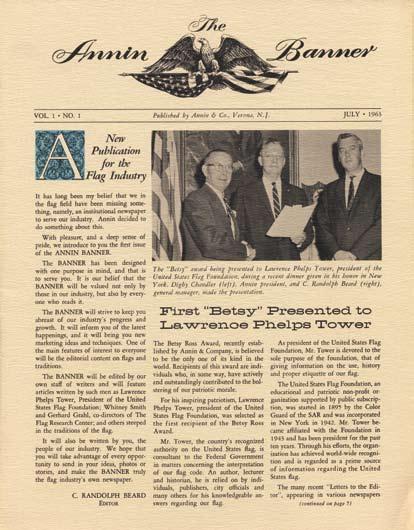
July 1963 marked the first issue of The Annin Banner.

the betsy ross award annin created the Betsy Ross Award to honor those who “actively and outstandingly contribute to the bolstering of our patriotic morale.” It was the brainchild of Randy Beard II, who saw it as an antidote to the trend toward disrespect for flags that took root in the 1960s. The first recipient, in 1963, was Lawrence Phelps Tower, president of the U.S. Flag Foundation. Among the many other honorees during the award’s 20-year lifespan were Vincent Baron of Wayne, New Jersey, who “rescued” a fallen flag from the roadbed of the Memorial Bridge in Washington, D.C.; Ralph C. Zimmermann, a German immigrant and American Legion Post Commander who created an “avenue of flags” through Glenside, Pennsylvania, as a visual protest against citizens who protested the Vietnam War; and the city of Columbus, Ohio, for its campaign that called on 5,000 businesses to fly the flag daily. H

That $2.57 was a true bargain: it bought a 3-by-5-foot cotton flag, complete with a 6-foot aluminum staff topped by an eagle, a cotton cord halyard, metal fasteners for wall or post mounting, and an official etiquette manual. “That is the basic kit you still see sold at Walmart and Lowe’s,” Lee notes. Though it’s hard to imagine now, Goodyear had to obtain legal and government approvals to offer the promotion. using flags in advertising was taboo then because the flag code had not yet been relaxed. but Goodyear’s effort passed muster as a public service program.
Annin was the sole supplier to Goodyear. Randy assigned Lee to set up a production line for it at danco, a responsibility that solidified his expertise in production. “We had the whole first floor doing nothing but this flag kit for about a year,” Lee recalls. danco outgrew its leased
right : A 1963 Saturday Evening Post ad for Goodyear’s flag kit.
belo W: The Danco plant in Bloomfield, New Jersey, where the Goodyear kits were made.
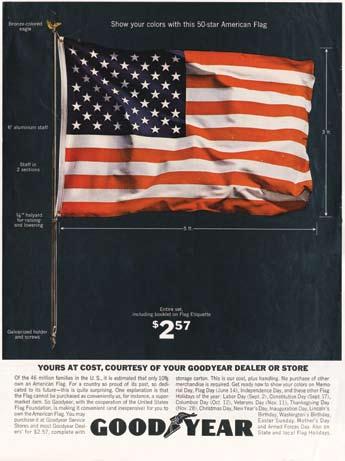
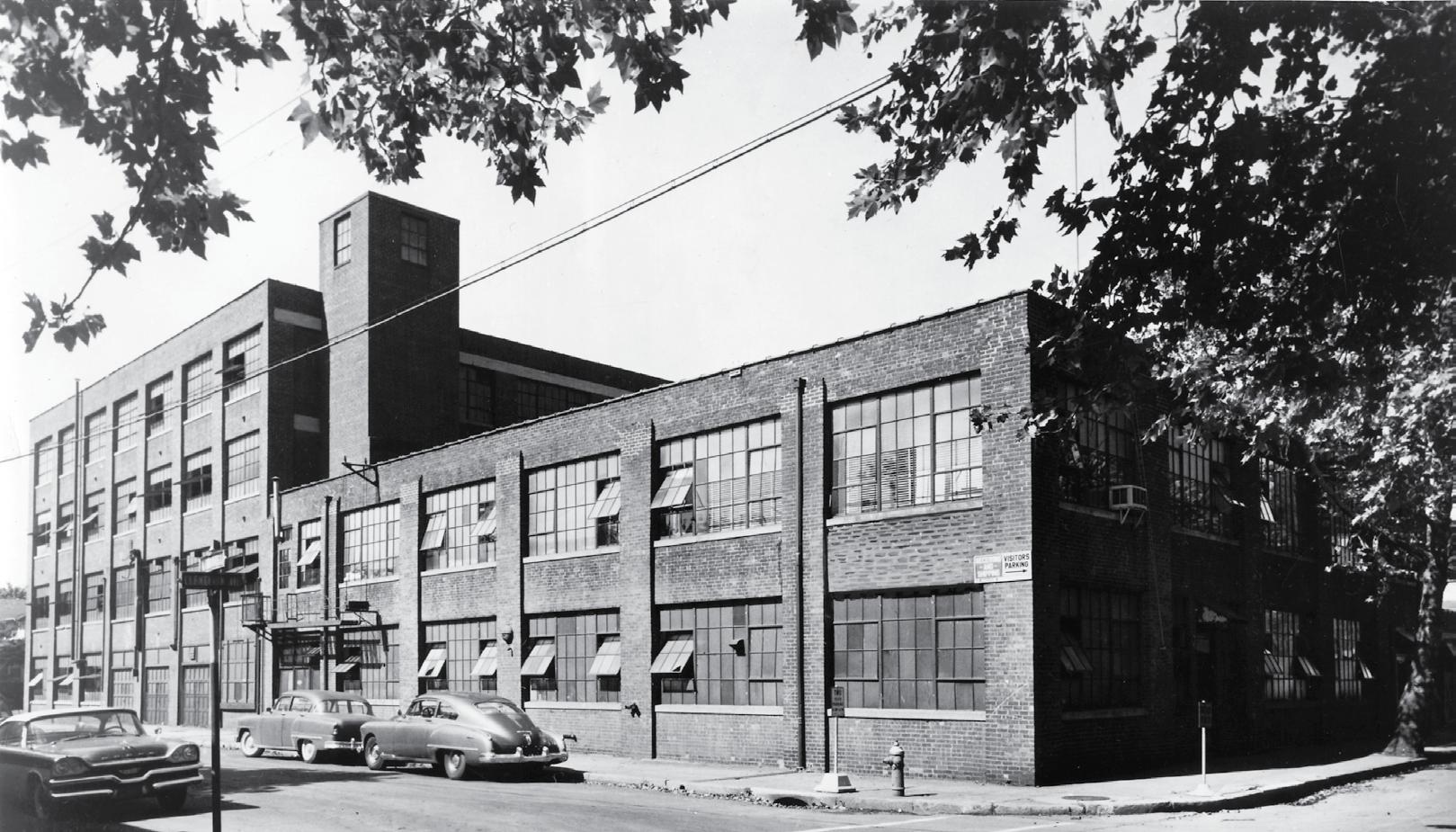
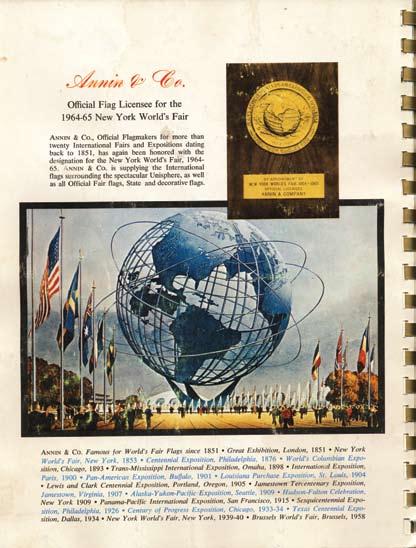
abo V e : Annin’s 1964 catalog featured the New York World’s Fair Unisphere and highlighted 113 years of flagmaking for expositions worldwide. The Unisphere, the world’s largest global structure, still stands in Flushing Meadows-Corona Park in Queens.
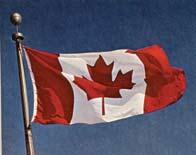
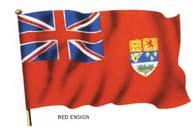
space in bloomfield. In october 1963, Annin bought a larger building at 88 Llewellyn Street to which it eventually moved the government flag work and the silk-screening of custom flags formerly done in Verona. on November 22, 1963, the editors of The Annin Banner were writing a cheerful holiday message for the december issue when the news of Kennedy’s assassination broke. The nation went into mourning. The newsletter went out as planned, but its page-one message quoted from the speech JFK would have given on the afternoon of his death: “We in this country, in this generation, are—by destiny rather than choice—the watchmen on the walls of world freedom.”
, to P to botto M:
present and former flags. The current design debuted at Peace Tower, Ottawa, Ontario, on February 15, 1965. Annin’s Toronto subsidiary operated from 1965 to 1986.
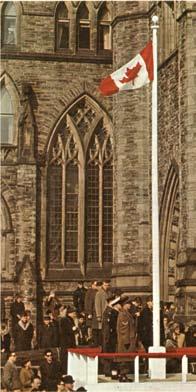
Annin’s growth continued with the creation of Annin Flag Co., Ltd., a toronto-based subsidiary, in 1965. Randy recalls how the company became interested in Canada: “I remember being at our Fifth Avenue offices one day and hearing a man say, ‘Is there somebody I can talk to about making flags in Canada?’ I introduced myself to him. He was an entrepreneur named tom Joy who recognized the potential of the upcoming Canadian centennial. He also had a contract with the Canadian Kiwanis Clubs, which promoted the distribution of flags. I realized we shouldn’t let this opportunity pass.” Annin did its due diligence on Joy, conferred amicably with the Canadian government, and decided to invest in a new operation in toronto.
Lee, who managed this major expansion, explains the strategy behind it: “Canada was finally adopting an official national flag. They had used a red ensign with the british union Jack and a coat of arms, but it wasn’t official. The centennial year of 1967 would usher in civic celebrations as well as a World’s Fair called Expo ’67 and the Pan-American Games. We knew flag sales would be strong. And because shipping flags up there from the u.S. incurred a high duty tax, Canadian-made flags made sense both for the manufacturers and the customers.”
to set up the plant and hire the staff, Lee relocated to toronto in winter 1965 with his wife Ann and their daughter Kendra, then a toddler. They returned to New Jersey in time for the birth of son Carter Lee Jr. in May.
Canada’s official flag, unveiled in February 1965, features the nowfamiliar red maple leaf on a field of white bordered by red panels. It indeed
sparked an unprecedented demand in advance of the Centennial year. Annin’s Canadian presence helped make it the official supplier to the PanAmerican Games and, later, to various Canada day celebrations. “Slowly but surely, it made a profit,” Lee notes. The subsidiary would serve Annin well for 21 years.
chandler’s final years
Randy essentially ran the company as Chandler’s health declined. but the president stayed involved, and was an artist to the end. “digby had lost his leg to diabetes,” Lee recalls. “He took a second-floor apartment across from our New york offices, where he could sit in his window and watch the company and the street. He had been president of the Fifth Avenue Association, which had a requirement that every building had to fly a u.S. flag. I’m sure digby got that clause into the charter. Every morning he’d check to see who was flying a flag and who wasn’t.”
one of the merchants on Fifth Avenue then was the American tobacco Company, which also flew its corporate flag. “An Indian head in full dress” is how Lee recalls the design. “It called for a lot of hand painting. They would order it in a 10-by-15-foot size, quite large. one of our better hand painters in Verona would paint it. before we could ship it out we would have to bring it to New york for digby to review. I would lay it out on the floor of his apartment. He would say ‘the eye doesn’t have the right twinkle’ and suggest this or that. I would bundle it up, take it back to Verona, and try to convey his thoughts to the painter, who thought he was crazy. We did this two or three times before he approved the flag.”
The company threw Chandler a testimonial dinner in 1965 to celebrate his 60 years at Annin. It took place, of course, at his beloved 21 Club. one of the stories recounted by his legion of friends that night involved his loathing for abstract art. “He always said he had gone to the Museum of Modern Art and actually turned a painting upside down, and that it went years without being discovered,” Randy recalls. A tall tale, probably—but maybe not.
Chandler died in 1967, having contributed “dignity and personality not only to our company but to the entire flag industry,” as The Annin Banner noted. He had also designed more flags than any other American.
Having served as president in all but title, Randy was the natural successor. H
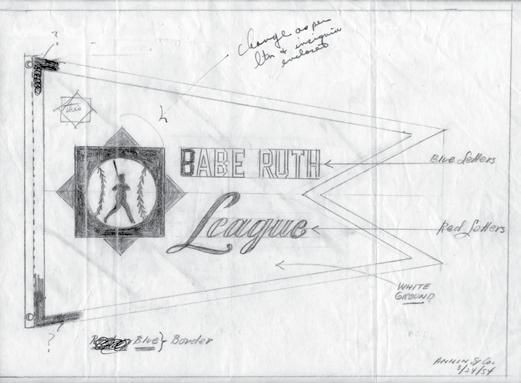
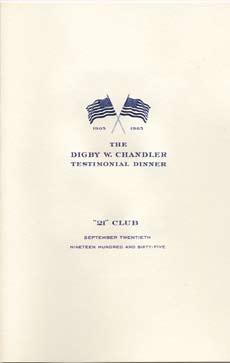
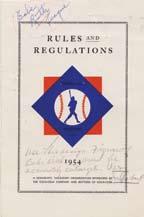
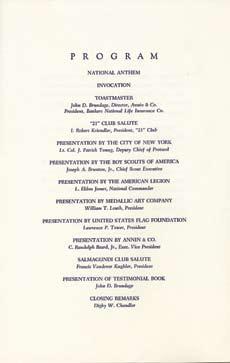
le F t : Annin has always created custom pennants and flags. A note on the sketch for a 1954 Babe Ruth League pennant referred to the League’s logo at right: “Use this design. Figure of Babe Ruth must be accurately enlarged. Very important.”
belo W le F t : In 1965 the company celebrated Digby Chandler’s 60 years at Annin with a gala dinner at the 21 Club, his favorite Manhattan night spot. Colleagues and fellow artists gave testimonials. Chandler designed thousands of flags, more than any other American. He liked to tell the story of how he refused a commission from the Frank Sinatra Fan Club to make a pennant from a stolen Sinatra shirt. “I was afraid it might encourage a deluge of celebrities’ shirts, shorts, pants, and lingerie,” he quipped.
i ended up where i did by coincidence of age and place. leading annin was my fate, and i tried to do my best at it. every year brought challenges. i put a lot of hours in. i tried to keep family involved and engaged, children and cousins and nieces and nephews. that was important to me.
— C. Randolph Beard II, Chairman of the Board and retired CEO, 2007
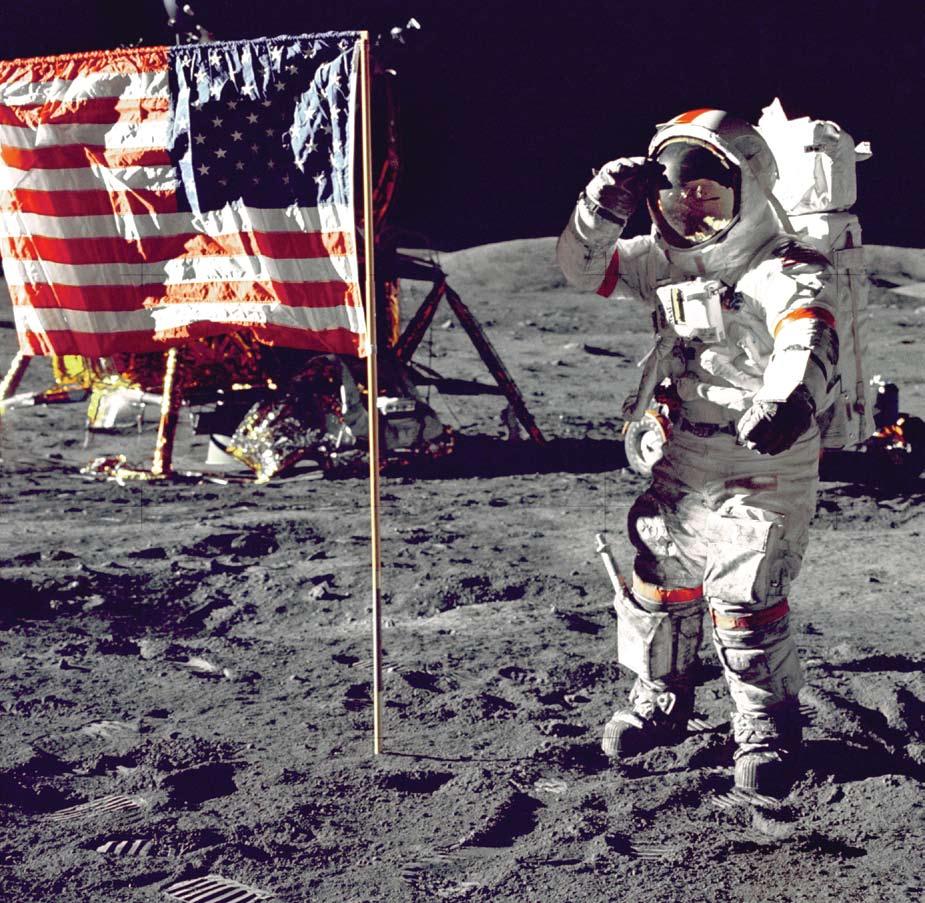

c ha P ter F our

Richard Caramagna has worked for Annin for almost 40 years. He tells a story about retired CEo Randy beard that captures Randy’s devotion to the business.
“I worked at danco when answering machines first came out,” Rich says. “In the morning I’d come in, and the light would be blinking, and there would be a message left at 3:00 A . M.” A prank? No, the caller was sure to be Randy. “At first I said, ‘What is this guy doing up at 3:00 in the morning and why is he thinking about danco?’ but that was Randy. Very hands on, always accessible. during the day, he would constantly carry around a yellow legal pad. His pencils were always chewed. He’d write page after page after page of notes and hand them to you, a project for you to implement. That was Randy, too—it looked like he was dashing it off, but it was a wellthought-out plan.”
“Randy ran the company, no question,” affirms Henry Hibo, retired vice president of finance, whom Randy hired shortly after becoming president. “He’d be there on Saturdays, Sundays. Weekdays, people tried to stay out of his office after 4 o’clock. A conversation with Randy could go for two or three or four hours. He just loved to talk. He listened, too. In Verona, his office was right next to mine. one time he walked in at 4:30 and we stayed until midnight.” The subject of these discussions? Always, says Henry, it was the company’s future.
“committed, self-motivated, close to the market”
Randy strove to keep the company family-oriented and committed to top quality. At the same time, Annin had to become more structured and faster-moving. The rise of big-box retailers and the growth
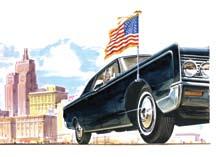
abo V e : This mid-1960s illustration for Annin’s fender flag holder, drawn in the “Mad Men” advertising style of the decade, appeared in several catalogs.
o PP osite : During NASA’s final lunar landing mission, Apollo 17 commander Eugene Cernan saluted the flag on December 11, 1972. Annin has supplied NASA with many flags over the course of the space program, including those used on the Apollo moon missions.
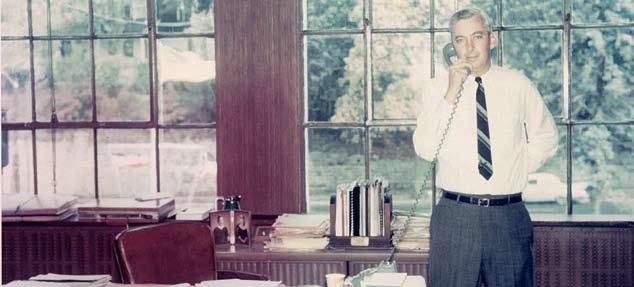
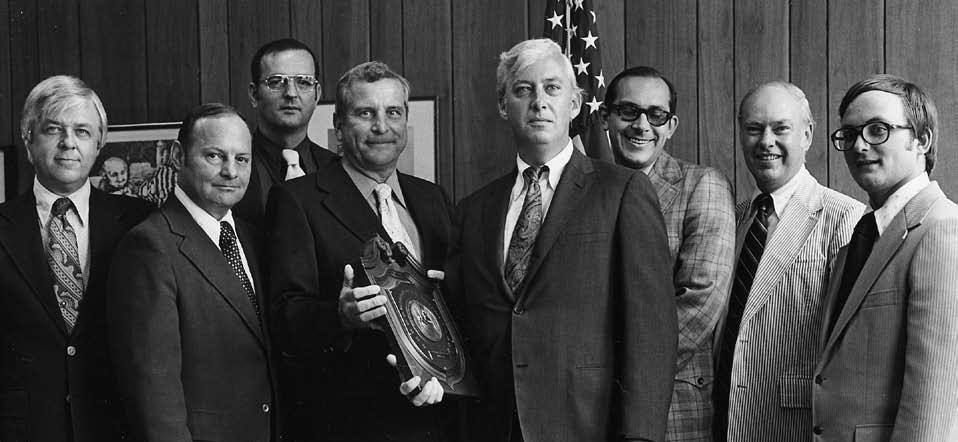
to P: Randy Beard II in Verona on the day he was elected president in 1967. Behind his desk were photos of two of his children, Randy III and Debbie, and a historical bookcase (see page 86 for close-up).
abo V e : An executive from the Freedoms Foundation at Valley Forge (fourth from left) presented an award to Annin in 1976. Flanking him at the ceremony were (left to right) Annin’s Dan Connors, Walter Kelly, Robert Kopet, Randy Beard II, Henry Hibo, Lee Beard, and Ed Gregory.
of technology were turning America into an on-demand, instantgratification marketplace. As late as the 1970s, for example, Annin typically fulfilled custom orders in eight to ten weeks and stock orders in five days. (There were exceptions, of course, such as the time in 1972 when the company rushed to create two large flags for the admission of the People’s Republic of China delegation to the united Nations. Working from nothing more than a picture of the brand-new design, the designers and seamstresses produced the flags in 24 hours.)
today those delivery times seem unbelievably slow. by the late 1990s, ten weeks for custom work had shrunk to ten days or less, while “in by 3:00 P.M , out the same day” became the norm for stock items.
The acceleration took time, but Annin accomplished it. Randy attributes the company’s success to the full support of talented executives such as his brother Lee, who directed major manufacturing and technology initiatives; his cousin Jack dennis, who pursued a political career but returned to sales management; Henry Hibo as vice president of finance; and plant managers Edward “Ed” Gregory at danco and Joseph “Joe” Vallone in Verona—as well as many other long-time managers and employees who devoted their work lives to Annin.
Several people who remain instrumental to Annin came up through the ranks in these years: Rich Caramagna, currently the vice president of operations; Carolyn Albanese, director of customer relations and development; Robert “bob” Caggiano, vice president of commercial sales; and david “dave” Gregory, director of purchasing. (dave is a younger brother of the late Ed. “Eight of us in my family worked here at one time or another, just about everyone except my parents,” dave notes. Annin’s family-friendly culture is not limited to the beard and dennis families.) In the same time span the sixth generation came of age. Randy’s own son Randy, Lee’s son Carter, and Jack’s daughter Sandy went from being teenage part-timers to seasoned executives themselves.
“It was this combination of family and nonfamily members that achieved success,” Randy emphasizes. “Their time commitment, dictated by the realities of our industry, was awesome. They’re committed, selfmotivated, close to the market, and responsive to customer demands. We’re lucky to have them.”
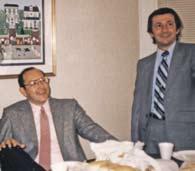
abo V e : Henry Hibo and Joe Vallone, 1985, in the annex Annin briefly rented at 159 Bloomfield Avenue, Verona.
belo W: Annin’s ad agency developed Apollo 11 art for promotional use.
right : Created by Annin’s bank in the mid-1960s, this ad anticipated the company’s role as a supplier to NASA.
Flagmakers to the universe: the moon flags
Even in Louis Annin Ames’s day, Annin had its eye on the moon. “Company officials are serenely certain that when the time does come, it will be an Annin banner that mankind carries into outer space,” reported Columbia magazine in July 1952. Sure enough, when Apollo 11 made its historic lunar journey in 1969, its cargo included 186 Annin Empire brand foreign and state flags that Astronauts Edwin “buzz” Aldrin, Neil Armstrong, and Michael Collins would later distribute as mementos.
but was the American flag in the iconic moon-walk photograph made by Annin? officially, the National Aeronautics and Space Administration wouldn’t say. “NASA didn’t want another tang incident,” Randy notes, referring to a powdered beverage whose sales soared after its NASA connection was publicized. A government spokesman told Randy that NASA intended to construct the lunar banner from cut-apart flags procured from several suppliers, in part so that no single company could take credit. to fulfill this plan, “three secretaries were sent out to buy 3-by-5-foot nylon flags on their lunch hours, NASA told me,” Randy says. It was believed that all three bought their flags at Sears, to which Annin was then the sole flag supplier. but that story, as well as the cut-and-piece-together story, may have been red herrings. An investigative article in The Raven, the journal of the North American Vexillological Association, later concluded: “It is uncertain who manufactured the flag that was deployed by the Apollo 11 crew.”

There’s no question NASA doctored the flag planted by Aldrin. because the moon has no air, the flag had to be made to look like it was flying. NASA achieved this by pre-stiffening the material, adding ripples, and constructing a push-up device akin to an umbrella opener. The actual flag has long since disintegrated.
Annin shared NASA’s desire not to commercialize the moon flag. Company ads and literature generally say only that the lunar mission carried Annin flags. but a retired NASA official told company executives that the photographed flag was unquestionably Annin’s. This executive, William Whipkey, worked in the technical services area for NASA during the 1960s and 1970s, and personally dealt with bill dwiggins at Annin.
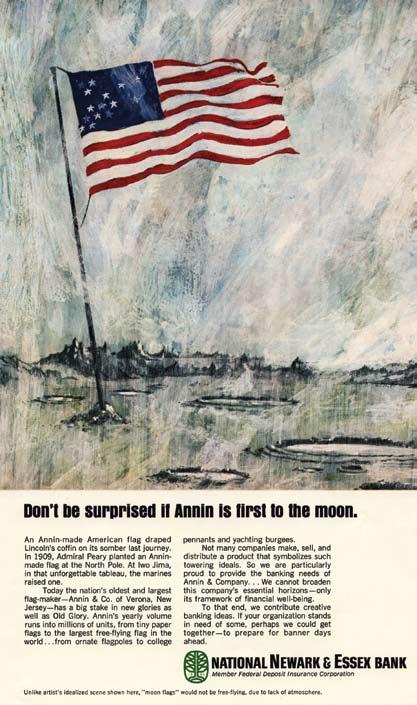
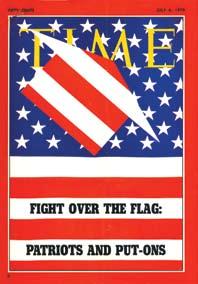
Flag controversies, rampant in the U.S. during the Vietnam War, became the cover story in Time magazine on July 4, 1970.
The American flag also became a kind of battleground in the late 1960s, as feelings raged over the country’s involvement in Vietnam. War protesters burned flags or wrapped themselves in them. War supporters flew even more flags. What was right and wrong couldn’t easily be defined, since the relaxation of the flag code in the early 1960s had erased strict boundaries.
Annin experienced a surge in sales, especially of 4-by-6-inch aerial flags for cars, and the Reader’s Digest fulfilled 30 million orders for flag decals. bill dwiggins speculated that “the middle-of-the-roaders are beginning to feel their oats a little.” ultimately the u.S. Supreme Court ruled that flag burning was symbolic speech and thus protected by the First Amendment of the Constitution—but the issue has emerged again and again.
From the ashes of these divisive protests, it might be said that a unifying phoenix arose: the PoW-MIA flag. It came about when Mary Hoff, a military spouse and member of the National League of American Prisoners and Missing in Southeast Asia, contacted Annin about creating a flag for the group. She reached the sympathetic ear of Norman Rivkkes, then vice president of sales, who in turn asked the company’s ad agency, Hayden, to help. The assignment fell to the ideal person—graphic designer and World War II veteran Newton “Newt” Heisley.
“I used to fly within range of the Japanese and wondered how I would hold up if I ever got captured,” Newt said. “When I did the design, I thought how easy it would be to forget those guys.” That sentiment gave rise to the flag’s now-familiar slogan, “you Are Not Forgotten.” The inspiration for the gaunt silhouette was Newt’s son Jeffrey, who had returned home in a weakened state after falling severely ill during Marine Corps combat training.
Surprisingly, Newt never planned for the PoW-MIA flag to be black and white. After submitting several pen-and-ink designs to the League, he expected to add color to whichever one they chose. but the group preferred the somber motif.
Annin manufactured the first PoW-MIA flags, and still sells tens of thousands each year. However, as Newt wished, the image was not copyrighted. It can be freely reproduced and has been used on fundraising items for various veterans’ causes. No one foresaw the flag’s lasting power. Since 1989 it has been the only flag other than the American flag itself to be installed in the Capitol rotunda. And in 1997 President bill Clinton
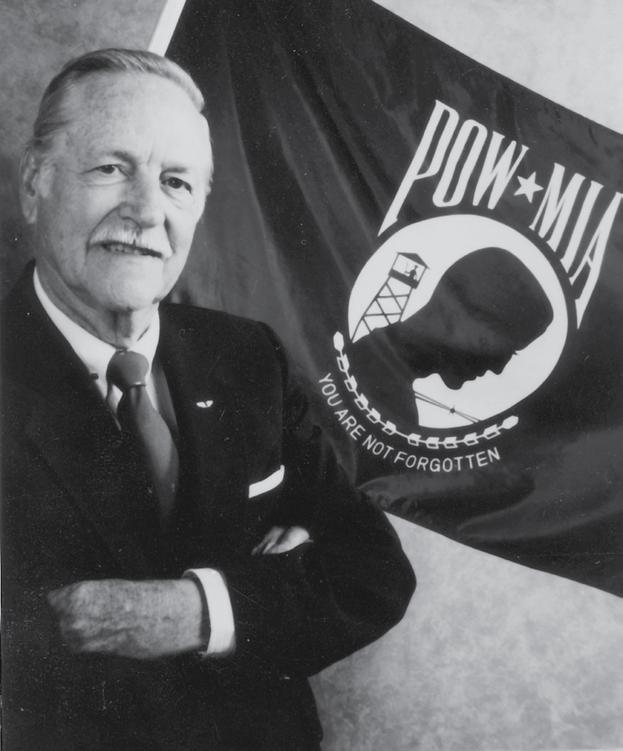
abo V e : Newton Heisley worked for Hayden Advertising, Annin’s ad agency, when he designed the POW-MIA flag in 1971.
right : By law, the U.S. flag and POW-MIA flag must fly together at military installations and most federal buildings. Seen here is Veterans Plaza in Roseville, California, home of an Armed Forces Career Center.
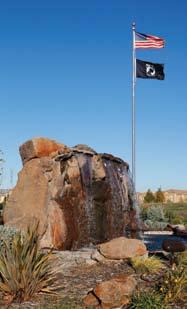
signed into law an act that requires the PoW-MIA flag to be flown at military installations and most federal buildings.
innovations and an acquisition during these years Annin kept up its innovations. It unveiled AcrylANNIN, an acrylic material originally developed with Chemstrand Company in response to the Navy’s request for brighter and sturdier signal flags, and Nyl-Glo, a type 6-6 nylon woven fabric for outdoor flags. Even flagpoles and floor stands saw changes, as styrene and other synthetics replaced metals like iron.
Annin also upgraded to an IbM System 3 Model 10 computer with 96-column keypunch cards for order entry. “IbM was king,” recalls Lee beard, who oversaw this and other technology transitions. Although primitive by today’s standards, the “new” system facilitated operations at a critical time. With the 200th birthday of the united States approaching, Annin had been named the official supplier of the American Revolution bicentennial Administration (ARbA), as well as New Jersey’s exclusive bicentennial flag designer.
to help prepare for the demand, Annin acquired Colonial Flag Company of Coshocton, ohio, a smaller competitor founded in 1967 by Vane and barbara Scott. The purchase expanded Annin’s production capacity by 20 percent. Randy explains the story behind it: “Colonial had already been bought out by somebody else, an investor who didn’t believe women should be managers. He said to Vane, you are the president. Vane said, ‘No way, my wife and I are both presidents,’ and that is when the company went up for sale again. I visited the Scotts and convinced them we didn’t have the same attitude.” Flying home from ohio, however, Randy had second thoughts—not about the gender issue, but about Colonial’s overall value. A customer’s desire for inventory helped Randy make the decision.
“The following day, probably with bill dwiggins, we had a meeting with J.C. Penney Company in New york,” Randy recalls. “They were putting on a big effort for the bicentennial. Their executive didn’t want Penney to be left out. He was willing to put up $50,000 towards Annin’s purchase of Colonial [if it ensured capacity for Penney’s order]. I went down to the street, called Colonial’s owner on a pay phone, and made our bid. Penney’s willingness to put some cash up made the purchase a lot easier.” As promised, the Scotts stayed on as co-equal plant managers.

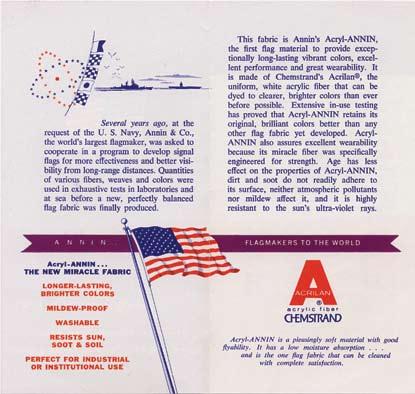
abo V e : A type of woven nylon, Nyl-Glo was developed to increase the sturdiness of outdoor flags. le F t : As a 1966 flyer explained, “Acryl-ANNIN retains its original, brilliant colors better than any other flag fabric yet developed.”
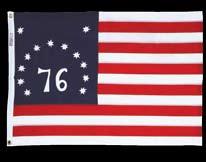
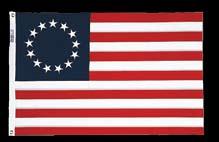
abo V e : Especially popular during the U.S. Bicentennial in 1976, the 13-star Bennington (top) and Betsy Ross flags still sell well.
right : The brainchild of Bicentennial entrepreneurs, this ill-fated flag on the Verrazano-Narrows Bridge in New York Harbor shredded within hours.
During the Tall Ships weekend, Annin hosted a Bicentennial reception on the U.S.S. Intrepid, docked in Manhattan.
the bicentennial and annin as a melting pot
The Colonial acquisition helped Annin achieve two record sales years during the bicentennial. Curiously, ARbA’s official bicentennial flag, which featured a double star symbolic of two centuries, wasn’t the sales leader. In one of those mysterious twists of taste, buyers gravitated toward two older designs: the bennington “76” classic, carried by the Vermont militia in the battle of bennington and claimed by some to be oldest flag flown in battle by u.S. ground forces, and the 13-star flag, originally adopted by Congress on June 14, 1777. (The latter, legendarily attributed to betsy Ross, probably wasn’t made by her at all.)
old-timers at Annin also remember the bicentennial as the time of the “Great American Flag Experiment.” two entrepreneurs hatched the idea of raising a mammoth flag on the Verrazano-Narrows bridge, within
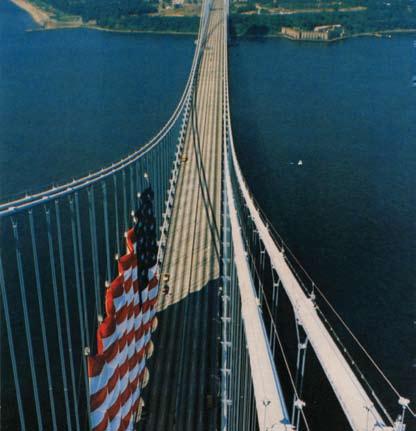
sight of the Statue of Liberty and the tall Ships celebration in New york harbor. The flag they commissioned measured 1.7 acres, one-and-a-half times the size of a football field. Annin’s role was to furnish the nylon fabric at cost and appliqué the 11-foot-wide stars. A Massachusetts sailmaker sewed the stripes and constructed the whole. but the flag proved too big to be practical. Light winds whipped it against the bridge’s steel cables, shredding the stripes within a few hours. (The star field remained intact.) The promoters breathed a sigh of relief when the 3,000-pound behemoth was safely removed.
Annin celebrated America’s 200th birthday with a reception on the u.S.S. Intrepid for guests from the u.S. Flag Foundation and North American Vexillological Association. The entire country got a glimpse of the company at work in “Life,” an NbC television documentary by david
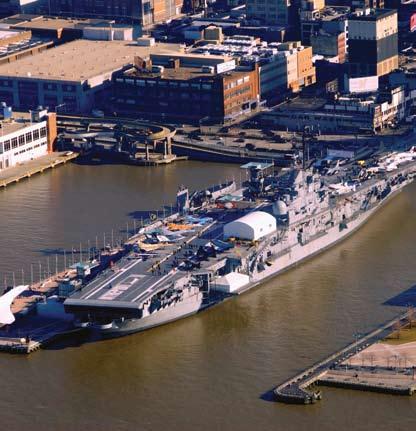
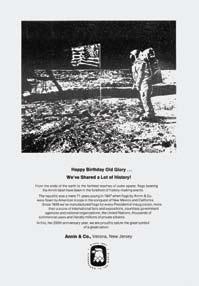
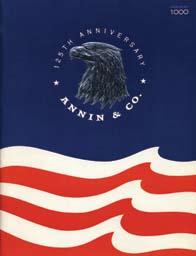
brinkley about immigrants to America. In 1976, most of Annin’s Verona and bloomfield plant workers were Italian immigrants or their descendants. bob Caggiano says, only half-jokingly, “back in the 1970s, if you were from a good-sized Italian family in this area, there was a 75 percent chance you had family members working at the Annin factory.”
In America’s melting-pot tradition, Annin remains hospitable to various ethnicities. “We had people of 30 different nationalities making custom flags in Verona,” retired plant manager Joe Vallone notes. “our largest contingent in recent years was from South America, especially Peru and Colombia, and the next largest was from Egypt and Lebanon. Sewing is still an honored profession in these cultures, for men as well as women. of course, plenty of American men sew flags too, at our plants in Virginia and ohio. The history of Annin is the history of America with a human face.”
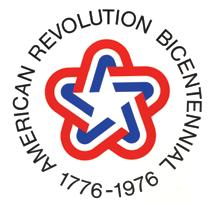
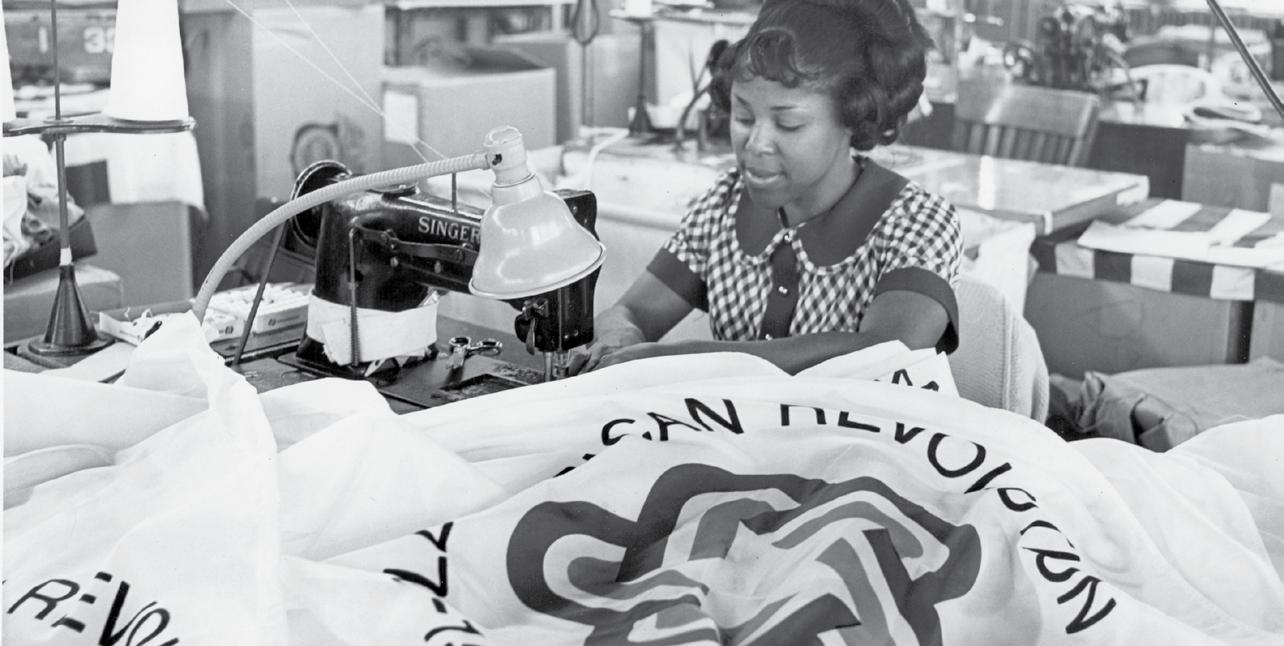
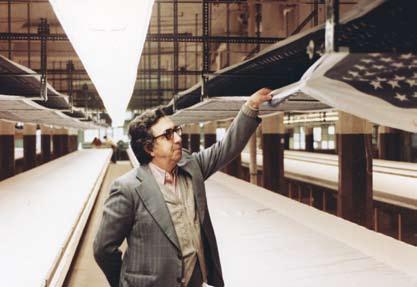
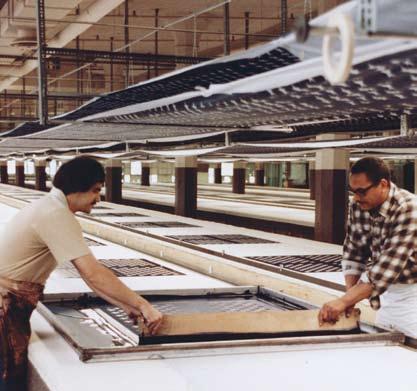
In the late 1970s, Annin created separate sales, order entry, and customer service departments. bob Caggiano oversaw service on orders, quotes, and shipping information so that sales vice president Walter Kelly and territory managers Jack dennis, bart deSandre, Henry Euler, bill Emmons, Pat benson, and bill dwiggins could concentrate on selling. This was such a big change for customers that The Annin Banner had to gently remind them to “ask for ‘Customer Service’ the next time you call.”
Jack, who left the road to become sales manager in 1980, chuckles at the memory. “In the old days everything was local, and each customer had its own little niche,” he notes. yet the personal touch prevailed. “Shipping was still in Verona, and when orders came in we would constantly run downstairs to see if we actually had the product,” bob says. “We got stock status reports at 8:30 on Monday morning, but by 8:31 they were obsolete,” adds Carolyn Albanese. “So we spent a great deal of time going to the warehouse to check the inventory.”
As the custom flag business grew, Annin turned danco’s first floor into a silk-screening facility. “It became bigger and bigger,” says Lee, who managed this growth phase. A trial run with a silk-screening operator in Jersey City had not worked out. In 1982 Annin moved the silk-screening to larger rented quarters in Harrison, New Jersey. “A tough operation,” recalls dave Gregory, who worked there one very hot summer. “one elevator, and you had to fight to get in it. And Randy always wanted things kept very clean. Although Annin had old buildings, he insisted on cleanliness.” With other floors in the Harrison building occupied by a pet food company, keeping the premises vermin-free was a constant battle.
Around the same time, Annin hired its first director of engineering research, Vivian Pacia, a Harvard-educated Ph.d. one of her key projects was to explore the feasibility of a machine that could make a flag from start to finish. She and Randy commissioned prototypes from an engineer. but such automation proved impossible; flagmaking remains an intricate craft that requires human talent. Annin did develop the most durable outdoor flag fabric, however: tough-tex, a two-ply spun polyester, engineered for long life expectancy under high winds and other severe stress conditions.
Another breakthrough occurred when dale Coots, who began working at Annin in 1983, joined the outside sales force in 1984. As
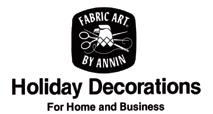
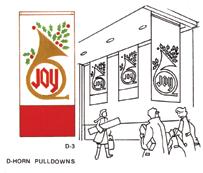
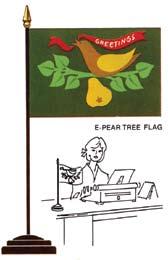
abo V e : Samples of decorative flags from Fabric Art by Annin.
le F t : Plant manager Nishan Ohanian (top) and employees at the silkscreening facility in Harrison, New Jersey, in 1982.
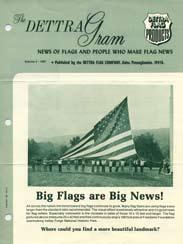
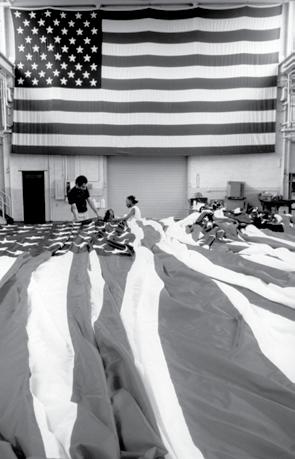
to P: Then a competitor to Annin, Dettra noted the trend toward bigger flags in a 1981 newsletter.
abo V e : Big flags being produced at Annin in 1987.
Annin’s first woman in outside sales, her initial territory, the New york metropolitan area, soon expanded to include the Southeast. dale spent 14 years in inside and outside sales before becoming the company’s marketing manager in 1999. Along the way, she has become the resident “historian” on flag history and etiquette.
The task of shutting the Canadian subsidiary fell to Lee in 1986. From a financial perspective, says the former CEo, “It probably should have been closed sooner. Canadians don’t fly flags the way we do.” Management turnover helped seal the closure decision. Annin sold its inventory, closed its books, and trucked its files back to New Jersey, where business was lively.
“a very hectic time” on one level, flags are simply consumer products. but they carry deep emotional connotations no other product does. For that reason, notes former president Lindley Scarlett, “the industry doesn’t lend itself to typical promotion. you can’t go on television and do some great big advertising that pushes your sales through the roof. you can’t load up dealers with a lot of product because they only have a certain amount of money to spend.” While sales do tend to move in tandem with the larger economy, the marketing challenges “put a premium on making a real quality product and having a quality organization behind you.”
Annin drew on those strengths in the mid-1980s, when President Ronald Reagan’s outspoken patriotism boosted flag demand. There was a move toward super-sized u.S. flags, with 20-by-30-foot flags commonly displayed by car dealerships and roadside restaurants. Flags up to 30-by60 feet became stock items. Various events also kept things hopping. In 1986, Annin manufactured flags for the Statue of Liberty centennial and the imminent relaunch of the 200-year-old warship u.S.S. Constitution. Sandy dennis Van Lieu, who was then in college, recalls sharing an office that summer with her cousin Randy and “being on the phone with customers all the time.” Randy made the leap into sales that season. He had joined Annin full-time after working for several years at the Republican Senatorial Committee and Pitney bowes. “All the parents wanted us to get some experience outside,” he noted. Like Sandy, Randy cut his teeth in Annin’s customer service department and found it was “great training” for his career in sales.
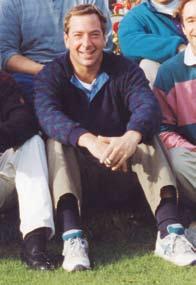
le F t : Randy Beard III, known as Randy Junior, joined Annin full-time in 1986.
belo W: Annin flags graced the U.S.S. Constitution on its 200th-anniversary re-launch.
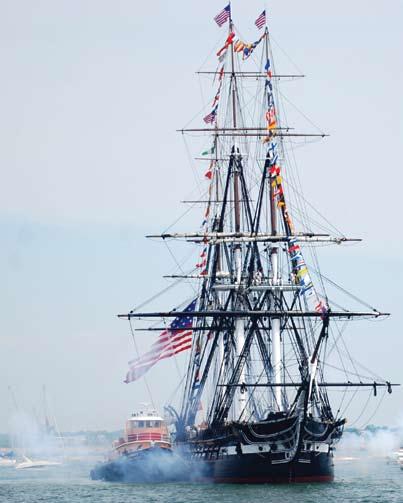
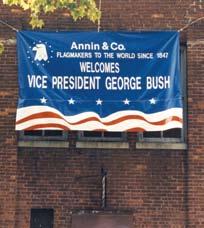
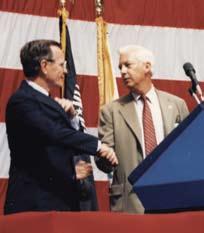
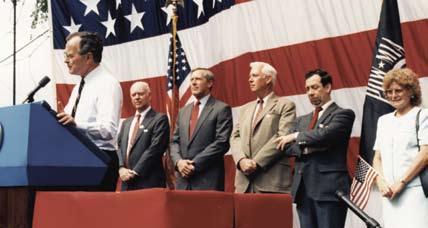
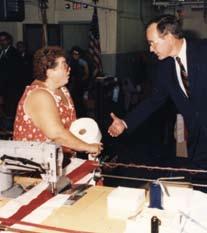
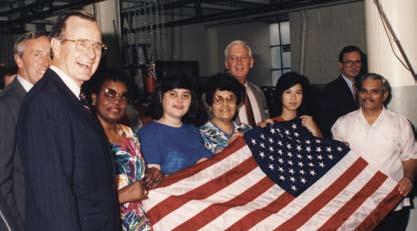
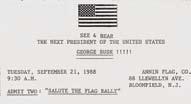
to P ro W: This banner welcomed candidate George H. W. Bush to Danco on September 21, 1988.
Bush at the podium. Back row, left to right: Lee Beard, New Jersey senatorial candidate Pete Dawkins, Randy Beard II, Gus Miranda, and Pat Lomanto, president of United Textile Workers Local 220 and an Annin employee.
M iddle ro W: Bush and Randy Beard. Bush extended a hand to Sue Preta, a Danco worker.
Invited guests received these tickets. botto M: Bush and employees, with Pete Dawkins (far left) and Randy Beard in back row.
When presidential candidate George H. W. bush made the danco plant a national campaign stop in September 1988, the company swung into a short but intense few weeks of preparation. Carter beard remembers the time well. He was headed to Washington, d.C., for a new job, having worked after college graduation at a boston dealer called The Flag Center and at Putnam Investments. “My dad said, ‘I know you’re going to Washington, but why don’t you just spend the weekend with the Secret Service while they prepare the plant for the visit?’ The thing that got me was they were looking for sniper locations. That was exciting. I spent a long weekend with them and our head of maintenance, just helping to clean things up and putting curtains over windows so no one could see the path of the tour.”
bush’s visit drew national coverage. The Chicago Tribune called it a “made-for-tV trip to a battleground state,” noting that the workforce was impressively multi-ethnic and that the audience included “a few dozen protesters.” (The visit also triggered a later article in The Washington Post about labor union wages at Annin that set off a lively exchange of letters between Randy and the newspaper’s publisher, ben bradlee; see sidebar on pages 56–57.) Randy’s short speech after the tour captured Annin’s attitude toward the event:
We have been making the same product for over 140 years— although then it had but 29 stars and has changed 15 times since. But we have always made it with care, with respect, and much pride. . . . In my mind, the most important flags we make are the ones displayed on the homes of American families across our nation. Since 1847 we have produced millions and millions of American flags but never, in my experience, has demand been as strong as it has these past six years. . . . Of course this has been good for business and we appreciate it, but more important, it has been good for America.
bush, then vice president, ended up spending another four years in Washington—but Carter never made it there. When Annin lost a mechanic at Verona that month, Lee said to Carter: “you like fixing machines. Why not train with Jim bryson, a top-notch sewing machine mechanic, before you go
off?” Carter worked at Verona for months as a mechanic and later as a supervisor of a sewing department for two years. Then he moved to the new corporate headquarters at Roseland to work as a manager of custom quotations.
Lee’s low-key invitations worked better than direct pressure would have. Like his father and uncles and cousin Randy, Carter was captivated by the business. His cousin Sandy would soon decide to make her career at Annin as well, after a post-college stint in human resources management at u.S. testing Corporation.
The final seven years of Randy’s presidency had their share of major moves, both physical and psychological. In some ways, they were like a dress rehearsal for the even more demanding events that would follow.
Annin is no stranger to doing business in wartime, but the first Gulf War caught America and the company somewhat by surprise. Although u.S. troops had been in Saudi Arabia for six months under operation desert Shield, flag demand didn’t accelerate until operation desert Storm was launched on January 17, 1991. “All of a sudden we started getting calls,” recalls bob Caggiano. “Customers would say, ‘Send me 48 three-by-five u.S. flags.’ twenty minutes later they’d call back and double the order.” because Annin’s inventory levels tend to be lowest in the winter, production quickly stepped up. The demand proved to be a spike. Almost as soon as America declared a cease-fire at the end of February, the phones stopped ringing.
demand rose for a happier reason that year: the end of the so-called Cold War between the u.S. and the Soviet union, which had simmered for almost 40 years. After the final dissolution of the Soviet union, Annin employees found themselves working overtime to make flags for belarus, Estonia, Latvia, and the other 12 newly independent post-Soviet republics.
After ten years in Harrison, Randy decided to close that operation in order to create Fabric Art Studio Limited, a silk-screening division, in Palm bay, Florida.
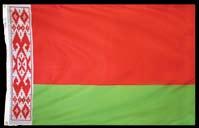
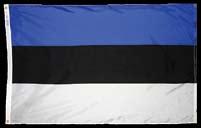
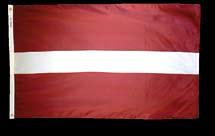
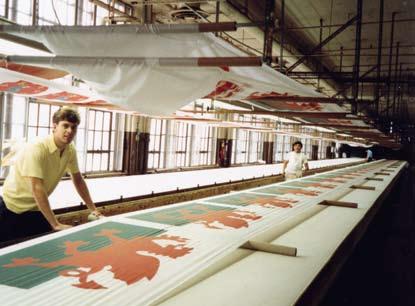
le F t : The flags of Belarus, Estonia, and Latvia, which became independent nations after the fall of the Soviet Union in 1991.
abo V e : Carter Beard doing summer work at Annin in 1987. He joined full-time in 1988.
belo W: Annin’s Fabric Art Studio building in Palm Bay, Florida.


a month after George H. W. Bush made a stop at Annin’s Danco plant during his 1988 presidential campaign, The Washington Post ran a piece on unionism and pay at Annin called “American Journal: Inside the Factory, Hopes of Prosperity Have Flagged.” The article’s inaccuracies led to a spirited exchange of correspondence between Annin president Randy Beard and Post managing editor Ben Bradlee.
Reporter Marianne Yen quoted some workers as being displeased with their compensation, especially in view of Randy’s statement that Annin had done well in the Reagan era. Yen used wage rates provided by a union representative of the United Textile Workers, which represented workers at Annin’s New Jersey plant. Pat Lomanto, president of UTW Local 220 and an Annin employee, had been on the podium during the Bush visit. The union representative quoted in the story did not work at Annin, however, and the figures he offered erred on the low side—one of several mistakes that went unchecked before publication. Randy quickly called Bradlee to task. Here are the highlights of their communication.
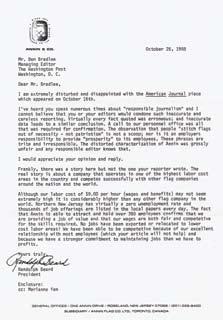
beard to bradlee, october 26, 1988
I am extremely disturbed and disappointed with the American Journal piece. . . . Virtually every fact quoted was erroneous; and inaccurate data leads to a similar conclusion.
[Randy included a list of the disputed facts with corrected data.] A call to our personnel office was all that was required for confirmation.
The observation that people ‘stitch flags out of necessity—not patriotism’ is not a scoop; nor is it an employer’s responsibility to provide ‘prosperity to

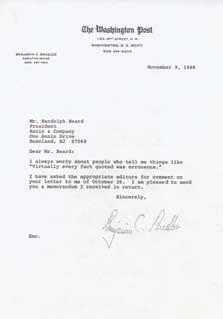
bradlee to beard, november 9, 1988
I always worry about people who tell me things like ‘virtually every fact quoted was erroneous.’ I have asked the appropriate editors for comment . . . I am pleased to send you a memorandum I received in return.


its employees’. . . . Frankly, there is a real story here, but not the one your reporter wrote. The real story is about a company that operates in one of the highest labor cost areas in the country and competes successfully with other flag companies around the nation and the world.
Although our labor cost of $9.00 an hour (wages and benefits) may not seem extremely high, it is considerably higher than any other flag company in the world . . . no jobs have been
exported or relocated to lower cost labor areas! [Minimum wage in 1988 was $3.35 per hour.] We have been able to be competitive because our of excellent relationship with most employees (which your article will not help) and because we have a stronger commitment to maintaining jobs than we have to provide.

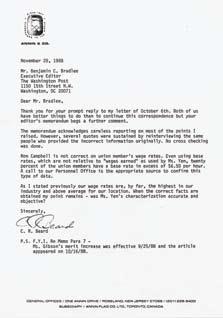


Looking back, Randy comments: “There were a couple of agitators around during Bush’s stop. Wherever Bush showed up, they showed up. They picked up their information in the parking lot. They would go around and interview employees and try to dig something up.” Curiously, the Post’s own coverage of the original event by David Hoffman had raised some red flags. “Craig Livingston, a lawyer for the union, distributed anti-Bush fliers purporting to be an ‘open letter’ from factory workers,” Hoffman reported.
“But the local union president, Pat Lomanto, escorted by Bush aides, told reporters that the letter did not represent workers’ views and said ‘we never heard of the union’s lawyer.‘” Despite being in the wrong, the newspaper never ran a clarification or retraction.
“I had to challenge The Post,” Randy says today. “Fortunately Annin had, and still has, nothing to hide.” H
beard to bradlee, november 28, 1988
Thank you for your prompt reply. . . . Both of us have better things to do. . . . but your editor’s memo begs a further comment. The memorandum acknowledges careless reporting on most of the points I raise. However, several quotes were sustained by reinterviewing the same people who provided the incorrect information originally. No crosschecking was done.
Ron Campbell is not correct on union members’ wage rates. Even using base rates, which are not relative to
‘wages earned’ as used by Ms. Yen, twenty percent of the union members have a base rate in excess of $6.50 per hour. A call to our personnel office is the appropriate source to confirm this type of data.
As I stated previously, our wage rates are, by far, the highest in our industry and above average for our location. When the correct facts are obtained my point remains—was Ms. Yen’s characterization accurate and objective?
“Screen printing was becoming ever more important to us,” Randy says. “We were storing 5,000 screens in Harrison, which took a lot of rented space. Also, we knew there had to be a newer technology than what we were using. We chose Florida because the labor was available and the price [of buying a building] was right. Fabric Art was our attempt to make it more of a studio operation where people were making an art product. We did it right. The artists didn’t feel they were working in a factory.”
Lee oversaw the set-up of Fabric Art and the implementation of the new technology, a color fixation machine called the Arioli. It supplemented the old “cottage steamers” that had dominated silk-screening for decades. “The Arioli is an open-air machine that steams the goods continually and works faster,” he explains. “We bought one, which was a first for a flag company.” Although digital printing would largely do away with silkscreening a dozen years later, the Arioli still serves Annin well. “It still is a time-saver, a very good machine,” Lee notes.
Another major move happened closer to home. Annin relocated its corporate offices and distribution center from Verona to 55 Locust Avenue in Roseland, New Jersey. Freeing up space in Verona allowed for more custom work, appliquéing, and mini-flag production there. “We had to expand,” Randy says. “our new headquarters was 80,000 square feet, a big move for us.”
Employees felt lost in the bigger space at first. “We went from very close quarters, where you could stick your head up over your section and talk to people in other departments, to this huge expanse,” Carolyn recalls. “That was a turning point. until then, everybody knew everybody’s else’s business. Not in a negative way, but the atmosphere had been more informal.”
“At first we said, ‘We can’t leave production behind. We have to run upstairs to the factory to see where this order is,’” adds bob. “Lo and behold, in a few months everything fell into place. No big deal. We just phoned over there.” In retrospect, the managers believe these transitions helped prepare the people at Annin for much bigger moves to come.
Amidst these changes, Lee managed the introduction of a specialized computer system called Qantel to replace the aging IbMs. “It was an MRP system, which stood for Manufacturing Resource Planning,” he explains.
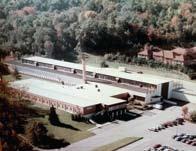
abo V e : The 1985 transfer of the corporate offices and distribution center to Locust Avenue in Roseland marked a turning point in Annin’s growth.
belo W: Annin replaced its aging IBM computers with the Qantel system, innovative for its time. Qantel was designed especially for the needs of manufacturers.
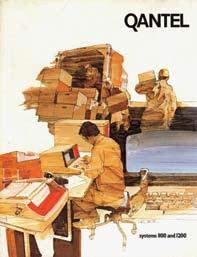
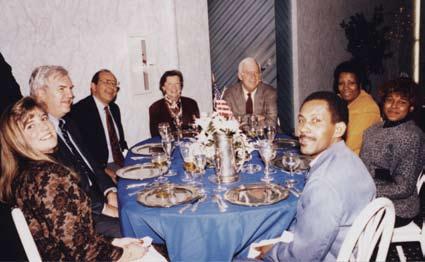
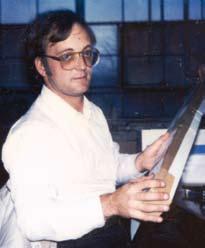
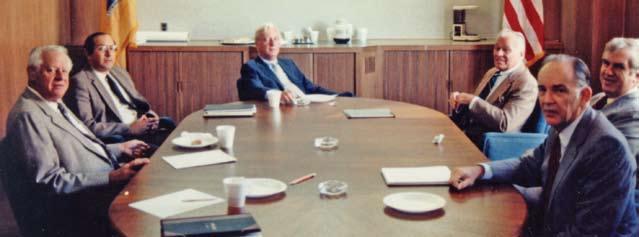
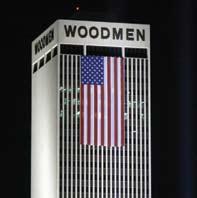
to P le F t : Enjoying the January 1992 retirement dinner for Ruth Brownlee and Ernie Scheffel were (around table from left): Sandy Dennis Van Lieu, Jack Dennis, Henry Hibo, Mary Beard, Randy Beard II, Evelyn Hargrove, Verona shop steward Hattie Blanton, and sewing supervisor Lennox Barkie.
to P right : The late Ed Gregory in 1986, packing for the move from Verona to Roseland. Ed became instrumental in forecasting and implementing the Qantel system.
abo V e : Around the boardroom table at the first Roseland office in 1986 were (from left): Tom Woods, Henry Hibo, Randy Beard, Wally Traendly, Jack Dennis, Dave Bate.
le F t : Headquarters of Annin client Woodmen of the World in Omaha, Nebraska.
“It called for the sales department to do some forecasting, and then it did all your planning, purchasing, and production.” Ed Gregory, then the danco plant manager, assisted Lee in putting the new technology into action. Ed also proved to have a knack for forecasting, so he took on that responsibility as well. “A real learning curve,” Lee says of Qantel. “For the first time, everyone had a desktop monitor. We had to train everybody on the different uses, and we had to learn how to make it work remotely for our other plants. At that point in the flag business, we had one of the best computer systems out there.”
Human resources efforts were modernizing as well. Henry and Sandy implemented Annin’s first formal safety program and an Employee Recognition Awards day at each plant, held every June 14 (see sidebar). “Annin was growing, and these were the right things to do,” Sandy says.
The expansions came in tandem with the growth of the marketplace. Although smaller flag dealers and civic organizations remained the backbone of the business, national accounts such as Kmart, Walmart, Woodmen of the World (a fraternal organization that gives flags to schools and nonprofit organizations), and Mcdonald’s played increasing roles. “The biggest corporate buyer of flags in the u.S. is Mcdonald’s,” noted the younger Randy. “It was company policy that each Mcdonald’s location had to fly a u.S. flag and a Mcdonald’s flag, and we make both for them.”
“a whole new light”
As they approached their mid-60s, Randy, Lee, and Jack looked toward retirement. They fully intended for their children to lead the company, but they knew the sixth generation wasn’t ready at that point. In addition, Carter had left when he decided to pursue an MbA at duke university full-time. Lee beard stated, “What Carter wanted to know about was business. . . . It has probably been the best thing both for the company and him that it happened. I think it has helped us realize that the flag business is not a unique business. We know about the way my generation did it, but that is probably not the way business should be done nor can be done today.”
Against this backdrop, Randy and Lee recruited terry Schmoyer in 1996. terry had solid credentials; he had been an operations manager at General Electric and the vice president of operations at crayon and
employee recognition day
June 14 is special at Annin for two reasons. Not only is it Flag Day, but it’s also Employee Recognition Day at the Roseland home office and the plants in Verona, Coshocton, and South Boston. Workers gather for a luncheon and an informal visit by a senior executive of Annin Flagmakers. Those who have worked five years or longer enjoy service awards and rounds of applause from their colleagues. The Verona plant, home to workers of more than two dozen nationalities, also honors those who have recently attained U.S. citizenship.
The event was the brainchild of Henry Hibo, retired vice president of finance. “It’s been running annually since the mid-1990s,” he says proudly. Workers get into the spirit of the day, decorating the facility and often dressing in red, white, and blue. H

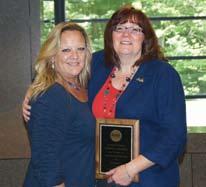
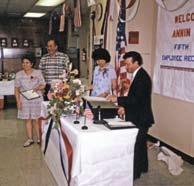
abo V e : Fifth Verona Employee Recognition Day, 2001 (left to right):
Antonietta Minichiello, Henry Hibo, Rimond Boutros, and Joe Vallone.
M iddle ro W: Team members in Coshocton, 2013.
Data management coordinator Georgette Silva (left) and Carolyn Albanese, who received her 35-year service award at Roseland in 2012.
botto M: Bob Caggiano (back row, far left) traveled to South Boston in 2013 to present awards to recipients including (back row, from left)
Vanessa Faulkner, Felicia Womack, Latashia Brooks, Ronald Johnson, Sean Stoner, Gary Gibson, and (front row, left to right) Jenna Austin, Karon Womack, Janetta Sydnor, Kathy Meadows, Talika Chappell, Eleanor Thaxton, and Sandra Whitlock.
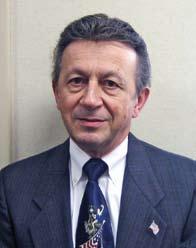
le F t : Joe Vallone, retired Verona plant manager. Often interviewed by the media on flag-related occasions, he spoke eloquently about the importance of flags and about Annin’s commitment to “made in the USA” manufacturing and the multiethnicity of its workforce.
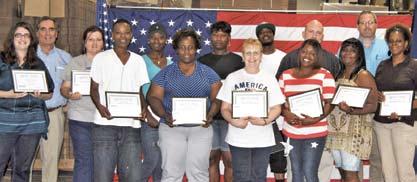

toy manufacturer binney & Smith (now Crayola LLC), a subsidiary of Hallmark Cards. He joined Annin both as a potential president and a mentor to the sixth generation. Although absent, Carter figured in the bigger picture. “ terry communicated with me regularly during my second year at duke,” he recalls.
terry’s mandate was to speed up operations. “I liked terry,” Lee says. “He brought a whole new light, a new way of seeing the business.” Joe Vallone affirms: “Annin grew under Randy’s leadership as far as his reach could grab. When the fifth generation sensed that the grasp could only go so far, they went outside and brought in new strength. I compliment them for that.”
Away in North Carolina, Carter felt the pull. The realization that his MbA classes would have real-world applications at Annin also excited him.
“In my second year, as part of our communications, terry and I started to discuss my return,” he says. “I was excited to come back to Annin in 1996 and work with him on operations projects.” Carter’s official title was manager of process engineering.
Sandy also decided to pursue her MbA. She opted for a one-year executive program at the university of tennessee and kept working at the same time. “I had to fly back and forth for 11 days every six weeks,” she notes. In the process, she willed herself to overcome airsickness. “ terry would say, ‘I don’t care if you get sick every time you get on a plane. business people travel. That is what they do. Just do it.’ I did it.”
beyond the comfort zone
terry’s “just do it” philosophy permeated every area of Annin. The result was more delegation of responsibility and, eventually, a shift in the company’s culture. “terry didn’t tell you how to do it; he just said do it,” bob emphasizes. “He challenged us outside of our comfort zones,” Carolyn adds.
Carter’s major assignment was to achieve same-day shipping of stock items such as u.S. and state flags, which was unheard of in the industry. “our competitors weren’t shipping that fast; it was to get ahead of them,” he notes. Sandy managed the revamping of the custom business for turnarounds of two weeks or less.
The new energy was contagious. Employees in the sales, production, purchasing, and distribution departments rose to the challenges faster than anyone expected. “All of a sudden we got a lot quicker-paced,” bob says.
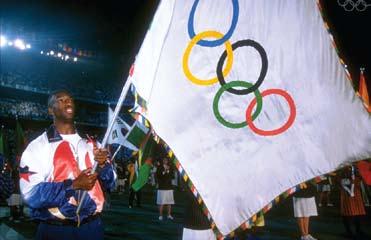
V e : Record-breaking
dave Gregory recalls the push involving the 1996 Summer olympics in Atlanta. “Making those flags was very stressful,” he says. “The olympic Committee insisted that one country’s flag couldn’t be bigger than another’s. Everything had to be proportional.” While this requirement may seem easy, different nations have different height-to-width ratios for their flags. designs had to be adjusted, reviewed, and approved. Sandy Van Lieu, then production scheduler, was the Annin project leader, working directly with the customer and the olympic Committee. Sandy coordinated the delivery of the flags to every venue, insuring that each flag was properly labeled, approved by each embassy, and precisely in line with each country’s specifications based on how the flag would be hung. “They almost didn’t have flags at the opening ceremonies,” dave adds. “We worked through it, but it was a very hectic time.”
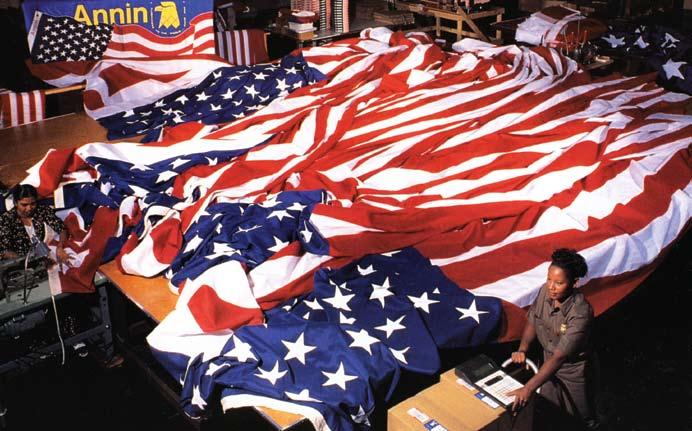
A key factor in the general acceleration was the creation of selfdirected work teams at the plants. “For decades we had used the bundle system, creating custom flags from stacks of material,” Sandy notes. “We got rid of that. We cross-trained the operators so everyone could do sewing and cutting and stamping. That keeps production moving. If one person is out, the others can pick it up.” Although it took time to come up to speed, the approach worked and the team concept is still in use.
on the human resources side, terry prodded Annin to do even more. The company’s major benefits had traditionally been “soft” ones—unspoken job security and a collegial environment. “We were a family business, and the people who liked that stayed here,” Carter says. to become more competitive, Annin introduced a 401(k) plan and better health insurance options.
dettra seeks a buyer
Late in 1996, Carter made a provocative proposal to company leaders. “I told them we should buy dettra,” he recalls. dettra Flag Company, founded in 1920, had long been one of Annin’s major competitors; the other was Valley Forge Flag Company, Inc., an industry presence since 1929. The gist of Carter’s argument: “dettra doesn’t have family members working at the company. They have 15 shareholders. If they are anything like our company, they probably don’t make as much money as they think they should. Since the owners don’t work there, they don’t have as much of an emotional attachment, and it will be easier to buy the company.”
The suggestion sank like a stone through water. “‘Carter, you have a lot of ideas,’ is what I was told,” Carter says. “The message was: Just work on your projects. you have enough going on.”
Carter’s intuition turned out to be on-target. on december 2, 1997, the Philadelphia Investment banking Company sent a confidential letter to Randy, announcing that the owners of dettra were seeking a buyer. It further revealed that Valley Forge had made an offer that summer. Was Annin interested in bidding?
The inquiry arrived just as Randy was about to retire from day-today operations, a long-planned move. (He would stay on as chairman of the board.) Lee and Jack were taking over as co-presidents. The change in leadership came as Annin faced perhaps the most momentous decision in its 150-year history: whether to acquire dettra. H
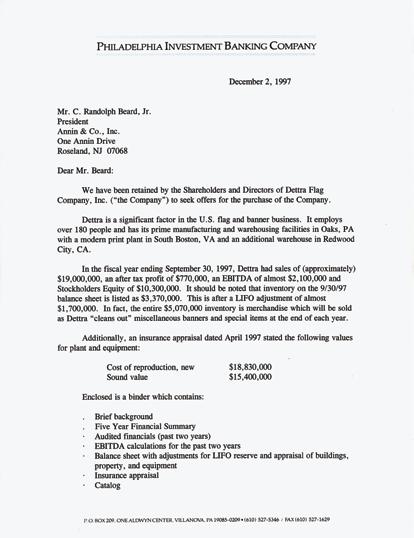
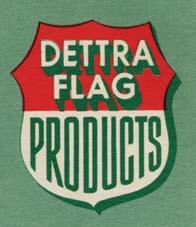
abo V e : The original Dettra logo. le F t : Annin leaders had already had some discussion about acquiring competitor Dettra when this letter arrived, seeking offers for the purchase of the flagmaker.
belo W: Stick flag celebrating Annin’s 150th anniversary.
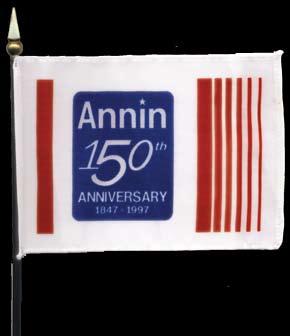

the dettra acquisition was a watershed event in the history of the company. lindley scarlett and i came in after it with the goal of positioning annin to continue as the leading u.s. flag manufacturer. then came the tragedies of 9/11, another watershed event. today, annin has put in place the infrastructure and the technologies that will enable it to maintain that leadership position and remain a family-run company.
—Joseph LaPaglia, CEO, 2007

c

As 1998 approached, Annin found itself in a bidding battle for dettra. The other bidders were Valley Forge, whose earlier offer had been rebuffed, and a management committee of dettra.
The group concurred that Annin had to make an offer, if only as a defensive measure. Annin had 500 employees, Valley Forge 365, and dettra 230. Since all three companies were closely held, their sales figures were not made public, but Annin knew it would lose its long status as the country’s biggest flag company if Valley Forge bought dettra. “Everyone agreed that scenario would have been bad news for us,” Carter b eard says.
Pro-acquisition feelings solidified at Annin during the three rounds of bidding. The company was “in it” for real—and in it to win. Some industry observers speculate anecdotally that Valley Forge never had a chance, because of a lingering grudge towards them held by some of the family owners of dettra. Whether or not that’s true, Annin won the bid by a small margin. Effective June 10, 1998, two of the three largest flag manufacturers in the retail industry would become one.
Few events in a company’s existence are more disruptive than mergers and acquisitions. Even the relatively smooth ones temporarily throw employees and systems into upheaval. They can be compared to moving to a new home or having a baby: initially exhausting, and almost always more costly than expected, but rewarding over the long term.
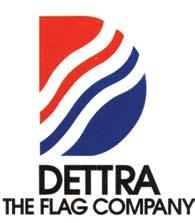
abo V e : Dettra’s logo in 1997. o PP osite : Ground Zero under construction, five years after the devastating attacks of September 11, 2001. As demand for U.S. flags reached an all-time high in the months that followed, Annin employees were proud to do their part.
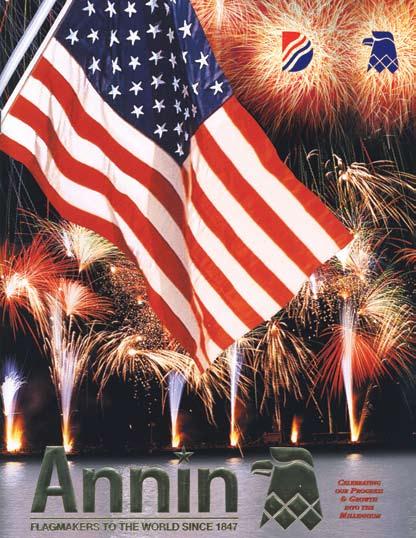
Like other acquiring companies, Annin had to work through issues on all fronts. The management committee faced hard decisions about consolidations and closures. Annin had its headquarters and distribution center in Roseland; plants in Verona, bloomfield, Coshocton, and Palm bay; and New Constellation in orange. dettra had its headquarters and plant in oaks, Pennsylvania, a two-year-old plant in South boston, Virginia, and shipping facilities in ohio and California.
Even before bidding on dettra, Annin had seriously considered consolidating its operations to one location in New Jersey and a second in ohio. “My uncles knew we had to do it, and my father knew we had to do it,” Carter says. He and terry had planned to spearhead the consolidation in pursuit of a stronger, more profitable company. Then, with a myriad of post-dettra locations, those roles were thrust onto everyone—especially Lee and Jack as co-presidents.
Some decisions were easier than others. Palm bay had been a mixed success, because of high employee turnover in an area more attuned to aerospace jobs than manufacturing. The obvious choice was to consolidate the silk-screening at the large new plant in South boston, Virginia, which was already set up for it. That plant took on some sewing as well. The Schiffli work would remain for the time being in orange, a very small facility.
Closing danco in bloomfield was probably the most painful move. but the facility was showing its age. The logical solution there was to consolidate the making of u.S. flags in oaks, which already had a thriving operation. As for distribution, Annin eventually closed the California warehouse and moved dettra’s Pennsylvania inventory to Roseland.
These moves—which represented just the initial round—took time and, more crucially, money. “There was a lot of severance pay,” Lee says. “We tried to take care of the workers.” Since few employees wanted to relocate, recruitment and training costs figured in. “For example, Florida had 70 workers, whom we had to lay off,” he notes. “Then we had to hire 70 workers in Virginia and train them.”
“you have two profitable companies and you put them together and you think things are going to work out,” Jack adds. “Well, they did, but not at first.”
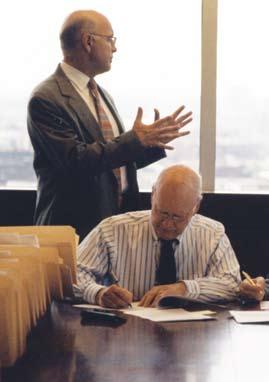
le F t : This catalog announced the Dettra acquisition. While the merger was a cause for celebration, the actual implementation took time and patience.
abo V e : Lee Beard (seated left) and Jack Dennis signing legal documents at the Dettra acquisition in 1998, with Jerome St. John and Henry Hibo behind them.
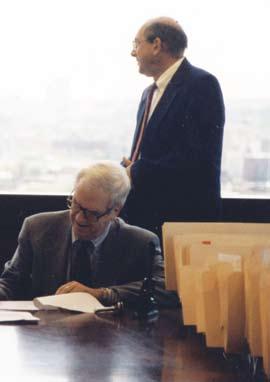
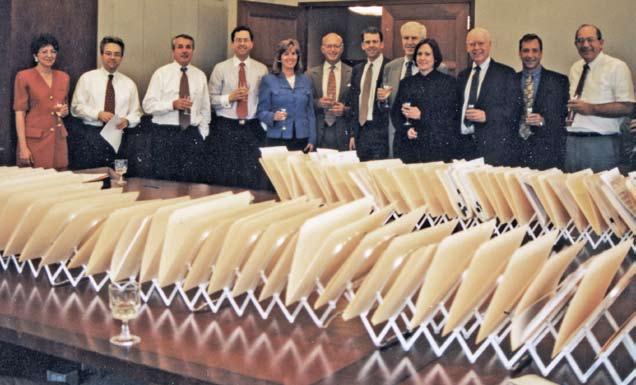
Everyone at Annin rose to the pressures, from the management team to new plant workers. Sandy Van Lieu recalls that “because we didn’t have real-time information, our inventory ended up being at odds with what we thought we had.” Front-line managers took heat from customers. For a year, says Carolyn Albanese, “the dettra customers didn’t like us and the Annin customers were upset with us.” dale Coots, who became marketing manager that year, was also in the thick of the transition. She remembers it as one of the busiest times in her long career at Annin.
“When things got tight during 1998, a lot of people said we shouldn’t have done the acquisition. but if we hadn’t, it would have been far worse for the company,” Carter declares.
Jack recalls his first NIFdA conference after the acquisition. (NIFdA is the National Independent Flag dealers Association, an organization of flag and banner retailers and manufacturers located throughout the u.S.)
“I told the dealers, ‘I know the problems you’ve had, but I guarantee you will not have those problems in a year,’ and they didn’t.”
Some former dettra executives left after a short time to start a new company, the Pennsylvania-based FlagZone. As always, Annin accepted the new competition in stride. “understandable. That is what entrepreneurship is about,” Randy says. “Some say they were not loyal, but I say good for them,” Carter adds. “In their shoes I would have done the same. If our sales had gone down when they left, I would have been a little more upset, but they didn’t.”
bill Kelehar, former director of operations at South boston, had joined dettra in 1994 and thus lived through the transition. “I truly believe we, the dettra employees, were much luckier that Annin bought us,” bill says. “Annin did not come in with that ‘fire everybody’ attitude at all. They looked to invest in the future. We would never have had the opportunities with dettra that we have had with Annin.”
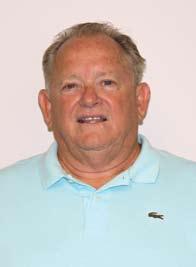
le F t : Attendees at the Annin-Dettra merger transaction included (starting fourth from left): Doug Hendrickson, Sandy Van Lieu, Jerome St. John, Carter Beard, Jack Dennis, Sandra Braun, Lee Beard, Randy Beard III, and Henry Hibo.
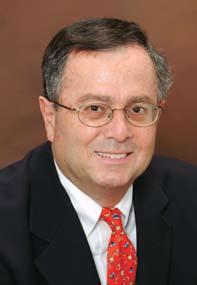
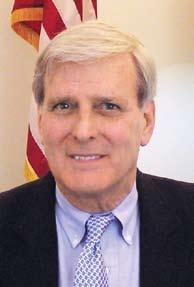
Joe LaPaglia (left) and Lindley Scarlett joined Annin in 2000 as interim leaders. They brought solid experience, complementary talents, and a willingness to mentor the sixth generation.
leadership transition
ultimately the dettra acquisition would provide Annin many new opportunities to grow. but first the company had to work through some succession issues.
As planned, Lee and Jack retired in 2000. but terry Schmoyer did not become president. His goal had been to accelerate Annin, and in that he succeeded. He was a somewhat polarizing figure. According to Carter, who worked for terry for three years and knew him well: “ terry wanted the responsibility to make the final decisions, and they weren’t ready to give him that.”
terry chose to leave. About the same time, Annin had an inquiry from a management team about investing in and perhaps purchasing the company. They were Joseph “Joe” LaPaglia and Lindley Scarlett, who had worked together at Faber-Castell, the writing instruments company. Lindley had also been an executive at binney & Smith/Crayola, where he had known terry.
Although Annin shareholders certainly didn’t want to sell the business, they saw an interim succession opportunity. “I think Lee and
Jack liked our complementary strengths,” Joe says. “Lindley had the sales and marketing background, and I had the finance, administration, and operations experience.” both were simpatico with iconic consumer products made by long-established companies. (binney & Smith is synonymous with crayons, and the ancestral founder of Faber-Castell actually invented the pencil.) “one of the things that attracted us was Annin’s long history,” Lindley says, “and the fact that the flag is not a product that will be superseded by some technological change or somehow go out of style.”
Ironically, this changeover came at the height of the first dot-com era, when many companies had little use for executives in their 50s and certainly didn’t recruit them. but a few gray hairs would serve Joe and Lindley very well at Annin. They were willing and able to guide the sixth generation into top leadership positions.
Coming aboard in mid-2000 as president/CEo and executive vice president, respectively, Joe and Lindley hit the ground running. “There was a greater urgency to implement change than perhaps existed prior to the merger,” Joe says. As part of the post-dettra financial retrenchment, Annin changed its banking relationship from Chase to Mellon bank. In addition, it purchased a new facility in Coshocton to replace the Civil War-era factory it had inherited from the Colonial acquisition. Around this time Joe brennan, director of mass market sales, joined Annin and created an independent sales rep network to help penetrate the mass market channel. The growth into mass market gave Annin economies of scale in purchasing and name recognition that benefits the dealer channel.
From the start, Joe and Lindley brought new and solid strengths to Annin. Annin also taught them some valuable lessons—especially those that began on the morning of September 11, 2001.
In an ideal world, flag sales would be equally strong in every season, year in and year out. In reality, tragic events often create unprecedented demands. The flag industry’s role is then to maximize production and distribute products fairly, all without becoming profiteers.
Even in its long history, Annin had rarely witnessed anything like the patriotic zeal that gripped Americans after the tragic events of September 11. The frenzy began a few minutes after the first reports of the planes flying into the World trade Center. Carolyn Albanese’s first call that
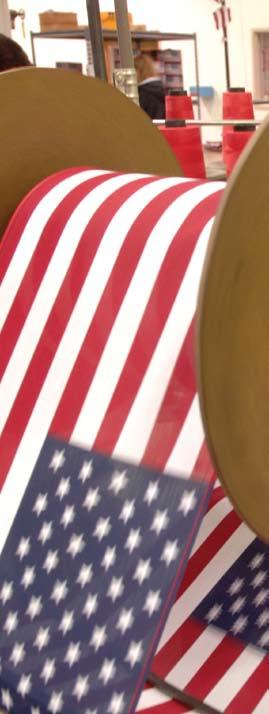
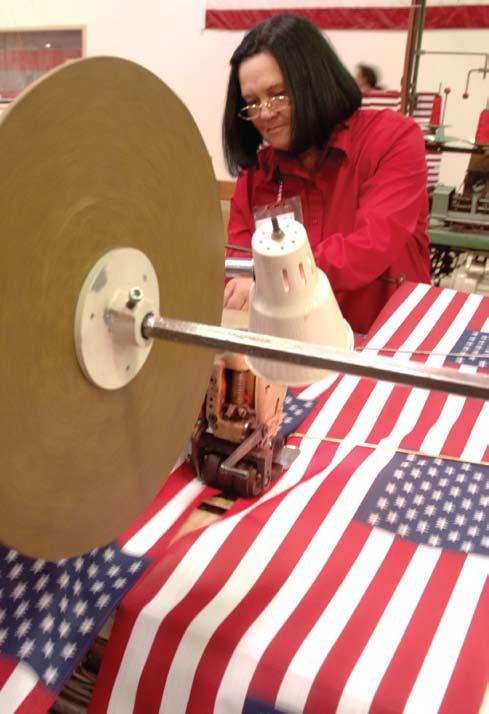
morning was from her sister, who was frantic to trace the whereabouts of their brother. Fortunately he was not at his desk in the twin towers that day. The next phone calls came from the field, setting off a fervor that lasted for months.
“one of the things I am always asked, and I will live and die by this one, is how many flags did Annin sell?” says bob Caggiano, vice president of commercial sales. “I always say: No, that is not the question. The question is how many could we have sold. If we had run three shifts seven days a week, we still wouldn’t have had enough flags.”
Annin swung into crisis management mode. Key managers gathered the very first day to take decisive action. The natural leader was Ed Gregory, director of production planning. Ed’s aptitude for forecasting proved sharper than ever. “At our first meeting, Ed predicted we would be out of inventory of finished flags by Thursday—only two days away. He was right,” Joe recalls. Ed and Jill Gifford, corporate forecasting manager, worked with the plants daily to balance the allocation across the entire customer base. Although Annin doesn’t sell directly to the public, people literally came pounding on the doors of the plants. They were directed to the nearest dealers—but often those dealers already had bare shelves.
Working into the night on 9/11, the group sought to buy as much polyester/cotton and nylon as possible. Lindley recalls: “We locked up an awful lot [of raw materials]. It was a financial risk at that point, but a risk we had to take. The fabric suppliers went with us because we had a history of paying them right and always treating them right.” Annin’s leaders didn’t even consider raising prices during what would prove to be a nine-month shortage in which demand was ten times higher than normal.
Annin kept on top of the situation by starting each day with a 7:00 A M meeting attended by the full management team. After procuring fabric, their next step was to ramp up operations and add second shifts. Workers were eager to help; some brought in relatives who worked with them side by side. Within days, half the basement of the Verona plant went from storage to a sewing facility.
Joe Vallone, interviewed in his few spare moments by reporters as far away as London, pointed out that employees from every nationality were distraught over the event. “People who were scheduled to take personal
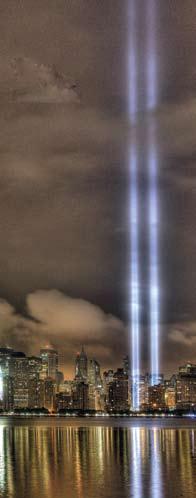
abo V e : The destruction of the twin towers of the World Trade Center, later memorialized by columns of light, triggered an outpouring of patriotism. le F t : Employees felt a new sense of purpose as flag production stepped up to unprecedented capacity.
days before the incident suddenly didn’t want to,” he noted. “They know what’s at stake.” Virtually everyone interviewed for this book agrees that they felt a new sense of purpose throughout the crisis.
Ed Gregory forced the crisis management team to make numerous tough decisions. “We couldn’t supply our whole line,” Lindley recalls. “We said: Let’s identify what the consumer and the united States need, and let’s make only those products.” For the foreseeable future, every plant would focus solely on 3-by-5-foot to 5-by-8-foot nylon u.S. flags. Sandy Van Lieu remembers that Annin’s component vendors “contacted us, because we had long-standing relationships with each of them, to confirm material needs to meet Annin’s demand through this crisis.” Sandy and dave Gregory, then the company’s purchasing manager, worked with the suppliers daily as the needs continually changed.
The situation also called, in effect, for a rationing of output. As it had done during the first Gulf War, Annin analyzed the percentage of its total business represented by each customer and sold to them accordingly. “We wanted to allocate in the fairest way. We all felt that was key to treating our customers right,” Lindley says. Loyal customers appreciated the system, but naturally some would-be buyers came away angry. Along with a few existing customers, they demanded to know why Annin couldn’t produce flags around the clock.
The answer is that flagmaking is a skilled and highly specialized craft, not a matter of pushing a button on an extrusion machine and having more flags instantly appear. “Lots of labor goes into flagmaking, and you can’t find an experienced sewing machine operator a phone call away,” Rich Caramagna, vice president of operations, points out. Joe has never forgotten a phone call from a mass-market buyer who hectored him to force Annin’s employees to work 24/7. He patiently explained that Annin’s workforce was already expanding to two 10-hour shifts and weekends. The buyer huffily announced she would find another supplier. She quickly discovered how small the flag industry is, and how real the shortage was. Her next call to Annin was much more humble.
one solution was obvious but generally unacceptable. dealers could try to procure American flags made outside the united States. Annin itself was approached by an opportunist hawking Chinese-made goods he had
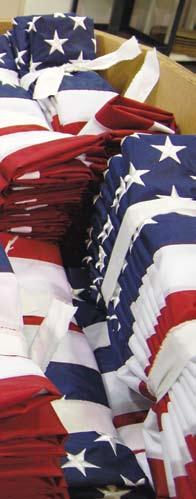
quickly imported, hoping Annin would distribute them. The crisis management committee didn’t even entertain the notion. Many buyers agreed. The ruling sentiment became: “We may not have enough flags, but we believe the American flag should be made by u.S. manufacturers.”
The flag shortage flushed out a few other types of opportunists as well. “Individuals would call up and want to know how they could invest in our company,” Carolyn Albanese recalls. “They were very matter-of-fact about it. I found it disappointing that some would try to benefit from a national tragedy.” on the whole, however, the aftermath of 9/11 brought out the best in everyone, as illustrated in another call Carolyn fielded. “A civil servant in New york City sounded so sad. She said to me, ‘I have two jobs today. one is to buy as many plastic buckets as I can. [These were used in the removal of remains from Ground Zero.] The other is to buy as many 5-by-9-and-a-half-foot u.S. flags as I can, to drape the bodies with.’ by then we didn’t have any left, but we got on the phone with other manufacturers and helped her find what she needed.”
“That is what was great about that time, for all of us here,” Carolyn continues. “It wasn’t about making money or any of that. It was about helping people like that woman. We felt that providing as many u.S. flags as possible was how we could help our country deal with the magnitude of this tragedy.”
Annin dealt with another issue in 2001, a lawsuit brought the previous year by a competitor involving the proper labeling of flags made in the u.S. Settled out of court, the suit (along with post-9/11 shortages) led to the creation of the Flag Manufacturers Association of America, or FMAA.
Co-founded by Annin, the FMAA promotes the manufacture of u.S. flags in America by Americans with domestically made fabric. The group’s efforts have helped stem the tide of imported flags that threatened to flood the market after 9/11. Sandy, who has appeared as an industry spokesperson on CNN’s Market Watch, served as FMAA’s president for 10 years. “How would you feel if the American flag you so proudly display was made in another country?” she asks audiences. Existing u.S. law requires every flag to be marked with its country of origin. Flags made by FMAA members and all flags that meet FMAA standards carry a “Certified Made in the u.S.A.” label. The group also educates users on the proper use of flags.
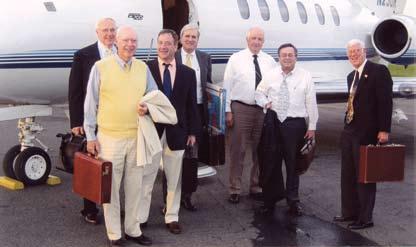
Some states have introduced laws making it a misdemeanor to sell a foreign-made American flag within their borders. These efforts meet with opposition from some free-market advocates. A Wall Street Journal editorial opposing such a law in Minnesota in 2007, for example, claimed that “old Glory stands for freedom, including the right to trade with people of other nationalities. We suspect that when most Americans wave the flag, they care more about the ideas it represents than where it was made.” The editorial pointed out that other iconic American items such as baseballs are typically made abroad. However, the FMAA, through a broad survey it completed, found that the majority of respondents expect their American flag to be made in America.
expansions after 9/11
during the summer of 2002 business began to return to normal levels. It surged again at the outbreak of the Iraq war in April 2003, with Verona once again pitching in to produce u.S. flags and yellow ribbons. An Associated Press article on the effort made special note of the plant’s multiethnic workforce, citing the contributions of Norma Ratel from Lebanon and Ahillia Harnandan from Guyana.
to realize the benefits of 21st-century technology, Annin replaced its aging Qantel system with SAP, the world-renowned enterprise software. Though SAP is notoriously difficult to implement, the rollout went fairly smoothly and provided, for the first time, a real-time “snapshot” of each


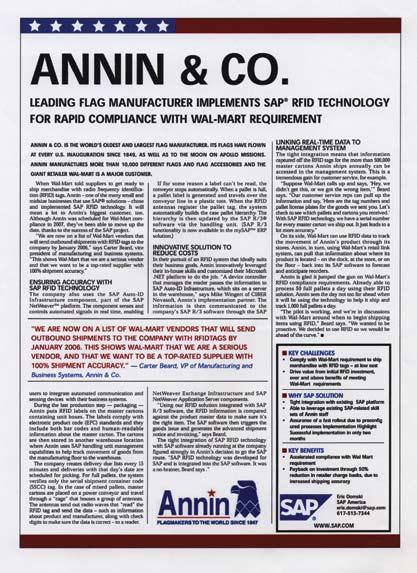
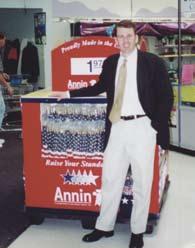
F ar le F t : En route to a board meeting in 2003 were (left to right): Moore Craig, Lee Beard, Randy Beard III, Lindley Scarlett, Ed Batta, Joe LaPaglia, and Richard Jeffrey.
abo V e le F t : The FMAA logo. Annin’s Sandy Van Lieu served as the trade group’s president for a decade.
le F t : Annin was the subject of a case study by enterprise software maker SAP.
abo V e : Carter Beard in 2000 at a Walmart in Alliance, Ohio.

facet of operations. “SAP gives us such good tracking, a better picture of what is going on across the company,” bill Kelehar notes. Customers appreciate the real-time inventory knowledge. “our customers expect a lot of us—for a lot of them now, we are their warehouse,” Sandy Van Lieu points out. “our strategy for technology advancement put us steps ahead of our competition, which continues to be a goal,” Lindley summarizes.
In 2001 the company stopped leasing its Civil War-vintage plant in Coshocton and purchased a modern facility on nine acres. The move occurred over the hectic Thanksgiving weekend in 2001 after the outbreak of 9/11. Then, in 2003, Annin shuttered the California warehouse acquired from dettra. Next came a physical expansion of the Coshocton plant by a third, to 152,000 square feet, in 2004.
The South boston plant doubled in size. In 1999 Annin had roughed out a 100,000-square-foot expansion adjacent to the operating plant, but the shell lay dormant for a few years. Annin completed it in 2004. Half of the new space went to distribution, which moved from Roseland that year. The other half eventually absorbed the oaks plant, which closed in december 2005.
These moves allowed Annin to consolidate its plants by channels of distribution. Coshocton is the mass-merchant producer, serving customers such as Walmart and target. South boston supports the dealer channel, serving the approximately 1,000 independent flag retailers nationwide. Verona, which has been updated numerous times since its opening in 1919,
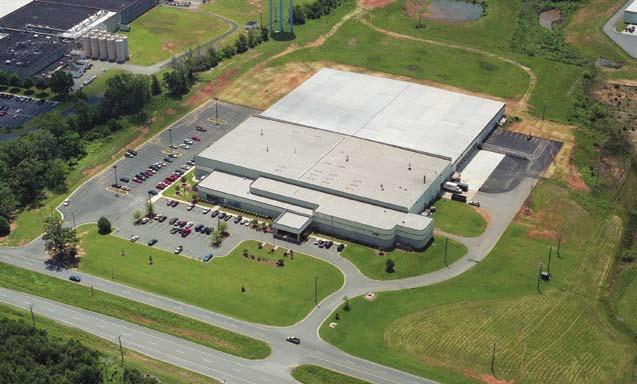
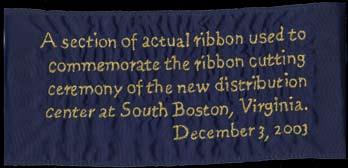
abo V e le F t : The Coshocton, Ohio, plant after its expansion in 2004.
abo V e : The South Boston, Virginia, plant after its completion in 2004. Workers embroidered special ribbon for the opening ceremony.
right : Leased space at 105 Eisenhower Parkway in Roseland, New Jersey, has been Annin’s corporate headquarters since 2004.
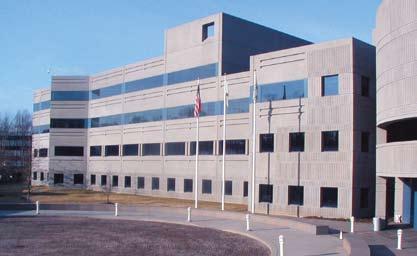
continued to be the custom flag plant into 2013; it also handled overflow from the other plants. The corporate headquarters remained in Roseland but moved to newer, leased offices at 105 Eisenhower Parkway in 2004. Psychologically as well as physically, these were a lot of changes for a traditional, family-owned company to absorb. but Annin is resilient. “When we moved the distribution center to Virginia, we gave a nice severance package,” Sandy notes. “My belief is, if you have to do something like that, you treat your people well. you hope they shake your hand at the end of the day and say, ‘It was a tough situation but you handled it well.’ I had to lay off people I’ve known since I was a kid, and that was very difficult.” by concentrating 80 percent of its flagmaking in two modern, single-story facilities, Annin has been able to introduce new efficiencies in machinery and in the way people work.
Since 2004, teams of employees at Coshocton and South boston have produced flags in a new way. The generic name for the process is cellular manufacturing; it’s also known as the toyota Sewing System (tSS), because toyota pioneered it for the production of automobile seat covers. “ terry Schmoyer and I saw it demonstrated at a sewing trade show in 1996 and said ‘Hey, that would work for flags.’ It took a few years to actually put it in place, but it’s been worth it,” Carter says.
basically, tSS is an alternative to the traditional “bundle system,” in which one sewing machine operator is given bundle after bundle of flag components to sew together. Material handlers then fold and move the flags. In tSS, by contrast, four or five employees work together in a little horseshoe—that’s the cell. They stand up, move around, and operate as a team as each one completes a step in the process. The cell contains three or more raised machines and open work surfaces.
Here’s how tSS works for u.S. flags. As with the bundle system, workers have the main components preconstructed and already at hand: the star field, the stripes to the right of the field, and the stripes below. (The sets of stripes have been produced by machines designed just for that purpose; each plant has this equipment. The fields have been embroidered at Star Fields LLC, Annin’s wholly owned subsidiary in Cobbs Creek, Virginia.) one worker sews the pieces together in a “short join” and then hands off to a worker who performs the “long join.” That worker then
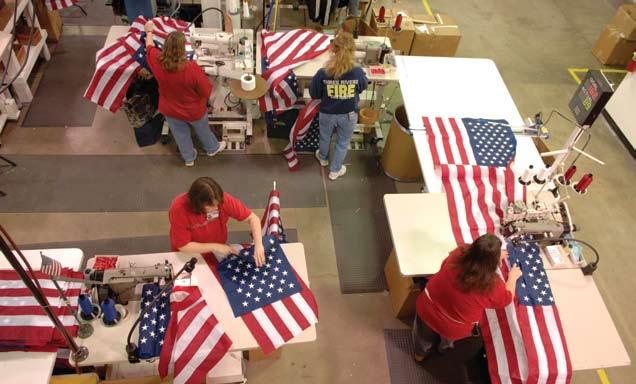
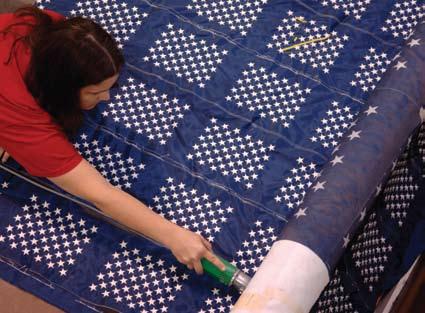
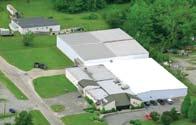
to P: Workers doing cellular sewing at the South Boston plant.
abo V e : The Star Fields plant in Cobbs Creek, Virginia.
le F t : Star fields for U.S. flags are embroidered in sheets at the Cobbs Creek facility, then cut apart and delivered to Annin’s various flagmaking plants.
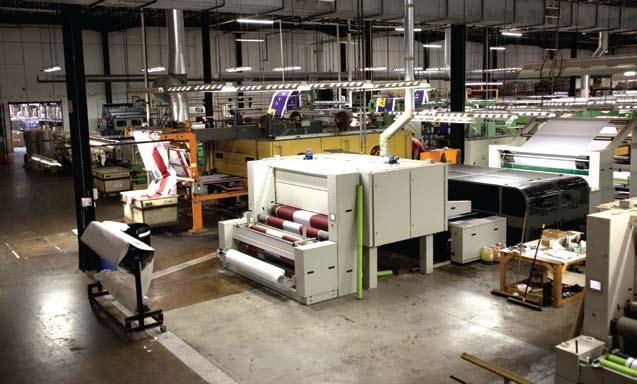
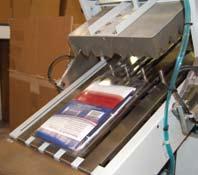
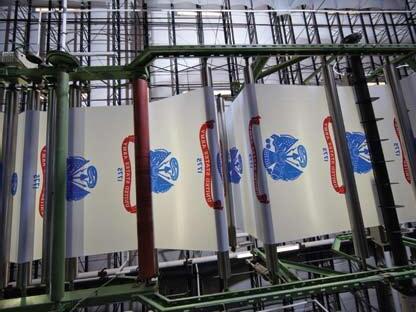
hands the joined flag to a colleague who sews on the “fly hem” (the fly is the edge of the flag farthest from the flagpole or staff). That worker, in turn, hands off the flag to another colleague who attaches the heading (the heavy reinforcement along the edge of the flag nearest the flagpole), adds grommets, affixes the Annin Flagmakers label, folds the flag, and places it in a box. This neatly orchestrated sequence results in a finished product in as fast as three minutes.
Cellular sewing has many benefits. It’s healthy for workers to be on their feet and moving. The process is also collegial. Workers learn all the steps, so they can help each other and fill in for each other as needed. Flag production can be 10 to 30 percent faster with tSS than with the bundle system.
“We have about 15 cells now in ohio and Virginia,” Carter notes. “It’s an innovation we’re proud of. It lets us measure throughput more easily and reward the most productive cells accordingly. tSS may just be a step in the road, but it is working very well for a lot of our areas. Five years from now we may find a method that works a little better. If so, we’ll move to that.”
digital technology has become the norm in many areas, especially in photography and other forms of image transfer. Annin lost no time in taking advantage of this trend. In 2005 it became the first company to produce flags using the dream Machine, a massive inkjet printer that has rendered silk-screening almost obsolete. The equipment was developed by the Italian manufacturer Reggiani, the ink maker Ciba Specialty Chemicals, and Aprion digital Ltd., which makes the digital heads for the printers. (The name is short for “digital Reggiani with Aprion Magic Heads.”)
Annin was an early adapter to digital printing, having started with smaller industrial inkjet machines made by Mimaki Engineering. The Mimakis were adequate but slow for the company’s purposes, turning out only six flags an hour. The dream Machine can produce up to 100 flags an hour of the same design, and up to 80 flags an hour when programmed to run several different designs in sequence, as is more typical.
until Annin, however, dream Machines had been used to print designs on household goods and clothing. only one company, based in Germany, had actually tried them for flags—and those flags were polyester. Annin wanted its custom flags printed on nylon. Reggiani and Ciba adjusted the technology to Annin’s specifications.
The arrival of the first dream Machine at the South boston plant marked a great leap forward. “Silk-screening is the production version of making t-shirts in a garage,” Carter explains. “you have to make screens for every color in a design, mix the dyes, then hand-print the flags at large tables.” Employees have dismantled most of those tables. The large projection camera that helped in the making of screens—which had been state-of-the-art only a few years ago—is rarely used. For the time being, Annin stores many of the screens just in case repeat customers specifically request silk-screened products. but fewer and fewer do.
Now the work flow is almost entirely computerized. Annin’s art department, managed by Mark McMurray, creates computer art files that digitally separate the colors and send the data to the dream Machine. The machine’s operators adjust the 66-inch or 78-inch-wide rolls of nylon that feed through the machine, check the ink supply, and oversee the output. The fabric is then heat-set to stabilize the ink, and the flags are trimmed and hemmed.
In stepping up from the Mimaki machines, Annin could have opted for a digital printer by duPont that costs less than the dream Machine. The larger investment made sense, however, because Annin has the volume to use the dream Machine at top capacity. “being an early adapter to digital printing gave us the necessary experience to make the decision,” Lindley notes. Indeed, the investment proved so successful that Annin installed a second dream Machine in South boston in 2007 and a third in 2009. In 2012 Reggiani’s latest version, called the Renoir, was installed.
Rich Caramagna notes that buyers of state, international, and corporate flags appreciate the savings inherent in printed flags. organizations that have traditionally opted for embroidered or appliquéd one-of-a-kind flags are beginning to see the value as well. “Consider a flag with the name and location, say, of a fraternal or veterans’ lodge—it might have 75 letters on it,” he explains. “Produced the old way, an employee had to embroider each letter or appliqué it on with an iron, and send the flag down the line for someone else to sew around the letters. It was time-consuming and labor-intensive. Now the customer can have one letter or a hundred letters for the same price.”
Subsequent production initiatives have helped Annin keep ahead of the competition. It has acquired its own embroidery operation, Star Fields
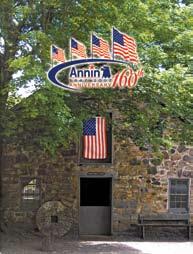
abo V e : The 160th anniversary catalog showed New Jersey’s historic Waterloo Village.
belo W: A dye jig in South Boston. Annin has dyed its own nylon since 2007, making the flagmaking process more efficient.
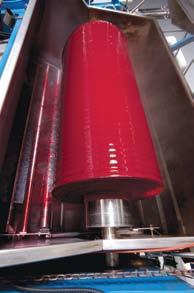
LLC, and it now dyes all its own nylon. Star Fields, located in Cobbs Creek, Virginia, was founded as d&P Embroidery Company. The familyowned firm was a supplier to Annin. Former d&P owner david downs remained with the company after the changeover, ensuring a smooth management transition. “The acquisition enables us to secure an uninterrupted flow of domestically produced star fields,” Carter beard points out. “Annin’s customers will continue to receive American flags made with only the finest u.S.-made components.”
Similarly, the decision to self-dye fabrics will help Annin take greater control of the overall process and realize new efficiencies. Annin used to secure material through intermediaries called converters, who buy fabric from weavers and send it out to have it dyed. That was the norm until 2007, when dyeing equipment was installed in South boston. The dye jigs, like the dream Machines, occupy space once taken up by silkscreening tables.
“A very big project,” Rich acknowledges. “but investing in the dyeing process is a big step to the future.” It has the potential to keep costs down without sacrificing quality.
In tandem, Annin has invested in state-of-the-art integrated business systems. Its Web site, www.annin.com, provides a direct link to allow b2b customers to process and track their orders online at www.anninonline.com. “This business is all about relationship selling,” Carolyn notes. “When we first announced the new online capabilities, we got calls from customers saying, ‘does that mean I can’t talk to you anymore?’ No, we explained, we are just offering you another way to do business. you can fax us, you can phone us, you can go on our Web site, or you can use our EdI (Electronic data Interchange) system. No matter how you want to do it, we want to be able to offer that to you.” Customers submitting art files for custom flags and banners have access to Annin’s FtP (File transfer Protocol) site.
Annin has converted almost all of its packaging from hard-plastic clamshells to materials that are easier for most customers to display— and easier for consumers to reuse and/or recycle. (Clamshell packaging is still provided to customers that prefer it.) “We liked the idea of being more green and cost-efficient,” Sandy says. “And so do our customers. one of the ways we’re all being evaluated these days is on sustainability.”
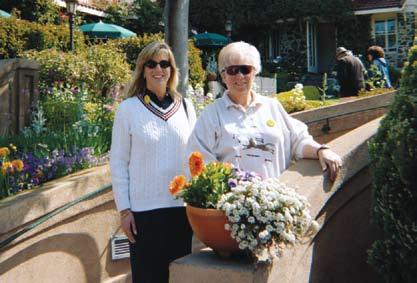
a
nnin shareholders Carol Dennis Fielding and Barbara “Bebe” Beard are cousins. They grew up in New Jersey and inherited partial company ownership from their mothers, Jean Ames Dennis and Edith Ames Beard, who were the daughters of Louis Annin Ames.
During their school years, Carol and Bebe (also known as Barb) did summer work at Annin and Danco. “I remember walking across the George Washington Bridge to check the installation of a flag there,” Carol recalls. Unlike their brothers, they decided not to make their careers at Annin. But both of them lead fascinating and successful lives.
Carol and her husband Ted, a career U.S. Navy man, settled in Redding, California after many moves. In 1986 they launched Ono Enterprises, a flag dealership. Ono means “good” in Hawaii, where the Fieldings had lived. “No one knew what it stood for, so the name became The Flag Center,” Carol notes. With Ted’s moral support, Carol ran the business, landing such accounts as Bank of America and the States of California and Washington. The Flag Center also created custom flags and banners for “a ton of rodeos, Western fairs, and parades.”
“While I had the business, I was also very involved in the community—I still am—from the Chamber Board to the VFW, Shasta County Arts Council, and more,” she notes. “Grandpa Louis was an avid volunteer, as was my mother, and my brother Jack and I were brought up volunteering.” Widowed in 1997, Carol sold Ono in 2000. She now devotes her time mainly to the service organizations Soroptimist International, Women of the Legion of Valor, and Hospice. Deeply perceptive about her family’s history, she has vivid memories of her granddad, who died when she was 16. “Mom and I went often to Essex Fells to say hello,” she recalls. “Grandpa would talk about his late wife, Abby, whom he clearly missed.” Carol has some of Louis’s furniture and household goods, which she cherishes. Bebe has been a Californian since the summer after her graduation from Michigan State University, when she visited the Bay Area and fell in love with it. Instead of driving back to New Jersey as scheduled, to teach in Summit, she found a job in Vallejo. That launched a distinguished career in physical education, which culminated in Bebe’s position as commissioner of athletics for 25 high schools. Along the way, her adopted state honored her as Athletic Director of the Year and deemed her one of ten “trailblazers for women’s athletics.” She was named Coach of the Year and Athletic Director of the Year three times for the central coast (125 schools). And she won a national high school coaching award in basketball. During her decades as a full-time educator, Bebe also built and ran a gymnastics club in Almaden Valley. Listed in Who’s Who in America, she remains active playing tennis, golf, and pickleball, a racquet sport that blends badminton, tennis, and table tennis.
Bebe has fond memories of playing softball at Annin’s 1950s picnics. In fact, she is pictured on page 33 of this book—she’s in the top row, farthest right, sitting on the shoulders of her father Cameron Randolph Beard. Look closely to see her New York Yankees t-shirt. “Even after 50-plus years in California, I still like to get back to New Jersey,” she says, “and I’m still a Yankees fan.”H
le F t : Sandy Van Lieu and Barbara “Bebe” Beard in California, 2003. right : Carol Fielding and Sandy at the Plaza Hotel’s Christmas display in New York City, 2010.


leadership transitions
From generation to generation, Annin has been fortunate to have welleducated, highly qualified family members in place for succession. As sixth-generation vice presidents, cousins Carter beard and Sandy Van Lieu were active in the company’s acceleration and expansions. Equally important, both were (and are) passionate about extending Annin’s flagmaking tradition into the 21st century.
The transition from Joe LaPaglia’s leadership began when he announced in 2008 that he would retire on december 31. The board voted to promote Lindley Scarlett to the presidency for 2009 and 2010. At the same time, in order to ensure an orderly transition beyond Lindley’s twoyear term, a subcommittee of the board began to address the succession issue. The group gave priority to Carter and Sandy; both were interviewed at length. The subcommittee had the right to recommend that the board bring in other candidates, if they decided that neither of them was qualified. but they looked no further. In May 2009, the board announced that Carter would become president on January 1, 2011.
From 2009 into 2010, the company started putting the pieces of the transition into place. Sandy became senior vice president of sales. Chief financial officer Kenneth “Ken” baum was similarly promoted, adding senior vice president of finance to his title. Ken had been recruited by Joe, with whom he had worked at Price Waterhouse. Rich Caramagna moved up from director of manufacturing to vice president of operations. bob Caggiano was promoted to vice president of commercial sales.
to round out this team, the company needed a top-level marketer. Fortunately, the right person was at hand. In 2009 Lindley had hired Mary Repke as a consultant on a major e-commerce project called Weblink (more about that in Chapter 6). Mary had 25 years of experience in product marketing and business development at such companies as Sharp Electronics. Her career included 10 years at Faber-Castell, where she’d worked with Lindley and Joe, and a stint as president and chief operating officer of a dot-com startup. With her knowledge of channel marketing and e-commerce, Mary was an ideal fit for Annin. “We’d always been a manufacturing-driven company with a sales force that sold the product,” Carter comments. “We are transitioning into a marketing-driven company with a sales force that executes the marketing programs.”
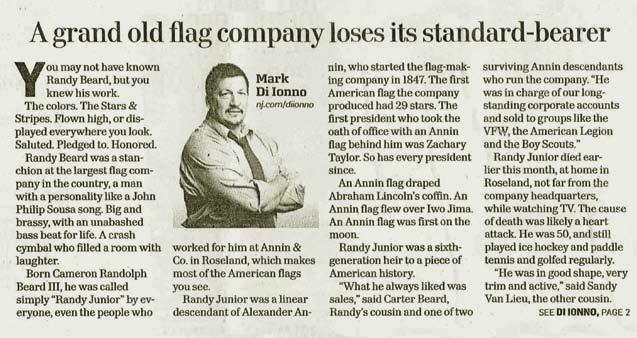
The year 2009 was also notable for a heartbreaking reason. Randy beard III, vice president of corporate sales and custom business, and a cousin to Carter and Sandy, passed away suddenly in early december. Randy was engaged at the time of his passing to Ann Appel, Annin’s general accounting manager. He had just turned 50. “It was a blow to everyone here,” Carter says. “We are a close-knit company, and in some ways we still have employees recovering from Randy’s passing. I miss him more than I can say.”
While Annin entered 2010 on a sad note, employees summoned the energy to carry on. Mary came aboard full-time as vice president of marketing in April. In May, Marvin Lao joined as manager of national accounts, replacing Randy beard. He is Carter’s brother-in-law. “Marvin had a suitable background to work with these accounts,” Carter notes, “and there was some comfort in having a family member succeed Randy.”
As Lindley’s tenure neared its end, important developments were in progress: the acquisition of competitor FlagZone, the rollout of Web-link, and new thoughts about branding. These things and more would come to fruition as Carter stepped up to the presidency in January 2011. H
This tribute to Randy Beard III ran on the front page of The Star-Ledger, New Jersey’s largest newspaper, on December 19, 2009. It accurately described Randy as “a sixthgeneration heir to a piece of American history.”
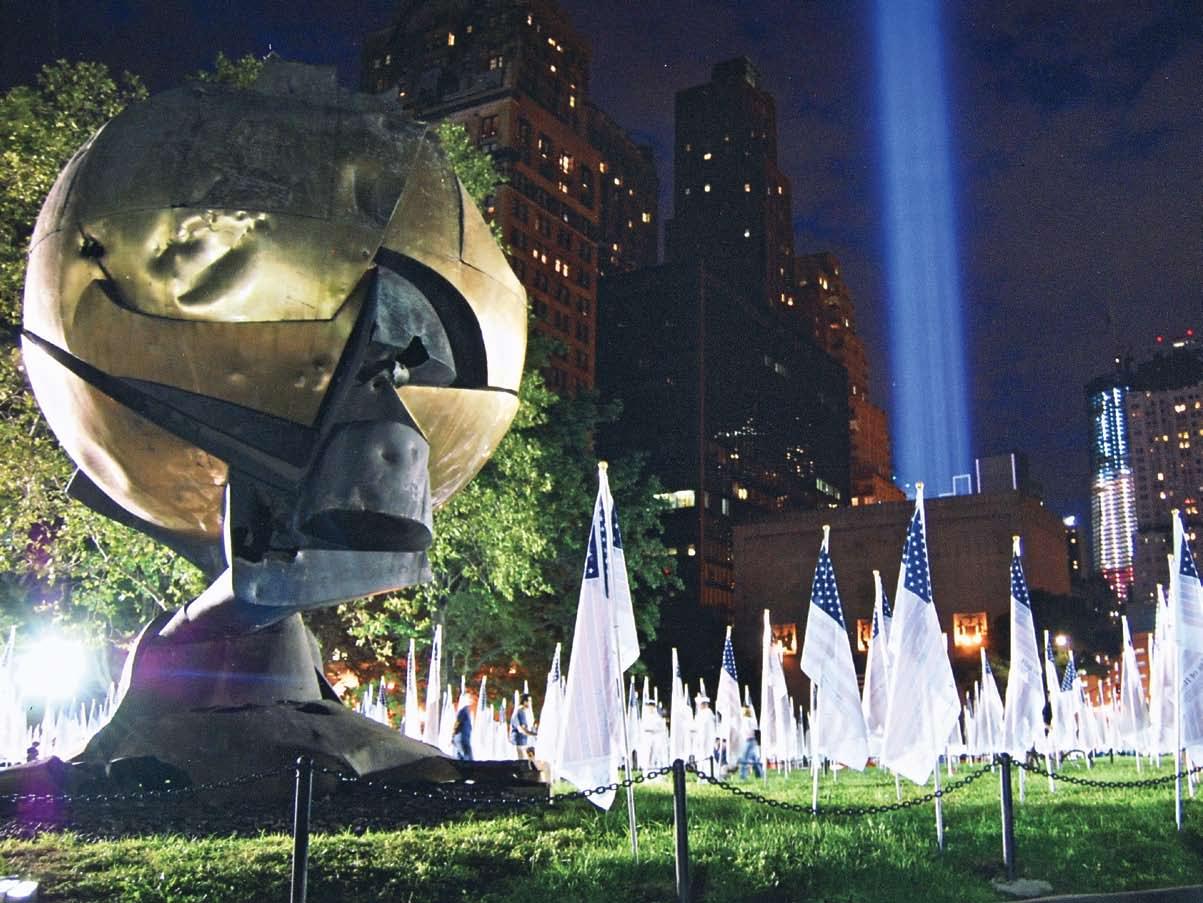
We are proud to be the sixth generation of the annin family working at annin. We strive to honor this legacy by investing in the most advanced technologies and processes to ensure that our flags remain the benchmark of the flag industry.
—Carter Beard, President, 2013

c ha P ter s i X

For most people, the first day back at work after New year’s is low-key. We share holiday news, catch up on email, and perhaps straighten up our files for the year ahead. For Annin, the first workday of 2011—Monday, January 3, to be exact—was far more notable. It was Carter beard’s first day as president, and it was Annin’s first day in the marketplace as the new owner of FlagZone, a company that had been a significant competitor.
FlagZone acquisition
Just as Carter’s succession had been well-planned in advance, so too was Annin’s acquisition of FlagZone.
FlagZone’s history creates a kind of circle within the larger Annin history. When Annin acquired dettra Flag in 1998, it consolidated many operations of the two companies in an attempt to maximize synergy. Sales vice president Matt Conway and operations vice president Joe Price came aboard, but their positions essentially duplicated those within the existing structure. They left Annin. together with former dettra president Elmer bauer, they obtained venture capital for a new enterprise called FlagZone. They set up headquarters and a plant in Gilbertsville, Pennsylvania; like Annin, FlagZone would make its flags in the uSA.
The new company entered the marketplace in January 2000 and soon earned a reputation for quality and aggressive pricing. It was a key player by 2001, when the industry experienced the surge in demand for u.S. flags after the terrorist attacks of 9/11.

to P: Carter Beard, 2013.
belo W: FlagZone became part of Annin in 2011 but operates as its own entity.
o PP osite : “One Life—One Flag” marked the tenth anniversary of 9/11 at the Remembrance Field of Honor in Battery Park, Manhattan.
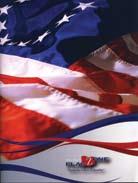
Fast-forward to 2009. by then FlagZone’s core team—including Kurt Koloseike, an initial investor who became president—had grown the privately held company to some $20 million in sales. Through informal talks, Annin determined that FlagZone was open to buyout offers.
“I brought the possibility back to Lindley, who agreed it was something to pursue,” Carter says. Ken baum conducted the financial due diligence. “We had to model it out to see if the acquisition would be economically feasible,” Ken says. The companies and their boards came to an agreement. both sides worked long hours and weekends through the 2010 Christmas holiday in order to close the deal by year-end.
applying lessons learned Annin had learned certain lessons the hard way following the dettra acquisition 12 years earlier. back then, the goal had been to combine operations as fast and as thoroughly as possible. What seemed efficient to Annin, however, seemed disruptive and upsetting to many dealers and customers. They felt dettra “disappeared” into Annin, and they complained in no uncertain terms.
“There are different elements a dealer or customer might like in a company,” Ken notes. “you get attached to a certain person in customer service or a particular quality of a particular product.” Annin mended fences, but it took time. With FlagZone, then, Annin took an entirely different tack.
under Annin ownership, FlagZone exists as its own entity. It kept its name, its salespeople, its customer service staff, and its office and plant in Gilbertsville. Personnel from the shop floor to the executive office remained in place. Even the company’s Web site (www.theflagzone.com) and tagline (“Flying the Colors of Quality”) did not change. “Customers can look and see for themselves that Annin and FlagZone are two separate companies,” Ken emphasizes.
Naturally, Annin provides the financial and regulatory oversight that any corporate parent is responsible for. It also offers certain capabilities new and advantageous to FlagZone. “We do have the ability to dye our own fabric, and we have a large operation for state-flag printing that FlagZone didn’t have, so we’ve become an intercompany supplier to them on some items,” notes Sandy Van Lieu. “but FlagZone still has plenty of independent suppliers as well.”

the best people to write the book on company culture are the people who work there. That’s the message that Zappos.com founder Tony Hsieh delivered to the world a few years ago. Specifically, Zappos pioneered a technique called a Culture Book in which employees say in less than 500 words what their employer’s culture means to them. Two things ensure that the Culture Book stays real: the replies are anonymous, and company leaders share them verbatim. That way the Book reflects the positives, the negatives, and everything in-between. Annin employees wrote their first Culture Book in 2012. “They gave their true opinions,” Carter Beard affirms. “They really cared. The Book showed we already had a pretty good culture, but we found areas we can improve. It’s an open and honest exercise. As we do the Culture Book in succeeding years, we’re working toward improvement.”
Quotations in red were written in Annin’s Culture Book by employees taking part in the Results-Only Work Environment (ROWE) program.

“being able to work anywhere at any time and be judged by your output rather than hours is a huge plus! . . . . i feel that roWe motivates me to a whole new level and my results have been even that much better.”
In the same vein, Annin rolled out ROWE with employees at its headquarters in September 2012. ROWE stands for Results-Only Work Environment, and it focuses on results instead of the time clock. Employees are free to leave traditional schedules behind and have control over their work environment. Today’s technology allows them to work where, when, and how they want. What counts is the results—that’s what folks are measured on. “After reading and hearing about ROWE, a core group here voted to implement it,” Carter says. “One year into it, ROWE has already made our home office a more creative and enjoyable place to work.” Quite innovative for a company entering its 167th year! H
“ the fact that annin wants to change the way we think and operate by exploring the roWe way of working has been very exciting and i hope will reenergize us as a company and lead us into the next phase of our existence.”
Carter spent much of his first year as president managing the acquisition and getting to know all the people at FlagZone. In all, the lessons-learned approach has paid off for the companies and customers alike. “The process has been almost seamless,” he confirms, “and FlagZone is helping us grow.”
Web-link is an e-commerce system for Annin dealers that was initiated by Lindley Scarlett in 2009, using a business model created by Mary Repke first in a consulting role and then as vice president of marketing. Project director Carolyn Albanese led the functional team that designed Weblink in 2010 and 2011. The platform launched in 2012. dale Coots took the lead on creating the master database, an arduous responsibility that involved scripting almost 4,000 item descriptions, arranging for the photography of each item, and then cross-mapping the items with attributes and images to maximize search engine optimization and in-site search for the platform.
The focus of Web-link is Annin’s dealer network of specialty flag retailers. “our dealers are essential to our business,” Mary Repke emphasizes. “We invested in Web-link to give our dealers the opportunity to have a highly advanced Web site to make it easier for them to thrive in a marketplace that’s increasingly attuned to using the Internet to do business.”
Like all entrepreneurs, dealers are concerned first and foremost with running their businesses—which usually takes 100 percent of their time and often doesn’t leave much budget for sophisticated technologies. Weblink has provided these busy businesspeople with an affordable, world-class Web platform that allows them to compete with mass marketers, while still providing the personal touch that local buyers appreciate.
because Web-link integrates into Annin’s SAP system, retailers who use it have real-time, automatic updates on Annin inventory. Most dealers stock from 200 to 500 items, but through Web-link they have instant access to all 3,800 items in Annin’s catalogs. Through Web-link they can order whatever items they need and be assured of timely delivery. The site allows them to add their own products, make their own updates, customize promotions and pricing, and add images.

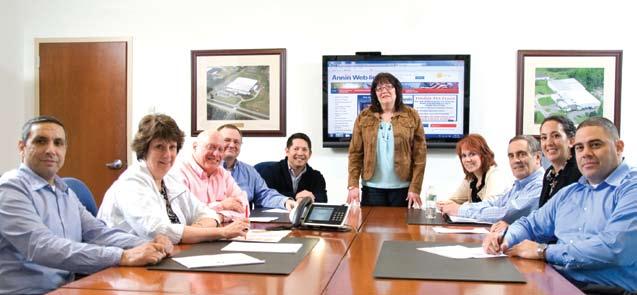
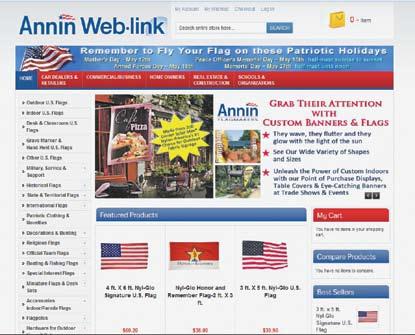
Giuliano, and Edwin Lopez.
le F t : A template of the site. Flag retailers in Annin’s dealer network customize it with their own name, branding, products, and promotions. The underlying technology links them to Annin’s inventory and shipping systems.
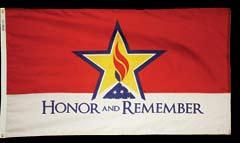
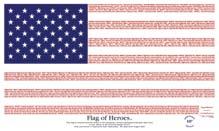
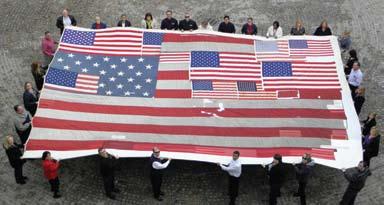
For the tenth anniversary of 9/11 in New York City, Annin created a “Field of Remembrance” consisting of one flag for each life lost and 93 country flags representing the nations that lost lives that day. “We outlined almost half of Battery Park with more than 3,000 flags,” Mary Repke says. Bob Caggiano worked with the Flag of Honor Project to secure corporate and military volunteers to provide the support needed to make this field possible. Bob states: “From getting the poles manufactured and tenth anniversary of 9/11
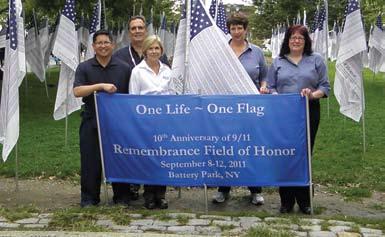

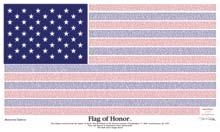
annin makes three flags that commemorate fallen citizens: the Honor and Remember Flag, designed by George Lutz, an American father who lost his son in Fallujah, Iraq; the Flag of Heroes, which honors first responders in the 9/11 attacks; and the Flag of Honor, which contains the names of every 9/11 victim. The latter two flags were designed by John Michelotti to immortalize the individual victims and to give comfort to their families. Proceeds from their sales are donated to three nonprofits: Voices of September 11th, an organization for 9/11 families, rescue workers, and survivors; the Wounded Warrior Project, which honors and supports injured service members; and the National September 11 Memorial & Museum on the site of Ground Zero in lower Manhattan.
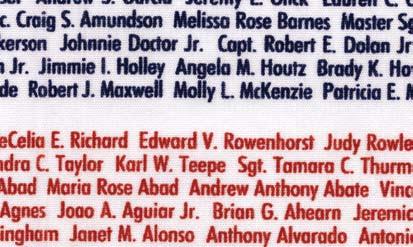
transported into lower Manhattan, to the installation, lighting, and security, we were humbled by the companies that helped make this tenth anniversary event a possibility.” Installed on September 7, the field was open to the public for five days beginning on September 8, 2011. Employee groups from Annin took turns volunteering at the site. “It was very emotional,” Mary recalls. “We helped people find the name of their friend or family member on the flags, took photos of folks with the flag, and listened while visitors shared their stories.” H
le F t , to P to botto M: Displayed by Roseland employees in July 2011, the main part of the National 9/11 Flag was rescued from the rubble of the World Trade Center. Under the auspices of the New York Says Thank You Foundation, the flag has traveled to other U.S. disaster sites for ceremonies in which local flags were added as a sign of healing. Annin workers reinforced the flag throughout its journey. The Foundation’s goal was to make the flag whole by 9/11’s tenth anniversary. It will eventually reside in the museum at Ground Zero.
Many Annin employees volunteered at the Field of Remembrance in September 2011, including (left to right) Marvin Lao, Bob Caggiano, Rose de Knegt, Mary Repke, and Carolyn Albanese.


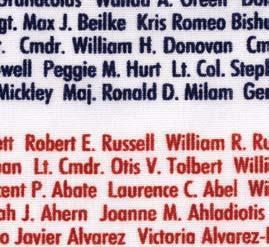
abo V e : The stripes on the Flag of Honor, seen here at actual size, contain the names of those who lost their lives in 9/11.
belo W: This commemorative sheet accompanied the limited edition flags.
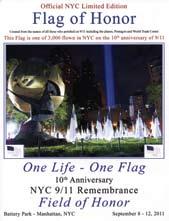

The interface is consumer-friendly, too. Shoppers can browse by type of flag: u.S., state, military, and so on. or they can navigate according to the type of organization they are, such as a school or business, and quickly find the selections they’re likely to be looking for.
“After launching Web-link 2.0 in 2012, the next step has been to work with dealers on marketing techniques that will drive consumers to their sites,” states dale Coots. by the end of 2013, Annin hopes to have 70 dealers up and running with Web-link. “Aggressive dealers can really take this platform and run with it,” Marvin Lao adds. Another benefit of Web-link is that it showcases the Annin brand.
Within the industry and among retailers, Annin & Co., Inc. has been synonymous with flagmaking for virtually all of its 166 years. Among consumers, however, the name was not instantly recognizable. That is changing, thanks to a recent initiative to rebrand and update the Annin identity. As a first step, Annin drew on its history to redesign its logo. A photo of the Fulton Street “manufactory” from the early 1900s revealed the words “Annin & Co. Flagmakers” on the windows of the building. The words “& Co.” happened to be obscured. but that provided inspiration. The new logotype streamlines the name to “Annin Flagmakers” in a modernized font, with a star dotting the “I” and stripes flying above the “N.” Fittingly, the design appears in blue and red on a white background. “Since 1847” appears nearby, in some usages, referencing the year the company was founded.
The logo became the core of Annin’s visual identity. It is featured on business cards, stationery, product labels, the Web site (www.annin.com), and even corporate clothing for employees. It also helped spark a revitalization of the company’s catalogs. “Everybody sees our products but they don’t always know how they’re made, so we did photo shoots of the production process at our plants,” Mary explains. Catalog pages now show the product being manufactured, on the same page as the finished product. “We’re sharing a bit of our own story on each page.”
Ripples flowed outward as the rebranding gained momentum: a Wikipedia page; a new company video, viewable on the Web site; and even a sequence on the AbC World News tonight national series “Made in America” with diane Sawyer, which filmed part of Annin’s story
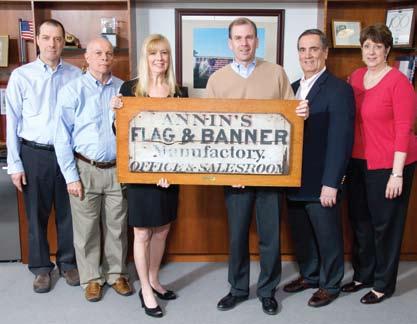
abo V e : Annin’s Management Committee in the Roseland boardroom, 2013: Rich Caramagna, Ken Baum, Sandy Van Lieu, Carter Beard, Bob Caggiano, and Mary Repke.
right : Annin featured its new logo on many branded items.
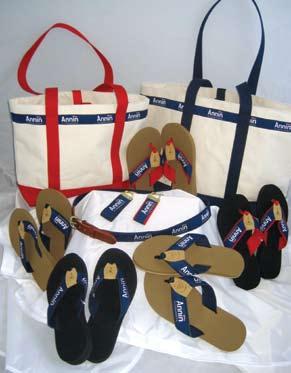
at the flagmaking facility in Coshocton, ohio. “That started the media machine running in a different way,” Sandy adds, noting that Annin has since been inducted into the Made in the uSA Foundation’s Hall of Fame for its commitment to u.S.-made goods.
The united States olympic Committee also reached out to Annin for its “Raise our Flag” fund-raising campaign for the 2012 Summer Games in London, England. uSoC supporters donated money to buy stitches in a virtual flag, visible online as it took shape. The campaign raised $351,084 from 29,257 donated stitches in support of America’s olympic and Paralympic athletes. Annin manufactured the real flag, a 6-by-10-footer that was proudly displayed in the athletes’ village and presented to President obama by the u.S. olympic team on November 15, 2012.
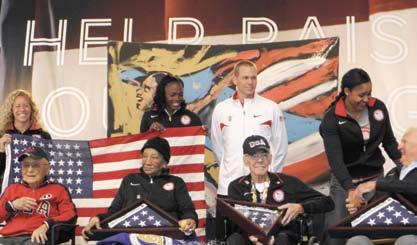
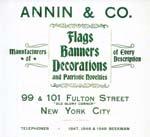
At its founding in 1847, Annin didn’t have a logo. That wasn’t unusual, as branding hadn’t yet taken hold. Most businesses were family businesses. The name alone was sufficient, used in advertisements and catalog pages like this.
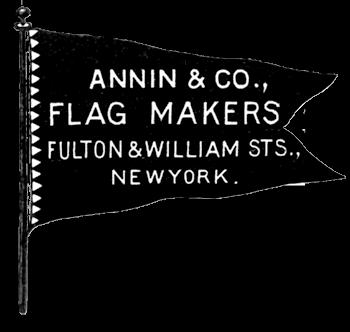
This banner qualifies as Annin’s first logo. The company was proud of its excellent location on Fulton Street, in lower Manhattan near the harbor, so the address figured prominently.
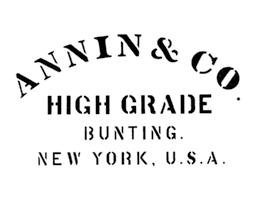
Although not technically a logo, this stencil appeared on thousands of shipping crates and boxes. Note the addition of “U.S.A.” Annin’s international trade began in 1851 with flags supplied to the Great Exhibition in London, England.
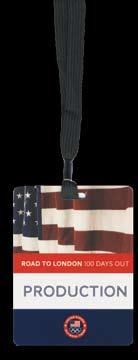
F ar le F t : The U.S. Olympic Committee “Raise Our Flag” kickoff in April 2012.
le F t : Backstage pass for a “Raise Our Flag” event.


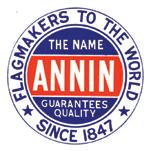
Used for decades, this seal is typical of the era: name, founding date, ID, and tagline, all in large capitals that emphasized Annin’s global reach and longevity. The designer may have been Annin president and artist Digby Chandler.
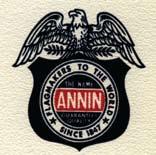
The bald eagle, national bird of the U.S., made its debut in Annin’s logo in the 1960s. At first it simply surrounded the existing logo.

As contemporary as Annin Flagmakers has become, it retains a strong sense of tradition. Indeed, given the mergers and acquisitions of the past decades, only a handful of New Jersey-headquartered companies of all types can claim continuous histories under the same names. In its home state, Annin’s longevity places it among such esteemed counterparts as Campbell Soup, Congoleum, Marcal, Merck, Public Service, and Prudential. Its ohio and Virginia plants are solid corporate citizens as well, adding to the financial and civic strength of Coshocton, ohio, and South boston and Matthews County, Virginia.
Like all companies that endure, Annin continues to invest in new technologies. The Reggiani dream Machines, added in the mid-2000s, were supplemented in 2012 by the Reggiani Renoir digital printer. both



1968
A golden version of the bald eagle adorned the interior of Catalog Number 900. The cover, at right, introduced the eagle’s head surrounded by stars and the company name. This logo stood on its own and then formed the basis for variations, all with eagles. In these years Annin worked with Hayden Advertising, making it likely that the eagle logos were created by a Hayden artist—possibly Newt Heisley, who designed the POW-MIA flag.


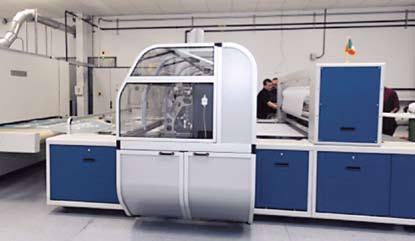
Introduced in 2012, the Reggiani Renoir digital flag printer works three times faster than the earlier Dream Machines.
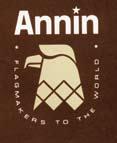
For the first time, a star dotted the “i” in Annin. “Flagmakers to the World” returned as a tagline. The eagle became more stylized, and the company moved away from the red, white, blue, and gold colors used prior. 1981


The eagle held its ground, but the company name grew in size and visual impact. The tagline once again featured the founding date of 1847, befitting the fact that Annin (approaching 150 years in business) was the oldest U.S. flagmaker.
The centerpiece of Annin’s rebranding, this logo restored the classic U.S. flag color palette and added flowing stripes to the star dotting the “i.” A subtle register mark appeared for the first time, for legal reasons.
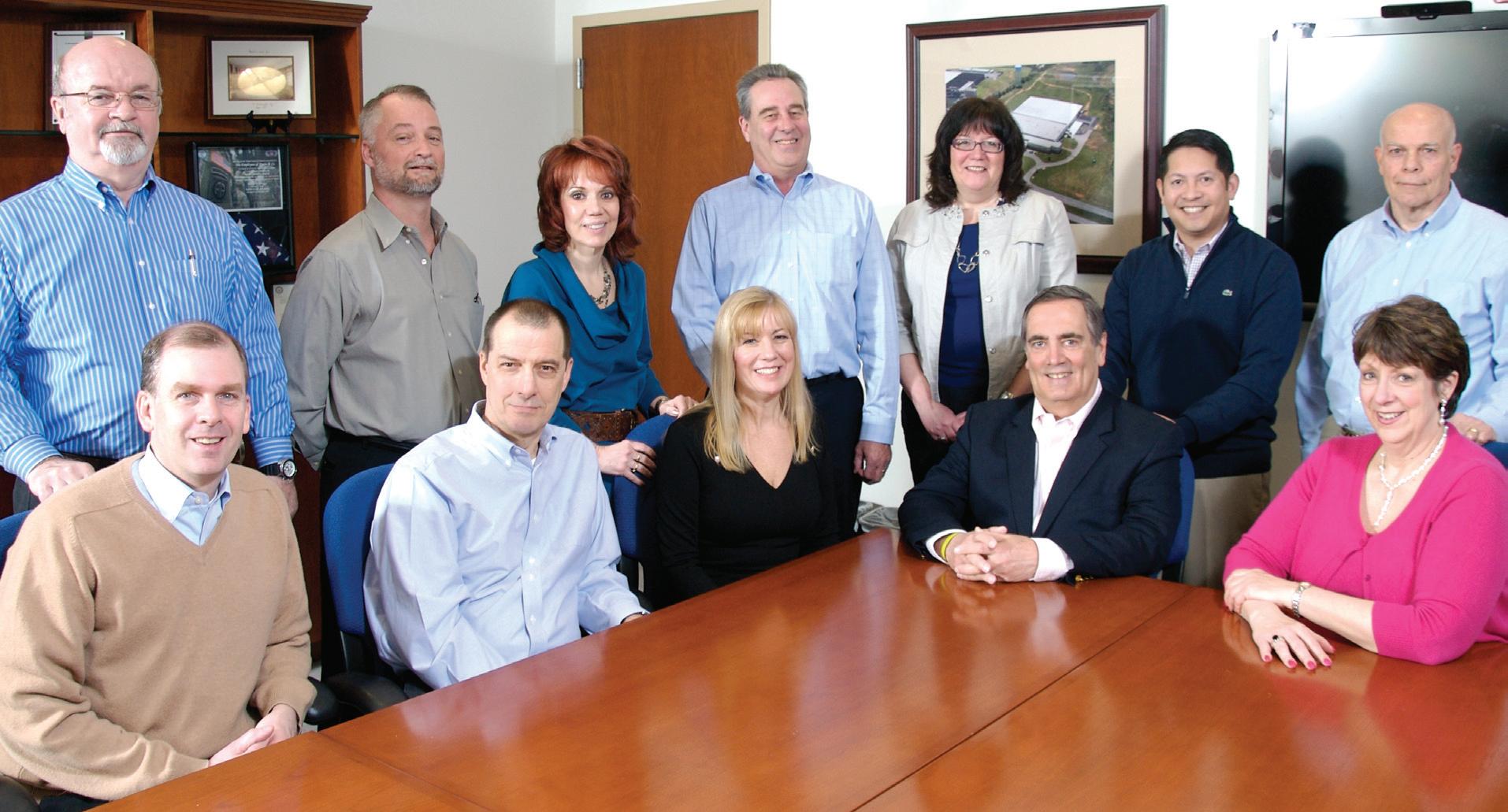
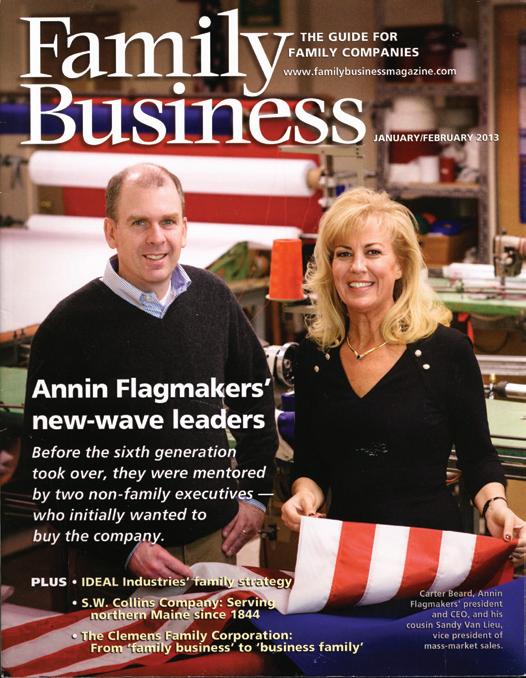
ABOVE: The Annin Operations Committee and key employees in the Roseland boardroom, 2013. Front, left to right: Carter Beard, Rich Caramagna, Sandy Van Lieu, Bob Caggiano, and Mary Repke. Back, left to right: Joe Brennan, Dave Gregory, Dale Coots, Bob Goman, Carolyn Albanese, Marvin Lao, and Ken Baum.
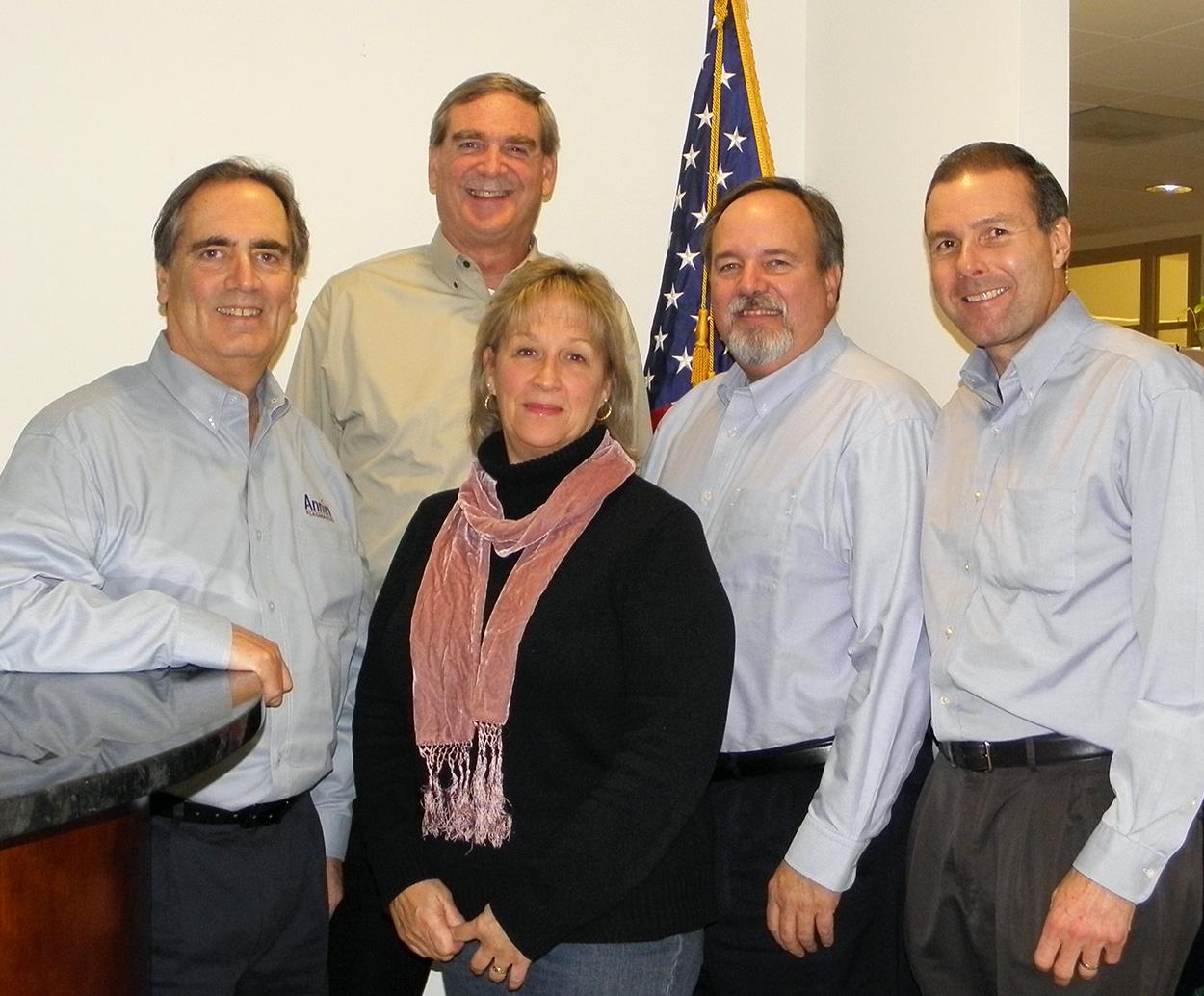
ABOVE: The Annin Commercial Dealer Sales Team in the Roseland headquarters, 2013. Back row, left to right: Bob Caggiano, Bill Johnson, Ron Ryan, and Chuck Opramolla. Front: Team sales assistant Kathy Lubanski.
ABOVE: The company was the cover story in the January-February 2013 issue of Family Business magazine.
types of machine operate on the same mechanical principle, but the renoir works three times faster and thus is capable of printing three times the volume. reggiani and annin worked closely together on the testing. at star fields, the subsidiary that embroiders stars for the U.s. flag, a new machine called the epoca has also tripled outputs. That machine is made by saurer, an old-line swiss supplier with which annin has a similarly long and trusted relationship.
Ultimately, every company’s success depends on people. annin’s workforce of 500 has a healthy respect for tradition, coupled with an ability to innovate. many employees have 20 to 35 years of experience with the company, and many more have similar experience within the flag and textile industries. “The veterans really taught us right,” says returns
manager laverne Phillips, who relocated from Verona to south Boston. “randy Beard, lee Beard, Jack Dennis, ed gregory—they taught us the product, how it was sewn and how it was supposed to look, the threading, the end result, and all the rest. everybody in america knows annin’s product, even if they don’t know our name, because it’s the best-quality flag available. Our merchandise speaks for itself. and we stand behind it.” like the five generations before them, Carter Beard and sandy Van lieu will face their own challenges of how to grow the company. But in the spirit of their ancestors—from the scottish-born John Johnston annin through louis annin ames forward—they will lead annin on firm footing toward its 200th anniversary. When that milestone arrives, the seventh generation will possibly be carrying on their work. H

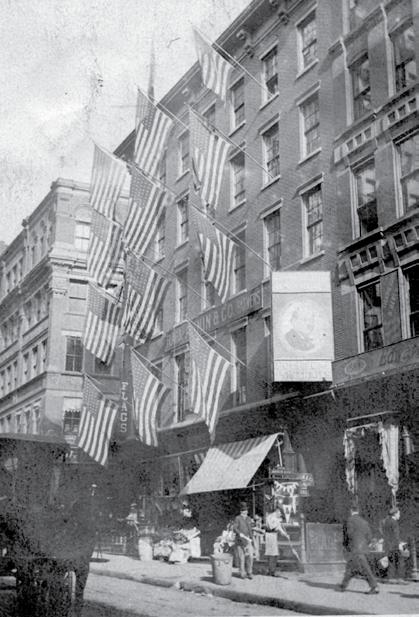
99–101 Fulton Street in the 1800s. Catalog interior, 1862.

1688
John Johnston born in Annandale, Scotland
1715
Johnston emigrates to New Jersey, becomes known as John Annan or Annin
1820
John’s great-grandson, Alexander Annin, opens a ship chandlery on Fulton Street, New York City; makes and sells flags along with nautical supplies
1847
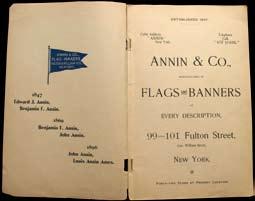
Alexander’s sons Edward and Benjamin found Annin Flag Manufactory, devoted strictly to flags; Annin supplies flags to the U.S. Army for the Mexican War
1849
Starting with U.S. President Zachary Taylor, Annin supplies flags for every presidential inauguration

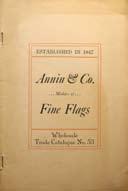
1850s
Edward and Benjamin’s brother John Annin joins the company
1851
Annin begins supplying flags to World’s Fairs and yachting events such as the America’s Cup race
1860s
Annin sells 1.5 million flags and emblems during the Civil War; sewing machines come into industrial use
1866
Louis Annin Ames is born to Phebe Annin Ames, sister of company owners
1896
Benjamin dies; Louis joins company as his Uncle John’s full partner
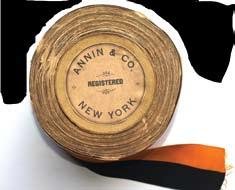

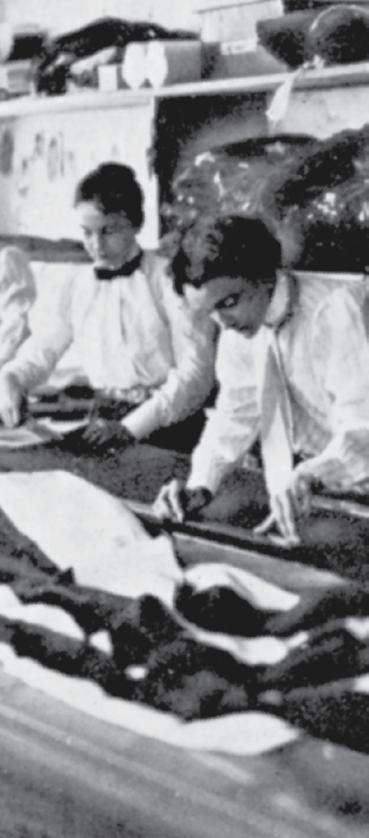
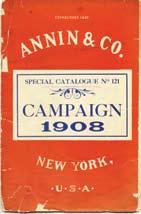


Digby W. Chandler, an artist and designer, joins company
John dies; Louis becomes president; marries Abby Whitney Crowell (they will have two children, Edith and Jean);
Commander Robert E. Peary carries Annin-made flags to the North Pole
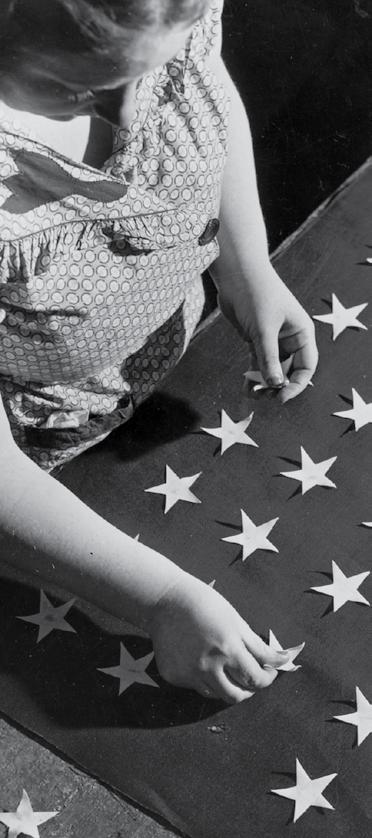

Louis incorporates Annin & Co. 1917
Annin opens training center in Verona, New Jersey 1918-1919
Annin builds state-of-the-art factory at 163 Bloomfield Avenue in Verona
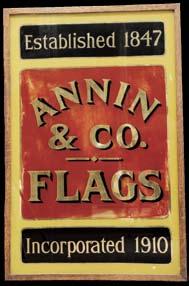

Annin makes the world’s thenlargest flag for J. L. Hudson, a Detroit department store
Chandler named vice-president
1925
Annin doubles the size of the Verona factory; sells Fulton Street building; moves corporate headquarters to 85 Fifth Avenue, New York
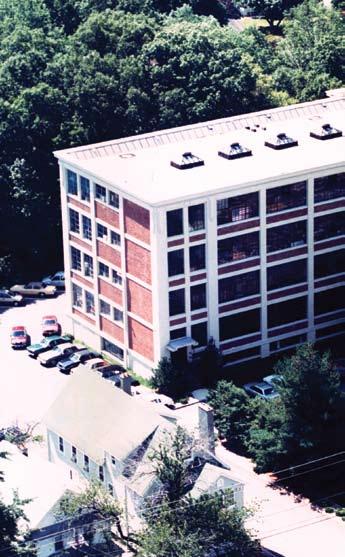
belo W: At the height of World War I, Louis Annin Ames sought and received support from former U.S. President Theodore Roosevelt about a unspecified message to British Prime Minister Lloyd George.
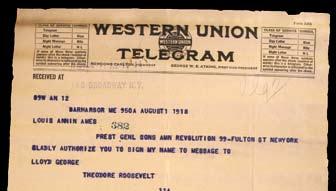
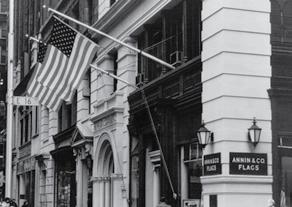
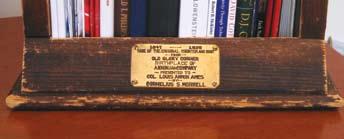
abo V e : Made of wood from Fulton Street’s door and counter, this bookcase was a gift to Louis Annin Ames in 1925. Randy Beard II used it (see page 46). It now resides in Carter Beard’s office.
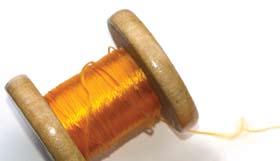
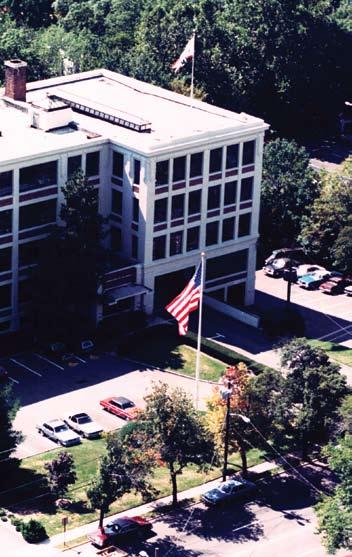
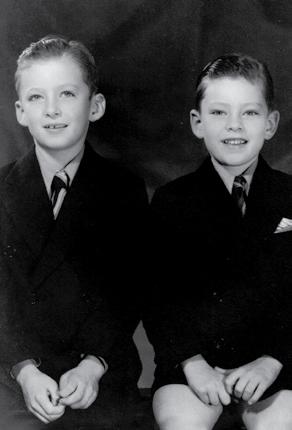
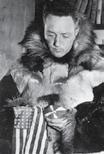
1930
Rear Admiral Richard E. Byrd carries Annin-made flags to the South Pole
1930s
Financial crises lead company to bankruptcy in 1936

1936
C. Randolph Beard I (Randy I), Louis’s son-in-law, joins company
1937
William C. Dwiggins joins company
1938
Annin emerges from bankruptcy
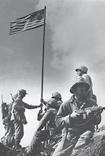
1940
Business revival is aided by New York World’s Fair and World War II; Annin-made flag signals victory at the Battle of Iwo Jima

1947
Development of Nylanin, patented textile that is 75 percent nylon and 25 percent wool; world’s largest free-flying flag hoisted on the George Washington Bridge
1950
Louis retires
1950s
Louis’s grandsons join company:
C. Randolph Beard II (Randy II), Carter Lee Beard (Lee), and John Dennis (Jack)
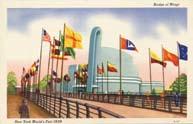
belo W: Randy II and Lee Beard, 1939. The photos of employees, including Louis Annin Ames with a seamstress, appeared in a postwar article on Annin in The American magazine.
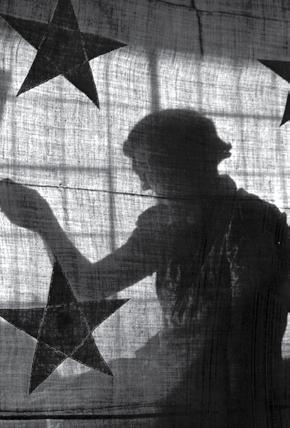
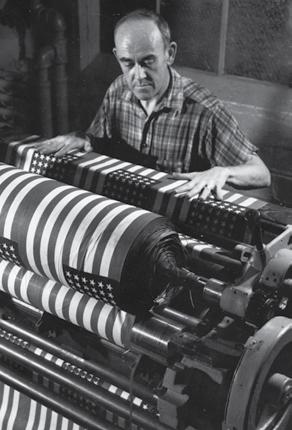
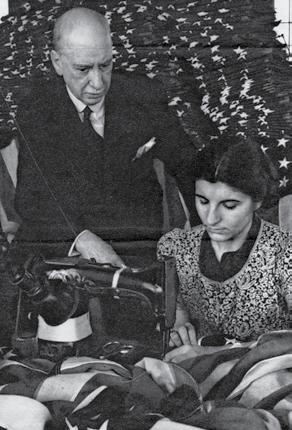
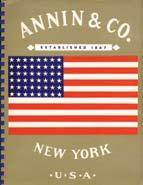

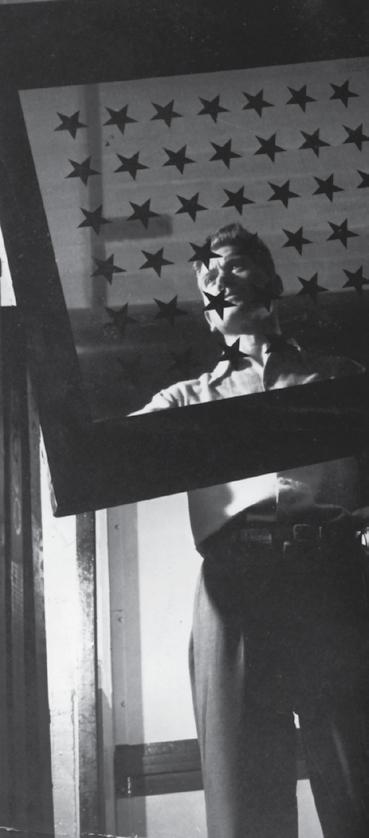
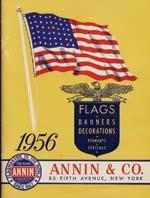

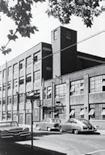
1952
Randy I leaves Annin; Louis dies; Chandler becomes president
1958
Opening of subsidiary Danco (Division of Annin & Co.) in Bloomfield, New Jersey
1959
Alaska and Hawaii become states; business soars with introduction of 50-star flag, designed by Annin
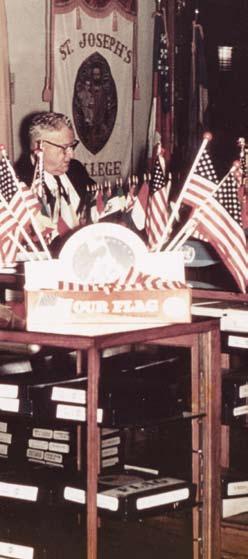
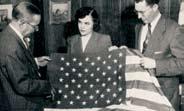

1963
Launch of The Annin Banner newsletter and Betsy Ross Award; Annin-made flag raised by National Geographic Society on Mt. Everest
1965
Annin launches Canadian subsidiary
1967
Chandler dies; Randy II becomes president

1969
Annin-made flags travel to the moon on Apollo 11 and subsequent NASA missions; Annin closes 85 Fifth Avenue, rents sales office at 2 Penn Plaza in Manhattan, and fully moves its corporate offices to the plant in Verona, New Jersey
1971
Newton Heisley, an artist at Annin’s advertising agency, creates the POW-MIA flag

1976
Annin acquires Colonial Flag Co. in Coshocton, Ohio; is named official flagmaker to U.S. Bicentennial
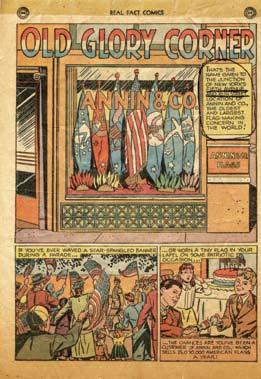
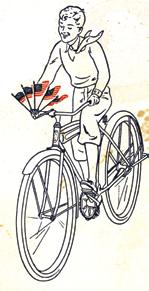
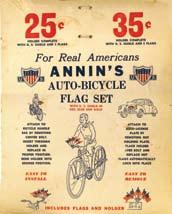
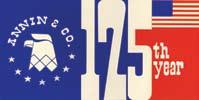
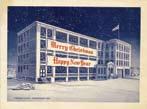
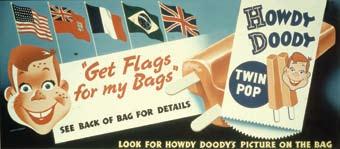
cloc KW ise F ro M F ar
le F t : Inside Annin’s Manhattan office, 1960. Feature from a 1950s comic book. Point-ofpurchase display, 1950s. Logo for 125th anniversary, 1972. Christmas card with Verona building art, 1960. Howdy Doody promotion, 1950s.
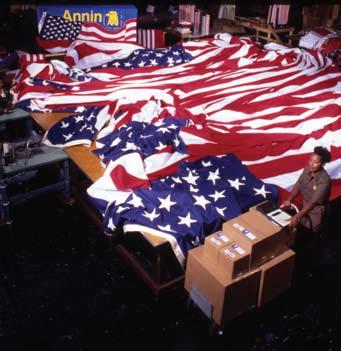
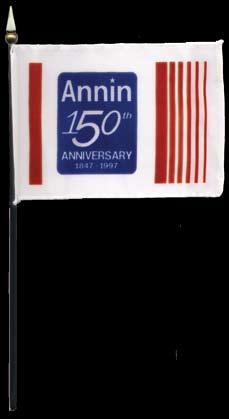

1982
Silk-screening operation opens in Harrison, New Jersey; Annin develops Tough-Tex, a 100 percent spun polyester textile that is extremely durable
1985
Corporate offices move from Verona plant to 55 Locust Avenue in Roseland, New Jersey; C. Randolph Beard III (Randy III) joins company full-time
1986
Canadian subsidiary is closed

1988
Danco plant is a campaign stop for George H. W. Bush’s U.S. presidential campaign; Carter Lee Beard, Jr., joins company full-time

belo W le F t to right : Maritime flags as featured in 1983 catalog. Randy Beard III and his fiancée Ann Appel, Annin’s general accounting manager. Flag etiquette page in 1991 catalog.
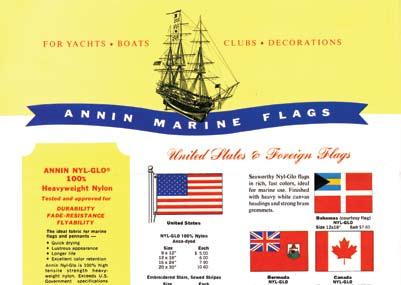
1990
Sandra Dennis Van Lieu (Sandy) joins company full-time
1992
Harrison operation is closed, replaced by Fabric Art Ltd. in Palm Bay, Florida
1996
Terry Schmoyer joins as vice president of operations
1997
Randy II retires; Lee and Jack become co-presidents
1998
Annin acquires Dettra Flag Co.; closes Danco plant; expands into former Dettra plants in Oaks, Pennsylvania, and South Boston, Virginia
1999
Florida plant closes
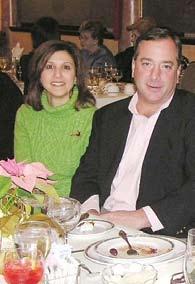
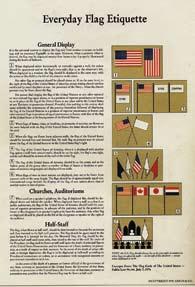
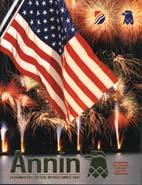

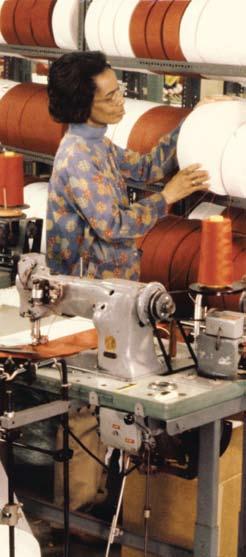
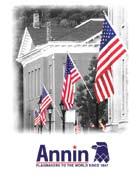


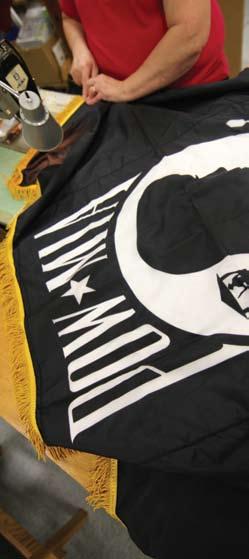
Lee and Jack retire; Schmoyer leaves; Joseph LaPaglia and Lindley Scarlett join as president and executive vice president, respectively
Leased facilities in Coshocton replaced by new, modern plant; terrorist attacks of 9/11 cause unprecedented demand for U.S. flags; Annin operates in crisis management mode for several months
Annin is a founding member of the Flag Manufacturers Association of America

Enlargement of South Boston plant; distribution moves there

Corporate offices move to 105 Eisenhower Parkway, Roseland, New Jersey
Enlargement of Coshocton plant
Introduction of cellular sewing system in Coshocton and South Boston

Purchase of first Reggiani digital fabric printer (“Dream Machine”), which largely replaces silk-screening function in South Boston
belo W le F t to right : Coshocton Plant Manager Rick Merrill and Supervisor Cheryl Bartholow (right) present a “survivor quilt” to co-worker Mary Hawk, 2003. Aerial of Coshocton, 2006.
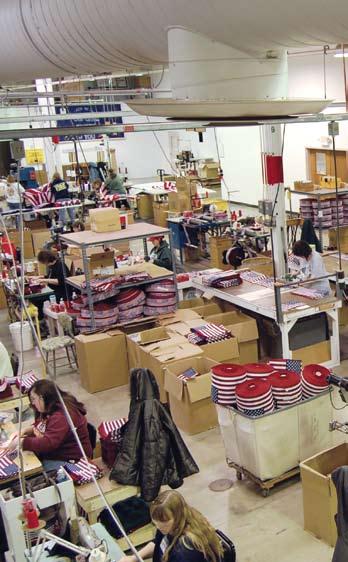
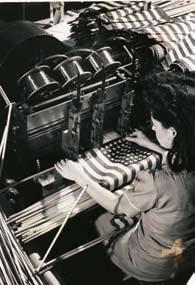
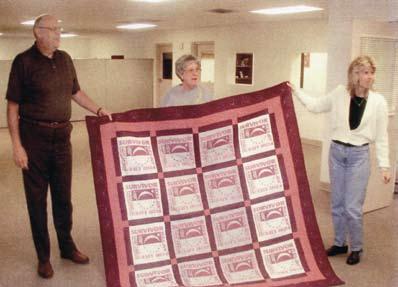
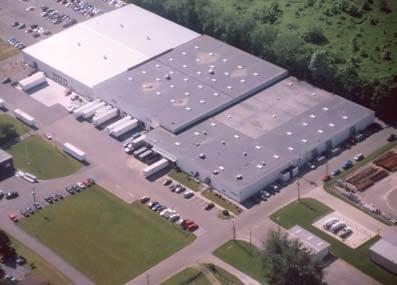
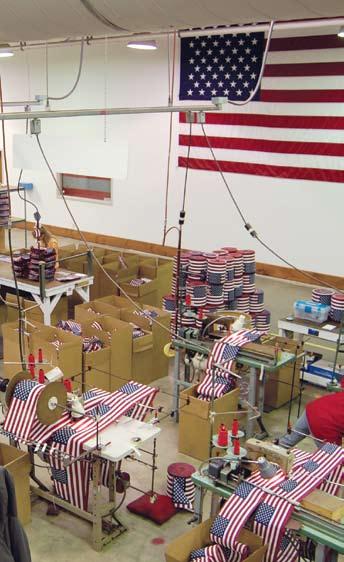
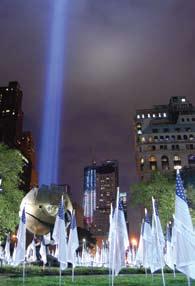

Acquisition of D&P Embroidery Co. in Cobbs Creek, Virginia; name changes to Star Fields LLC
Success of first “Dream Machine” leads to purchase of second for South Boston plant; Annin begins dyeing its own materials
First Epoca for Star Fields followed by second Epoca in 2010
LaPaglia retires; Scarlett becomes president
Randy Beard III passes away in early December
Carter Beard becomes president; his first day in that position coincides with the Annin’s first business day as the owner of FlagZone
Web-link launches; purchase of Reggiani Renoir digital flag printer, three times as fast as 2005’s Dream Machine; release of new company video for dealers and public relations; Annin creates a presence on Facebook (https:// www.facebook.com/Annin1847)

First full year of ROWE (ResultsOnly Work Environment)
belo W le F t to right : Annin’s Field of Remembrance in lower Manhattan on September 11, 2011. Commemorative magnet. Returns manager Laverne Phillips in South Boston, 2013. Carter Beard and Sandy Van Lieu, 2012.
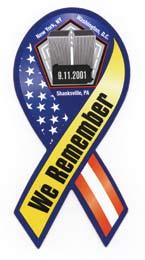
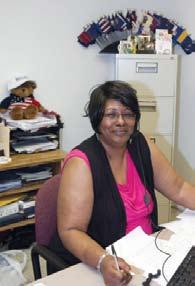
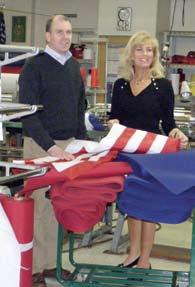
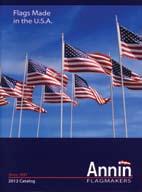

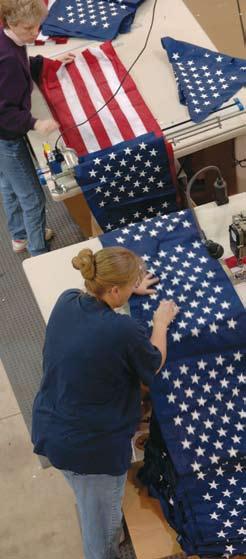
John Johnston Annan 1688–1769
Elizabeth Annan 1692–1759
John Annin Alexander Annin
Joseph Annin 1751–1841 New Jersey state senator
Samuel Annin 1753–1837
Sarah Annin Ross 1789–1876
Cornelius Miller Annin 1791–1845
William Annin 1715–1784 New Jersey state senator
Elizabeth Annin 1768–1809
Elizabeth Annin 1793–1871
James Annin Margaret Annin

Sarah Annin died 1777
William Annin 1761–1800
John Annin 1764–1824 New Jersey state senator
William Annin 1795–1830
Alexander Annin, 1797–1875 Founder of Annin & Co.
Margaret Annin 1830–1905
Edward James Annin 1832–1902
Benjamin Franklin Annin 1834–1896
Alexander Annin 1766–1844
Margaret Miller Annin 1769–1849
Joanna Miller 1763–?
Margaret Annin 1799–1876
Joseph Annin 1800–?
Mary Annin 1804–1863
Susan Underwood Annin 1803–1888
James Underwood 1798?–1834
Cornelius Underwood 1800–1872
John Annin 1839–1909
Susan Amela Annin 1844–?
Phebe Annin 1836–1939
Jacob Meech Ames 1832–1866
Charles Ames 1830–1835
Louis Annin Ames 1866–1952
Abby Whitney Crowell 1880–1939
Elizabeth Miller 1765–?
Phebe Annin 1806–?
Phebe Underwood 1801–?
Sarah Ames 1834–?
Edith Annin Ames 1912–1956
Cameron Randolph Beard 1905–1972
Cameron Randolph Beard II 1931–
Mary Beard 1934–
Carter Lee Beard 1932–
Ann Rutherford Beard 1936–
Barbara Beard 1941–
Deborah Beard 1957–
Cameron Randolph Beard III 1959–2009
Ellen Beard 1966–
Kendra Beard Graham 1963–
Jack Graham 1955–
Carter Lee Beard, Jr. 1965–
Maria Lao Beard 1973–
Justin Graham 1998–
Collin A. Beard 2003–
Finley R. Beard 2006–
Jonathan Dickinson 1688–1747
Co-founder and first president of Princeton University
Elizabeth Dickinson
Cornelius Miller 1729–?
Cornelius Miller 1767–?
Sarah Miller 1772–?
Joanna Melzer 1683–?
Jonathan Miller ?–1788
Sarah Dickinson Miller 1742–1811
Abigail Miller 1773–?
John Annin 1809–? Abigail Annin 1810–?
Bradford Ames 1802–1847?
Harriet Meech 1800–1860
Jean Annin Ames 1911–1979
Walter Nelms Dennis 1902–1990
John N. Dennis 1933–
Suzanne Dennis-Tait 1959–
Gregory Tait 1960–
Elaine Dennis 1935–2013
Carol Dennis Fielding 1936–
Pamela Jean Dennis 1960–
Laura Diane Tait 1991–
ac K no W ledg M ents
Many people at Annin pitched in to make this project a reality. Thank you all: Carter beard, who envisioned and championed the book; Randy beard II, Lee beard, and Jack dennis, who supported it; Mary Repke, who managed it for Annin; and dale Coots, who co-managed it and tracked down photos and facts right up to press time.
Also invaluable were the Annin employees, retirees, and family members who spoke with me at length, some as far back as 2007. In Roseland and Verona: Carolyn Albanese, Ken baum, Carter beard, Lee beard, Randy beard II, Randy beard III, bob Caggiano, Rich Caramagna, dan Connors, dale Coots, Elaine dennis, Jack dennis, bill dwiggins, dave Gregory, Henry Hibo, Joe LaPaglia, Mary Repke, Lindley Scarlett, Joe Vallone, and Sandy dennis Van Lieu. In South boston: bill Kelehar, Mark McMurray, and Laverne Phillips. by phone from California: barbara beard and Carol dennis Fielding. I appreciate your recollections and insights, which were vital to this book.
Fortunate indeed is the history book publisher with access to art as rich as Annin’s. Archivist Kathy Kauhl and art director Christine Reynolds join me in gratitude for the opportunity to catalog your holdings and to work with your extraordinary images.
Most family businesses don’t survive past the second generation. This is the first time I’ve written about one that has reached the sixth. I dedicate my work on this book to the seventh generation, in hope that Annin’s history may encourage your interest and make you proud of your family’s work.
—Marian Calabro
P hotogra P hy credits
All images and artifacts appear courtesy of Annin Flagmakers and the beard and dennis families, except those listed below. Annin and the publisher express thanks to Juliet Foster of J. Foster Imagery LLC in Jersey City, New Jersey, and dianna Allen Portrait design in South boston, Virginia, for numerous current-day images of company buildings and employees photographed for Annin in 2013.
7: Wikipedia/Creative Commons License (Annandale, Scotland)
11: © Marian Calabro (brownstones and plaque)
12: Wikipedia/Creative Commons License (“The yacht ‘America’ Winning the International Race” by Fitz Hugh Lane, 1851)
12: Library of Congress/bain Collection ( Jenny Lind)
12: british Library (1851 Exhibition)
14: Library of Congress (Lincoln funeral cortege and Signal Corps)
16: CardCow.com (church)
17: Cincinnati Museum Center/Cincinnati Historical Society (Palmer building)
20: Library of Congress (Varina davis)
22: National Archives (Peary expedition)
31: Library of Congress (James Thurber portrait)
31: Excerpts from “There’s a time for Flags” with accompanying illustration from ALARMS & dIVERSIoNS by James Thurber. Copyright © 1950 by Rosemary A. Thurber. Reprinted by arrangement with Rosemary A. Thurber and The barbara Hogenson Agency. All rights reserved.
44: NASA photo by Harrison H. Schmitt
48: u.S. Army Corps of Engineers (Veterans Plaza)
50: Wikipedia/Creative Commons License (u.S.S. Intrepid)
53: u.S. Navy photo by Shannon Heavin (u.S.S. Constitution)
56: Wikipedia/Creative Commons License (ben bradlee)
57: Courtesy of The Computer History Museum (Qantel)
58: Wikipedia/Creative Commons License (Woodmen building)
60: u.S. olympic Committee (1996 Atlanta ceremony)
60: Courtesy of united Parcel Service/photo by Wayne Eastep
62: Library of Congress/Carol M. Highsmith’s America Collection
67: Wikipedia/Creative Commons License/photo by Kim Carpenter (9/11 tribute in Light)
73: Photo by dale Coots (2007 catalog cover, Waterloo Village, New Jersey)
75: Courtesy of The Star-Ledger
76: Courtesy of danielle Kroupa
80: Photo by dale Coots (employees holding National 9/11 Flag)
82: u.S. olympic Committee (“Raise our Flag” photo and badge)
85: © Christine Reynolds (ribbon spool)
86: © Christine Reynolds (bobbin)
88: NASA photo by Harrison H. Schmitt (Apollo 17)
90: u.S. Navy photo by Jim Watson
91: Courtesy of danielle Kroupa (Field of Remembrance)
91: Photo by dale Coots (Carter beard and Sandy Van Lieu)
about the author
Marian Calabro is the president of CorporateHistory.net LLC, a custom publishing firm that writes and produces history books for clients such as The Clorox Company, The Pep boys, Plattsburgh Airbase Redevelopment Corporation, Sandvik uS, and towers Watson. Marian wrote the 100-year history of the New Jersey-based energy company Public Service Enterprise Group and its subsidiary PSE&G, as well as award-winning general history books including The Perilous Journey of the Donner Party and Great Courtroom Lawyers. She has appeared on the “Modern Marvels” series on The History Channel and “Mysteries at the Museum” on The travel Channel. A graduate of Rutgers College, Marian lives and works in Hasbrouck Heights, New Jersey.
inde X Page numbers in bold indicate illustrations.
aAcryl-ANNIN, 49, 49
Alaska statehood and u.S. flag, 34, 35, 38, 38, 88
Albanese, Carolyn, 46, 52, 57, 59, 60, 65, 66–68, 79, 79, 80, 84
America’s Cup, 12, 12, 85 American flag addition of 49th and 50th stars, 38–39 flag controversies, 48, 48 u.S. stamp, 1957, 38 u.S. Supreme Court ruling, 48 American Legion, 20, 28, 35
American Revolution bicentennial Administration (ARbA), see bicentennial of u.S.
Ames, Abby, 21, 22, 28, 74
Ames, Edith Annin, see beard, Edith Ames
Ames, Jacob Meech, 14, 16
Ames, Jean Annin, see dennis, Jean Ames
Ames, Louis Annin, 16, 17, 18, 87 birth of, 14, 85
“Colonel” nickname origin, 21 and Confederate flag story, 20 death and obituary of, 33, 33, 88 entry into Annin & Co., 16–17, 86 leadership style and legacy of, 19–20, 27–28, 29, 84 marriage of, 21, 86 memories of his uncles, 10, 16 relationships with grandchildren, 32, 74 retirement of, 33, 87 scrapbook of, 25, 25
and universalist religion, 16, 33 Ames, Phebe Annin, see Palmer, Phebe Annandale, Scotland, 7, 7, 85 Annan, John (later John Annin), 9, 85 Annin & Co., Inc. and 9/11, see September 11, 2001 advertising by and about, 13, 13, 37, 40, 47, 51, 88 acquisitions by, 49, 61–66, 77–78 automation and technology investments, 24, 40, 49, 52, 57–58, 69–73, 83–84 bankruptcy filing and recovery, 26–27, 27, 87 bookcase made of Fulton St. wood, 46, 86 branding and rebranding, 81–82 car fender flag holders, 21, 21 catalog covers, 64, 83, 85–91 cellular manufacturing, 71, 71–72, 90 and Chinese revolution, 22 Civil War role of, 14, 14, 85 Culture book, 78 custom flagmaking, 43, 43, 60 danco (division of Annin & Co.), 41 closure, 64 creation of, 39, 88 employee memories, 45, 74 and George W. bush visit, 54, 54, 56–57, 89, 89 growth of, 41–42, 52 dettra acquisition, 61–66, 61, 63, 64–65, 77, 78 and dream Machine, 72, 72–73, 83–84, 90, 90
dye processes, 26, 73, 73, 91 early working conditions, 15, 15
Employee Recognition Awards, 59, 59 Fabric Art Studio subsidiary, 55, 55, 57, 89 on Facebook, 91 in Family Business magazine, 84 family tree, 92–93 and foreign commissions, 12 immigrant workers, 51 incorporation of, 22, 86 letters of commendation to, 12–13, 13 logos and letterhead of, 13, 81, 81–83, 82–83, 85, 88 Management Committee in 2013, 81 and 9/11, see September 11, 2001 offices and plants
Ayer, Mass., 22 bloomfield, N.J., see danco brooklyn, N.y., 22 California—dettra warehouse, 64, 70 California—Los Angeles, 29 Canada (toronto), 42–43, 53, 88, 89 Cobbs Creek, Va. (Star Fields), 71, 71, 84, 91, 91
Coshocton, ohio, 49, 64, 66, 70, 70, 83, 90, 90
Harrison, N.J., 52, 52, 55, 89
New york City—2 Penn Plaza, 88 New york City—85 Fifth Avenue, 19, 25, 31, 31, 86, 86, 88
New york City—99–101 Fulton Street, 9, 10, 11, 15, 15, 16, 17, 19, 22, 25, 25, 85, 85, 86 oaks, Pa., 64, 70, 89
annin & Co., inc.
offices and plants, continued Orange, n.J., 39, 39, 64 Palm Bay, fla., 55, 55, 57, 64, 90 roseland, n.J.—105 eisenhower Parkway, 11, 70, 71, 90, 90 roseland, n.J.—55 locust avenue, 57, 57, 64, 70, 89 south Boston, Va., 64, 70–71, 70, 71, 72, 73, 73, 83, 89, 90, 90, 91 Verona, n.J., 22–26, 22, 23, 24, 26, 39, 47, 52, 57, 67, 69, 70–71, 86, 86–87, 88, 88 Old glory realty subsidy, 25 Operations Committee in 2013, 84 packaging trends, 73 picnics of, 32–33 and renoir machine, 73, 83, 83–84, 91 same–day shipping achieved, 60 self–directed work teams, 61 september 11 impact, see september 11, 2001
star fields llC subsidiary, 71, 71, 72, 91, 91 and U.s. government commissions, 12, 14, 14 and U.s. presidents, 12, 14, 21, 54, 54, 85, 89 and women employees, 15, 15, 24, 24 Web–link, 79, 79–80, 91, 91 Web site, 73 and World’s fairs, 12, 12, 28, 42, 42, 85, 87, 87
World War i role of, 22–23
World War ii and postwar role of, 29–30, 29, 30, 32, 87
annin, alexander (1766–1844), 9, 10 annin, alexander (1797–1875), 9–11, 85
annin ames, louis, see ames, louis annin
annin ames, Phebe, see Palmer, Phebe Annin Banner, The, 19, 40, 40, 42, 43, 52, 88
annin, Benjamin, 10, 11, 11, 16, 85
annin, edward, 10, 16, 85
annin, elizabeth, 7, 9
annin, John (1688–1769), 9
see also Johnston, John and annan, John
annin, John (1839–1909), 11, 11, 16–17, 17, 19–20, 21, 35, 85, 86
annin, Phebe, see Palmer, Phebe annin, William (1715–1784), 9, 14
annin, William (1795–1830), 8, 9 appel, ann, 75, 89
apollo 11 lunar mission, 47, 47, 51, 88, 88 apollo 17 lunar mission, 44, 44–45 aprion Digital ltd., 72 arioli machine, 57 austin, Jenna, 59
B Bailey, rich, 79 Barkie, lennox, 58
Bartholow, Cheryl, 90 Batta, ed, 69 Bate, Dave, 58
Battle of iwo Jima, 30, 30, 87, 87 Bauer, elmer, 77
Baum, kenneth (“ken”), 75, 78, 81, 84 Beard, ann, 42
Beard, Barbara (“Bebe”), 22, 33, 74, 74
Beard, Cameron randolph i (“randy”), 22, 26–27, 27, 28, 29, 32, 33, 33, 87, 87, 88
Beard, Cameron randolph Beard ii (“randy sr.”), 36, 37, 46, 58, 69, 88 and Betsy ross award, 40, 40 on Canada expansion, 42 childhood, 21, 22, 27, 87 on Colonial flag acquisition, 49 and Digby Chandler, 28, 35, 37, 38, 43 early years at annin, 32, 32, 36–37, 87 and family legacy clock, 9 and george H.W. Bush visit, 54, 54, 55–56 leadership style of, 44, 45–46, 52, 84 and office automation, 40 retirement, 61, 89 succession planning by, 58–59 and Washington Post controversy, 56, 56–57
Beard, Cameron randolph Beard iii (“randy Jr.”), 37, 37, 46, 53, 53, 75, 89, 89, 91
Beard, Carter lee (“lee”), 37, 46, 54, 65, 69, 84, 87 and annin Canada, 42–43, 53
business strengths of, 46, 52 childhood, 21, 22, 27, 87 on competitors, 38, 65 and Danco, 39, 41 and Digby Chandler, 35, 43 early years at annin, 32, 32, 37, 87 and fabric art subsidiary, 57 memories of louis annin ames, 23 and office automation, 40, 58 as co–president, 64, 64–66, 89, 90 succession planning by, 58–59 Beard, Carter lee, Jr. (“Carter”), 69, 77, 81, 84, 91 birth of, 42 on competitors, 38, 65 Culture Book implementation, 78 on Dettra acquisition, 61, 63–65, 65 early work at annin, 46, 54–55, 55, 89 on family history, 14 on flagZone acquisition, 78, 79 mBa obtained by, 58–59 as president, 75, 76, 77, 84 rOWe implementation, 78 on star fields, 73 on Terry schmoyer, 59, 66, 71 Beard, Debbie, 37, 37, 46 Beard, edith ames, 21, 21, 22, 28, 86 Beard, ellen, 37 Beard, kendra, 42 Beard, lee, see Beard, Carter lee Beard, mary, 36, 58 Beard, randy, see Beard, Cameron randolph (three generations) Bennington flag, 50, 50 Benson, Pat, 52
Bernards Township, nJ, 8, 8, 9
Betsy ross award, 40, 40, 88
Betsy ross flag, 50, 50 Bicentennial of U.s., 49–51, 50, 51, 88, 88
Blanton, Hattie, 58
Booth, John and marie, 36 Boutros, rimond, 59
Boy scouts, 20, 28, 35, 35 Bradlee, Ben, 54, 56, 56–57
Brassell, len and Dee, 36 Braun, sandra, 65 Brennan, Joe, 66, 84
Brooks, latashia, 59 Brownlee, ruth, 58 Brundage, John, 36 Bryson, Jim, 54 Bush, george H. W. , 54, 54, 89 Byrd, richard (south Pole expedition), 87, 87
C
Caggiano, robert (“Bob”), 46, 51, 52, 55, 57, 59, 60, 67, 75, 79, 80, 80, 81, 84
Caldwell, n.J., 22
Canadian flags, 42, 42 Caramagna, richard (“rich”), 45, 46, 68, 73, 75, 81, 84
Caribannin, 39, 39 catalogs, see annin & Co., catalogs Chandler, Digby W., 36, 40, 86 and annin bankruptcy recovery, 27–28 as designer and artist, 36, 43, 82 employment agreements of, 28, 29 and fender flag holder, 21, 21 hired by annin, 20, 86 last years of, 43, 88 leadership style of, 35–36, 43 as stockholder, 22, 28 Chappell, Talika, 59 Chicago flag (Cf), 38 Church of the Divine Paternity, 16, 16, 21
Ciba specialty Chemicals, 72 Civil War, 14, 14
Cobbs Creek, Va., see annin & Co., offices and plants Cold War, end to, 55 College of new Jersey (later Princeton University), 9 Colonial flag Company, 49, 50, 88 Confederate flag, 20, 20 Connors, Daniel (“Dan”), 40, 46
Consi, anthony and michael, 38 Converse, michael, 37 Conway, matt, 77 Cook, stuart, 37 Coots, Dale, 52–53, 65, 79, 79, 80, 84
Coshocton, Ohio, see annin & Co., offices and plants Covenanters, 7 Craig, moore, 69
Crowell, abby Whitney, see ames, abby Culture Book at annin, 78 d
Danco, see annin & Co., inc. D&P embroidery Co., 73, 91 Daughters of the american revolution, 16
Davis, Varina Howell (mrs. Jefferson Davis), 20, 20 Dawkins, Pete, 54 de knegt, rose, 80
Dennis, Carol, see fielding, Carol Dennis Dennis, elaine, 37
Dennis, Jean ames (later Jean Dennis Jones), 21, 21, 22, 36, 86
Dennis, John (“Jack”), 21, 21, 22, 37, 58, 84
business strengths of, 46, 52 as co–president, 64–66, 65, 89, 90 and Digby Chandler, 35 early years at annin, 32, 32, 37, 87 memories of louis annin ames, 32 volunteering by, 74 Dennis, Pamela, 37
Dennis, sandra, see Van lieu, sandra Dennis, suzanne, 37 Dennis, Walter, 22 Desandre, Bart, 52
Desedle, maurice, 26, 27, 27 Dettra flag Company, 53, 61, 61, 63, 63–66, 77, 78, 89 Dickinson, Jonathan, 9 Downs, David, 73 Dream machine (reggiani), 72, 72–73, 83–84, 91
Dwiggins, William (“Bill”), 28, 35, 39, 47, 48, 52, 87
E
edwards, arthur C., 19–20 emmons, Bill, 52 employee recognition Day, 59, 59 epoca (embroidery machine), 84, 91 essex fells, n.J., 22, 28, 32, 74 euler, Henry, 52
F fabric art by annin, 52 fabric art studio limited, 55, 55, 57, 89
Family Business article on annin, 84 family tree, annin, 92–93 faulkner, Vanessa, 59 fielding, Carol Dennis, 22, 74, 74 field of remembrance, see september 11, 2001 fifth avenue, see annin & Co., offices and plants, new York City flag Center, The (dealership), 74 flag controversies, see american flag flag of Heroes and flag of Honor, see september 11, 2001 flag manufacturers association of america (fmaa), 68–69, 69, 90 flag packaging trends, 73 flagpoles, 49 flags, U.s., super-sized, 53, 53 flagZone, 38, 65, 75, 77, 77–78, 91, 91 fulton street, see annin & Co., offices and plants, new York City
G
george Washington Bridge flags, 30–31, 87 gibson, gary, 59 gifford, Jill, 67 gilbertsville, Pa., 77, 78 giuliano, nevina, 79 goman, Bob, 84 goodyear Tire flag promotion, 40–41, 41 gregory, David (“Dave”), 46, 52, 60, 68, 84 gregory, edward (“ed”), 46, 46, 58, 58, 67, 68, 84 ground Zero, see september 11, 2001 gulf War, 55, 68 H Hargrove, evelyn, 58 Harnandan, ahillia, 69 Harrison, n.J., see annin & Co., offices and plants
Hawaii statehood and U.s. flag, 35, 38, 38, 88 Hawk, mary, 90 Hayden advertising, 40, 48, 83
Heisley, Jeffrey, 48 Heisley, newton (“newt”), 48, 48, 83, 88 Hendrickson, Doug, 65 Hibo, Henry, 45, 46, 46, 47, 58, 58, 59, 59, 64, 65
Hudson Department store flag, 24, 24, 25, 25, 86, 86
IiBm machines at annin, 49, 57 iraq War, 69 iwo Jima flag-raising, 30, 30, 87, 87
JJ.C. Penney Co., 49 Jeffrey, richard, 69 Johnson, Bill, 84 Johnson, ronald, 59 Johnston, John (later John annan, then John annin), 7, 9, 84, 85 Jones, ray, 36
K kelehar, Bill, 65, 65, 70 kelly, Walter, 46, 52 kmart, 58 knapp, James, 22 kolbrener, Bruce, 79 koloseike, kurt, 78 kopet, robert, 46
L
lao, marvin, 75, 79, 80, 81, 84 laPaglia, Joseph, 62, 66, 66, 69, 75, 90, 91 lewis, ernest, 19 lincoln, abraham, 14, 14 lind, Jenny, 12, 12 logos (annin), 81, 82–83 lomanto, Pat, 54, 56, 57 lopez, edwin, 79 lowery, lou, 30 lowe’s, 41 lubanski, kathy, 84 lutz, george, 80
M made in the Usa foundation Hall of fame, 82 mcDonald’s, 58 mcmurray, mark, 73 meadows, kathy, 59 merrill, rick, 90 michelotti, John, 80 minichiello, antonietta, 59 miller, margaret (later margaret annin), 9
mimaki machines, 72, 73 miranda, gus, 54 moon landings, see apollo 11 and apollo 17
n 9/11, see september 11, 2001
nasa (national aeronautics and space administration), 44–45, 45, 47, 88 see also apollo 11 and apollo 17 national geographic society, 88 national independent flag Dealers association (nifDa), 65 new Constellation embroidery Co., 39, 39, 64
newmark, myron, 19 north american Vexillological association, 47, 50 nylanin, 30, 30, 87, 87 nyl-glo, 49, 49
OOaks, Pa., 64, see also annin & Co., offices and plants
Ohanian, nishan, 52
Old glory Corner, 13, 13, 25
Old stone House, 8, 8, 14 Olympic games, 1996 (atlanta), 60, 60 Olympic games, 2012 (london), 82, 82 Opramolla, Chuck, 84
P
Pacia, Vivian, 52 Palm Bay, fla., see annin & Co., offices and plants
Palmer Perfume Co., 16, 17, 17 Palmer, Phebe annin ames, 10, 14, 16, 21, 21, 28, 85 Palmer, solon, 7, 16 Palmer, solon, Jr., 17 Paralympic athletes, 82, 82 Peary, robert (north Pole expedition), 22, 22, 86
Penn, William, 9 Phillips, laverne, 84, 91 POW-mia flag, 48, 48–49, 83, 90 presidential inaugurations and annin, 12 Preta, sue, 54 Price, Joe, 77
Q Qantel system, 57, 57–58, 69
R ramirez, Oliver, 79 ratel, norma, 69 Reader’s Digest flag decals, 48 reese, red, 32, 33 reggiani, 72, 73 renoir machine, 73, 83, 83–84, 91 repke, mary, 75, 79, 79, 80, 80, 81, 81, 84 rivkkes, norman, 48 rOWe (results-Only Work environment), 78, 78, 91 ryan, ron, 84
S saP (enterprise software), 69, 69–70 saurer, 84 scarlett, lindley, 53, 62, 66, 66–68, 69, 70, 73, 75, 78, 79, 90, 91 scheffel, ernie, 58 schiffli embroidery machines, 39, 39 schmoyer, Terry, 58–61, 66, 71, 89, 90 scott, Vane and Barbara, 49 sears, 37, 47 september 11, 2001 impact on annin, 66–68, 67, 68, 90, 90 “One life—One flag,” 76–77, 77, 91 ground Zero, 62–63, 76–77 tenth anniversary, 80, 80–81, 91 sewing machines, role in flagmaking, 16, 20, 24, 85 silva, georgetta, 59 smith, Whitney, 40 sons of the american revolution, 21, 33 south Boston, Va., see annin & Co., offices and plants soviet Union, dissolution of, 55 star fields llC (subsidiary), 71, 71, 84 Star-Ledger tribute to randy Beard iii, 75 statue of liberty centennial, 53 st. John, Jerome, 64, 65 stoner, sean, 59 syndor, Janetta, 59
T
Tall ships, see Bicentennial of U.s Target, 70 Thaxton, eleanor, 59 Thurber, James, 31, 31 Tough-Tex, 52, 89, 89
Tower, lawrence Phelps, 40, 40
Toyota sewing system (Tss), see annin & Co., cellular manufacturing Traendly, Wally, 58
U United nations, 35, 39, 39, 46 United Parcel service (UPs), 60, 89 United Textile Workers, 54, 56–57 U.s. flag foundation, 40, 50
U.s. Olympic Committee, 60, 82, 82 U.s s. Constitution, 53, 53
U.s s intrepid, 50, 50
V
Vallone, Joseph (“Joe”), 46, 47, 51, 59, 59, 67–68
Valley forge flag Co., 61, 63 Van lieu, sandra Dennis (“sandy”), 58, 74, 81, 84, 91 on Dettra acquisition, 65, 65 early memories of annin, 37 early work at annin, 46, 53, 55, 89 and annin growth, 58, 70, 75, 83, 84 on flagZone acquisition, 78 as fmaa president, 68 mBa obtained by, 59 and Olympic games (1996), 60 on september 11 aftermath, 68 Verona, n.J., see annin & Co., offices and plants Verrazano-narrows Bridge, 50, 50 Vietnam-era flag protests, 48, 48 W
Walmart, 41, 58, 69, 70
Washington Post, The, 54, 56–57 Web-link, 75, 79, 79–80, 91, 91 Whitlock, sandra, 59
William annin middle school, 8, 9 Wilt, Charley, 19
Windolf, John, 26, 26
Womack, felicia, 59 Womack, karon, 59
Woodmen of the World, 58, 58 Woods, Tom, 58
World’s fairs and exhibitions, 12, 12, 28, 42, 42, 82, 85, 87, 87